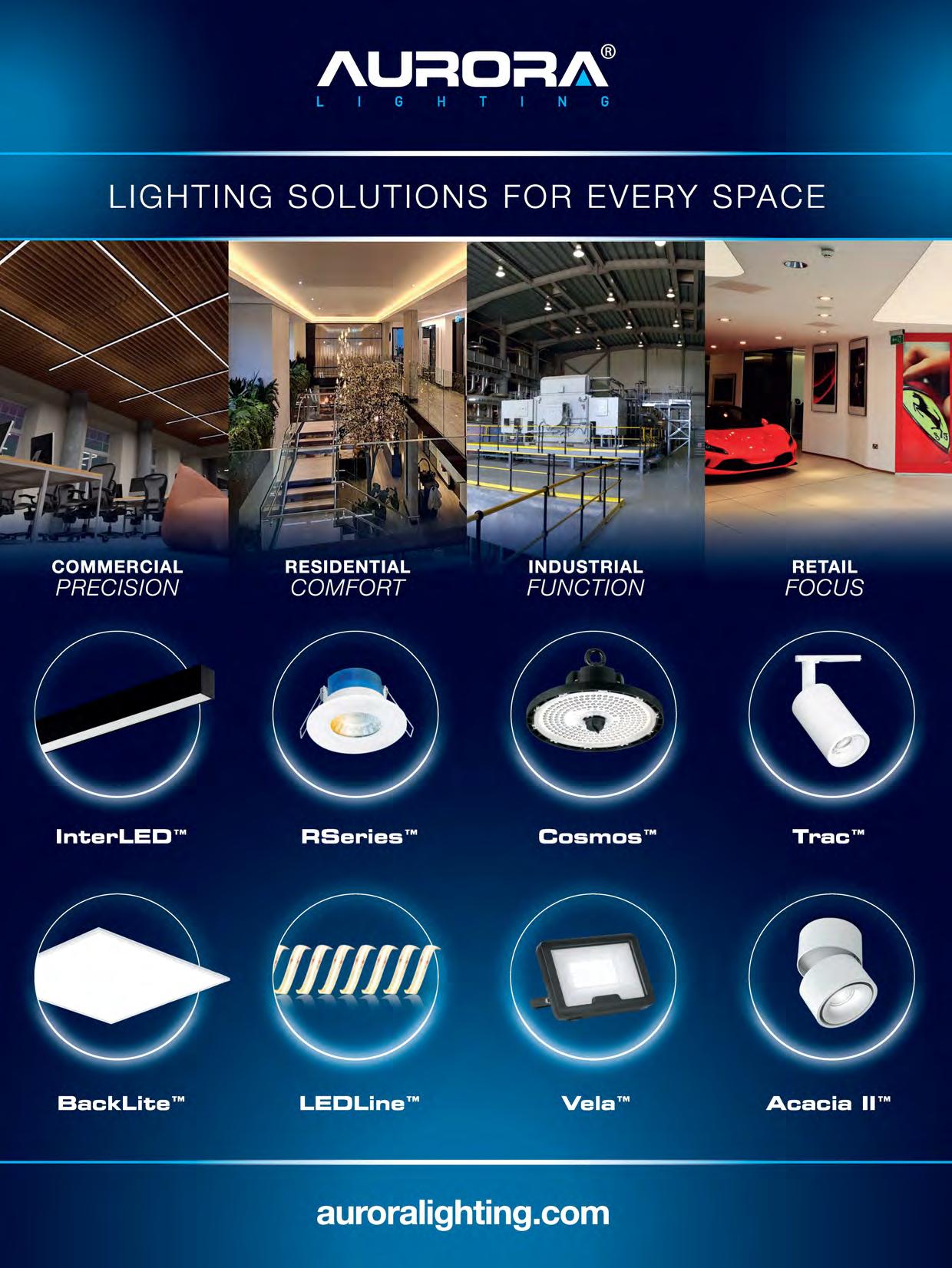
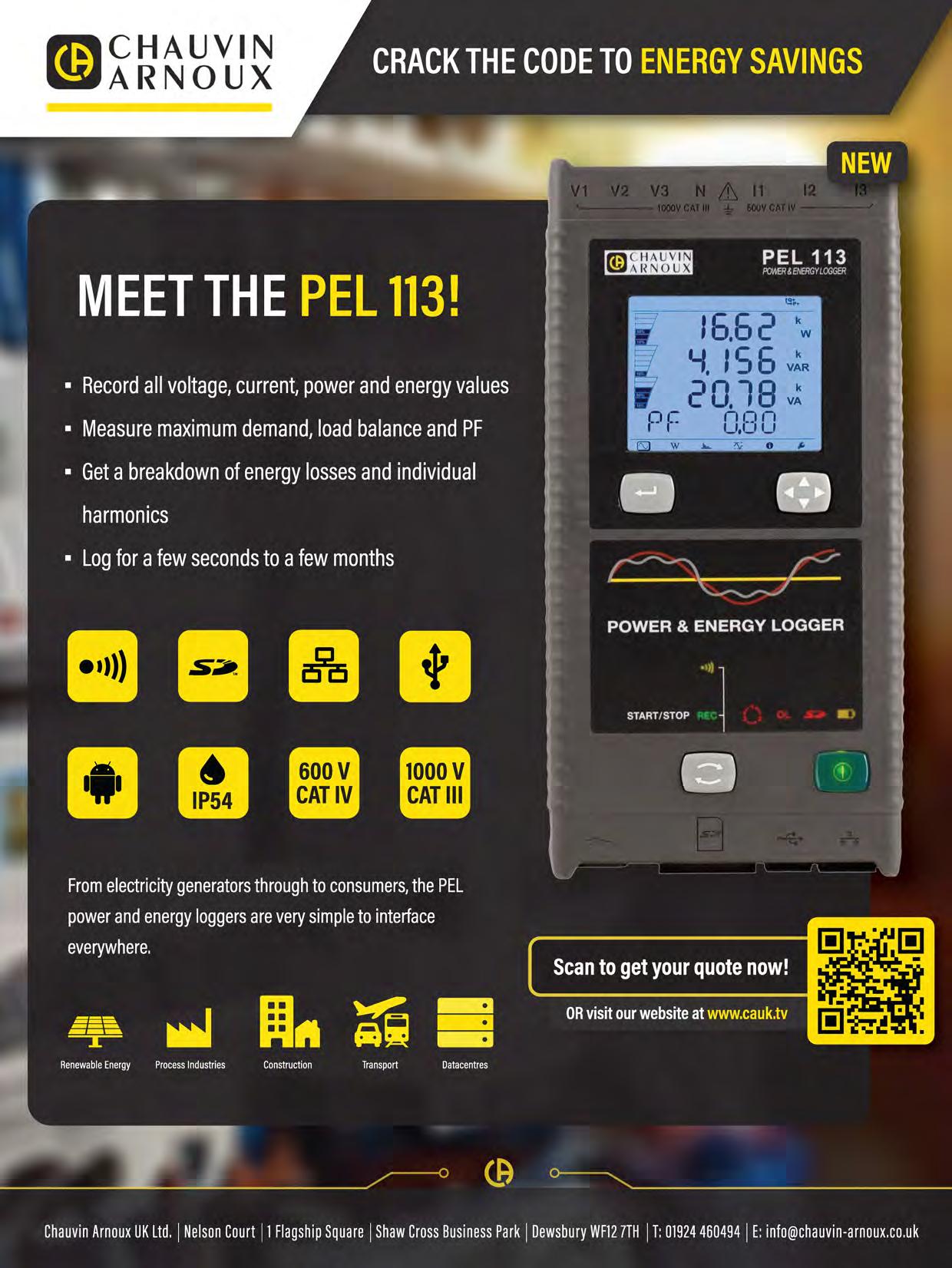



Carrying out a major house renovation and completing rewiring while the property is fully occupied isn't always easy. It can be more time-consuming than if the building were empty. This was the most challenging aspect for Green Hawk Construction at this house.
"Keeping the original power going for as long as possible and limiting the upheaval for the family was difficult," says Mike Humphries, electrician and Director of Green Hawk Construction in Leicestershire's village of Burbage. "The house had to be made safe at all times, which required careful planning."
The client wanted smart lighting throughout the house. So, to accommodate the Luceco smart lighting, Green Hawk removed the original wiring as it was considered sub-standard and too expensive to repair. They kept the original wiring in place for as long as possible and switched off the power in
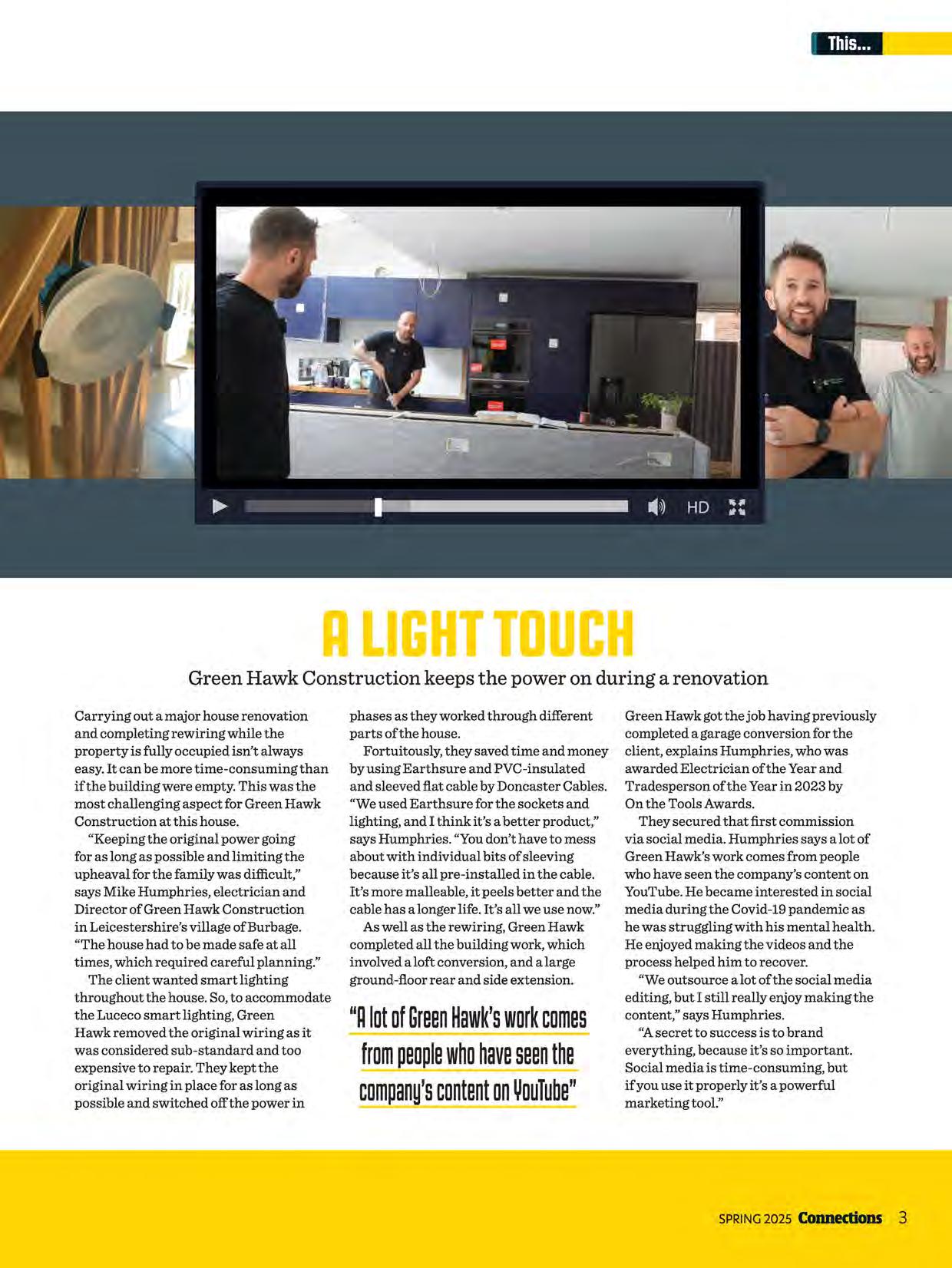
phases as they worked through different parts of the house.
Fortuitously, they saved time and money by using Earthsure and PVC-insulated and sleeved flat cable by Doncaster Cables. "We used Earthsure for the sockets and lighting, and I think it's a better product," says Humphries. "You don't have to mess about with individual bits of sleeving because it's all pre-installed in the cable. It's more malleable, it peels better and the cable has a longer life. It's all we use now."
As well as the rewiring, Green Hawk completed all the building work, which involved a loft conversion, and a large ground-floor rear and side extension.
Green Hawk got the job having previously completed a garage conversion for the client, explains Humphries, who was awarded Electrician of the Year and Tradesperson of the Year in 2023 by On the Tools Awards.
They secured that first commission via social media. Humphries says a lot of Green Hawk's work comes from people who have seen the company's content on YouTube. He became interested in social media during the Covid-19 pandemic as he was struggling with his mental health. He enjoyed making the videos and the process helped him to recover.
"We outsource a lot of the social media editing, but I still really enjoy making the content," says Humphries.
"AlotofGreenHawk'sworkcomes frompeoplewhohaveseenthe company'scontentonVouTube"
"A secret to success is to brand everything, because it's so important. Social media is time-consuming, but if you use it properly it's a powerful marketing tool."
There are some exciting changes and important updates highlighted in this issue of Connections. Paul Collins, NICEIC Technical Director, talks us through what we can expect and our top priorities for you

Self-certify certain types of building work
latest howlers
Why your NICEIC certification is good for business
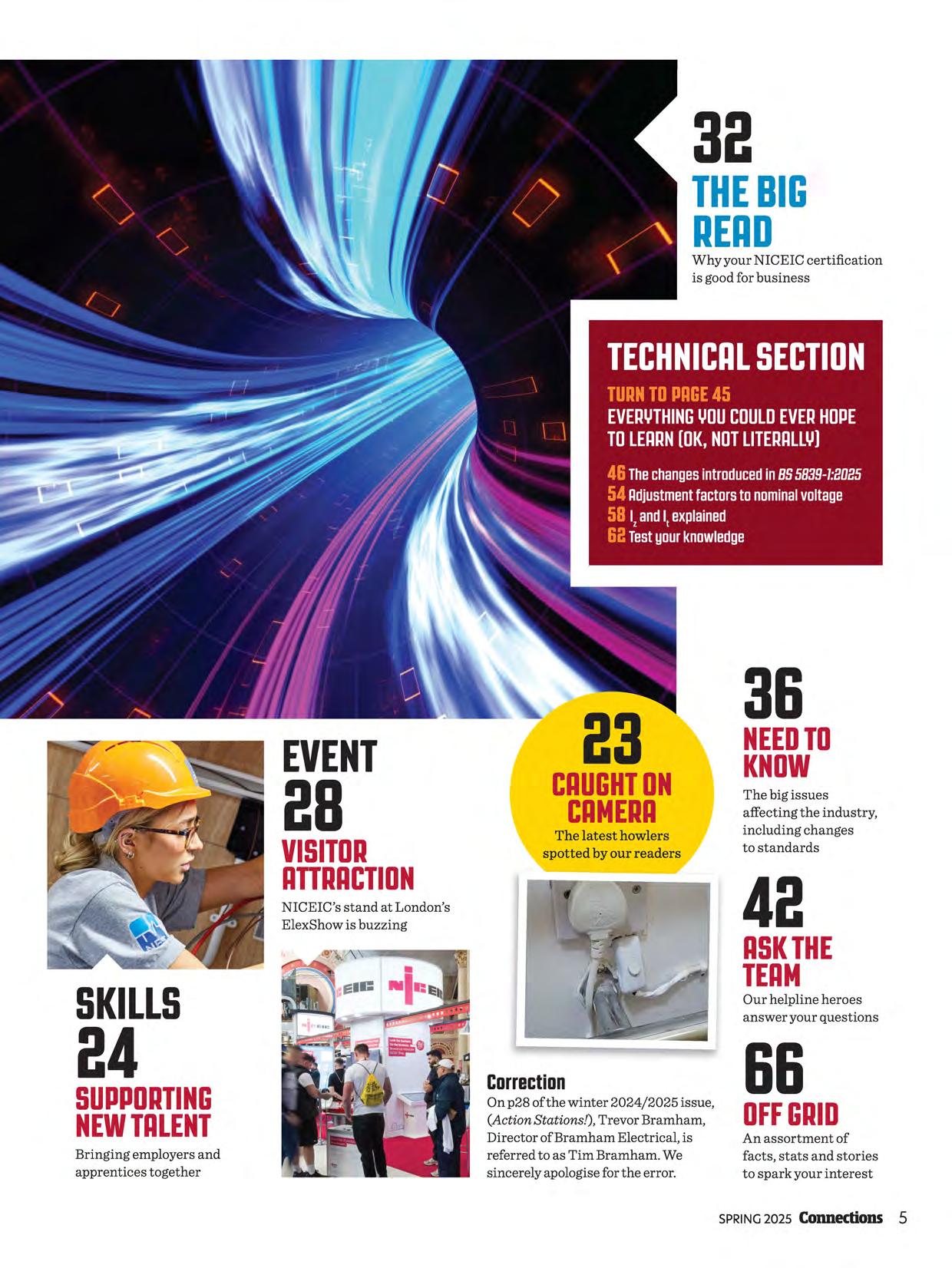
Bringing employers and apprentices together
NICEIC's stand at London's ElexShow is buzzing
' On p28 of the winter 2024/2025 issue, (Action Stations!), Trevor Bramham, Director of Bramham Electrical, is referred to as Tim Bramham. We sincerely apologise for the error.
The big issues affecting the industry, including changes to standards
Our helpline heroes answer your questions
An assortment of facts, stats and stories to spark your interest
Simple and intelligent, the 3000 Series provides whole property coverage. -
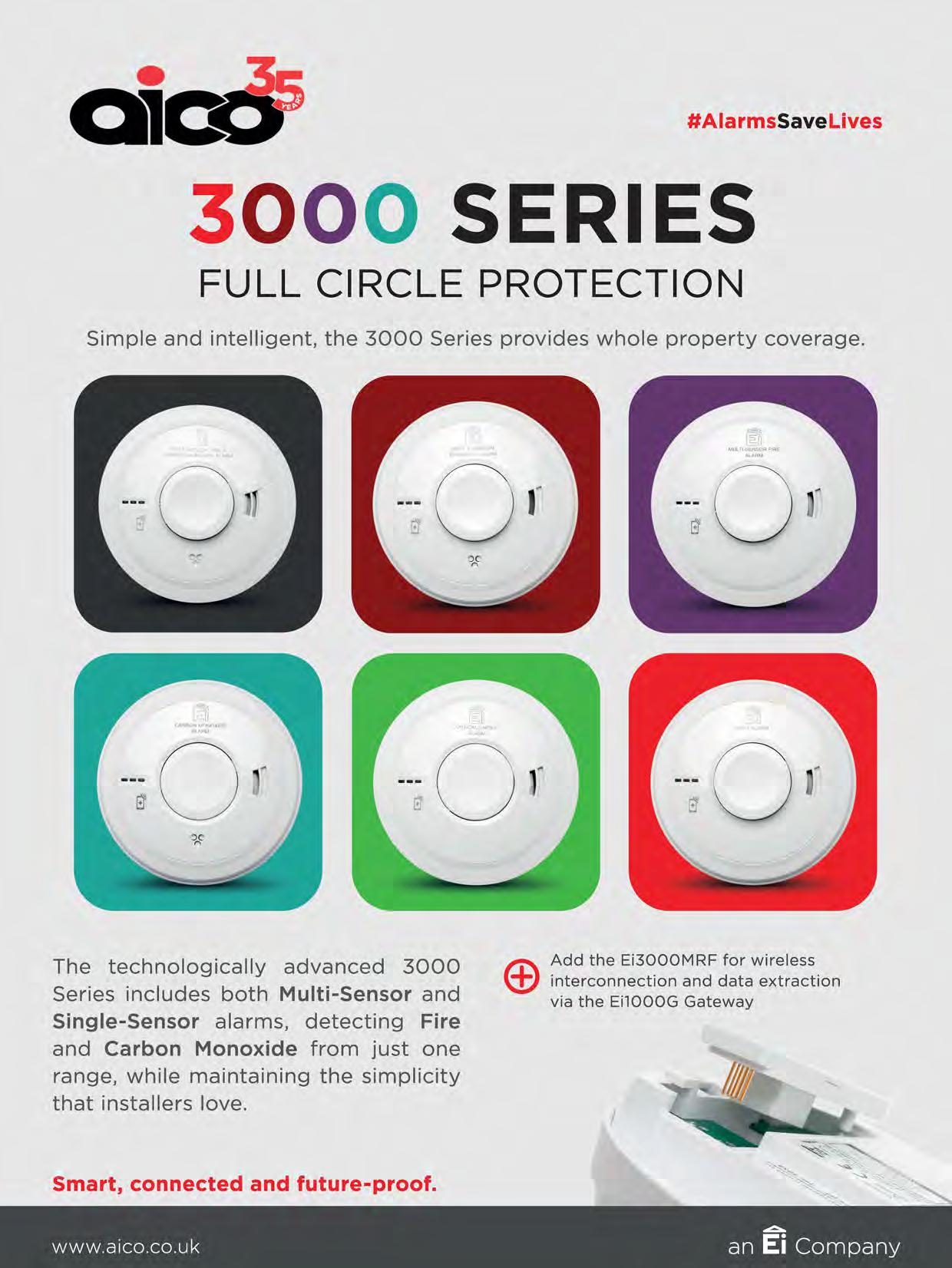
The technologically advanced 3000 Series includes both Multi-Sensor and Single-Sensor alarms, detecting Fire and CarbonMonoxide from just one range, while maintaining the simplicity that installers love. Smart,connectedandfuture-proof.
lL.\ Add the Ei3000MRF for wireless interconnection and data extraction via the Ei1000G Gateway
©2025
ISSN 2042-5732 niceic.com
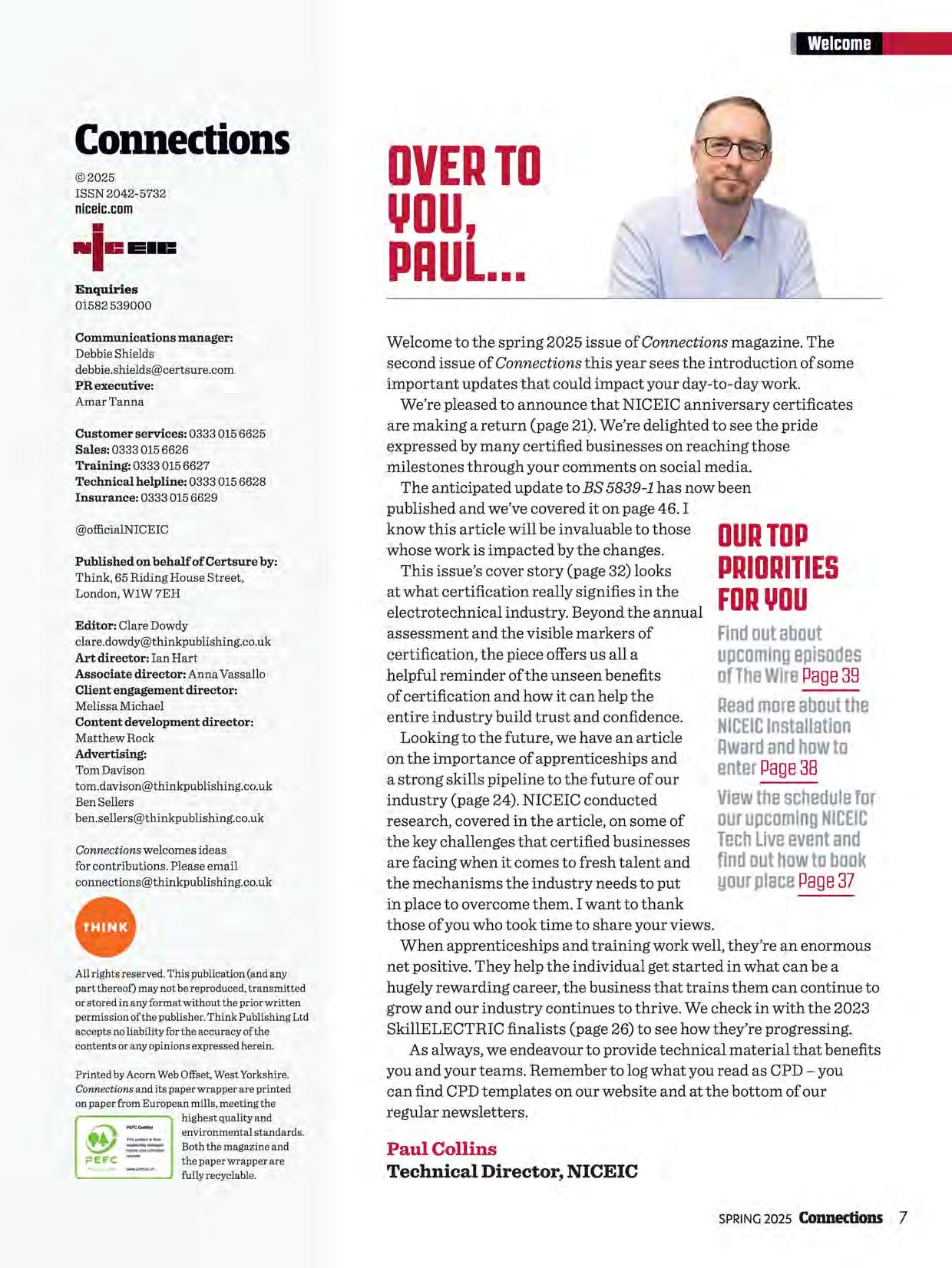
Enquiries
01582 539000
Communications manager: Debbie Shields
debbie.shields@certsure.com
PR executive: Amar Tanna
Customer services: 0333 015 6625
Sales: 0333 015 6626
Training: 0333 015 6627
Technical helpline: 0333 015 6628
Insurance: 0333 015 6629
@officialNICEIC
Published on behalf ofCertsure by: Think, 65 Riding House Street, London, WlW 7EH
Editor: Clare Dowdy
clare.dowdy@thinkpublishing.co.uk
Art director: Ian Hart
Associate director: Anna Vassallo
Client engagement director: Melissa Michael
Content development director: Matthew Rock
Advertising: Tom Davison
tom.davison@thinkpublishing.co.uk
Ben Sellers
ben.sellers@thinkpublishing.co.uk
Connections welcomes ideas for contributions. Please email connections@thinkpublishing.co.uk
All rights reserved. This publication (and any part thereof) may not be reproduced, transmitted or stored in any format without the prior written permission of the publisher. Think Publishing Ltd accepts no liability for the accuracy of the contents or any opinions expressed herein.
Printed by Acorn Web Offset, West Yorkshire. Connections and its paper wrapper are printed on paper from European mills, meeting the
highest quality and environmental standards. Both the magazine and the paper wrapper are fully recyclable.
Welcome to the spring 2025 issue of Connections magazine. The second issue of Connections this year sees the introduction of some important updates that could impact your day-to-day work
We're pleased to announce that NICEIC anniversary certificates are making a return (page 21). We're delighted to see the pride expressed by many certified businesses on reaching those milestones through your comments on social media. The anticipated update to BS 5839-1 has now been published and we've covered it on page 46. I know this article will be invaluable to those whose work is impacted by the changes. This issue's cover story (page 32) looks at what certification really signifies in the electrotechnical industry. Beyond the annual assessment and the visible markers of certification, the piece offers us all a helpful reminder of the unseen benefits of certification and how it can help the entire industry build trust and confidence. Looking to the future, we have an article on the importance of apprenticeships and a strong skills pipeline to the future of our industry (page 24). NICEIC conducted research, covered in the article, on some of the key challenges that certified businesses are facing when it comes to fresh talent and the mechanisms the industry needs to put in place to overcome them. I want to thank those of you who took time to share your views.
Findoutabout upcomingepisodes ofTheWirePage39
Readmoreaboutthe NICEICInstallation Awardandhowto enterPage38
Viewtheschedulefor ourupcomingNICEIC TechLiveeventand findouthowtobook yourplacePage37
When apprenticeships and training work well, they're an enormous net positive. They help the individual get started in what can be a hugely rewarding career, the business that trains them can continue to grow and our industry continues to thrive. We check in with the 2023 SkillELECTRIC finalists (page 26) to see how they're progressing. As always, we endeavour to provide technical material that benefits you and your teams. Remember to log what you read as CPD -you can find CPD templates on our website and at the bottom of our regular newsletters.
Paul Collins Technical Director, NICEIC
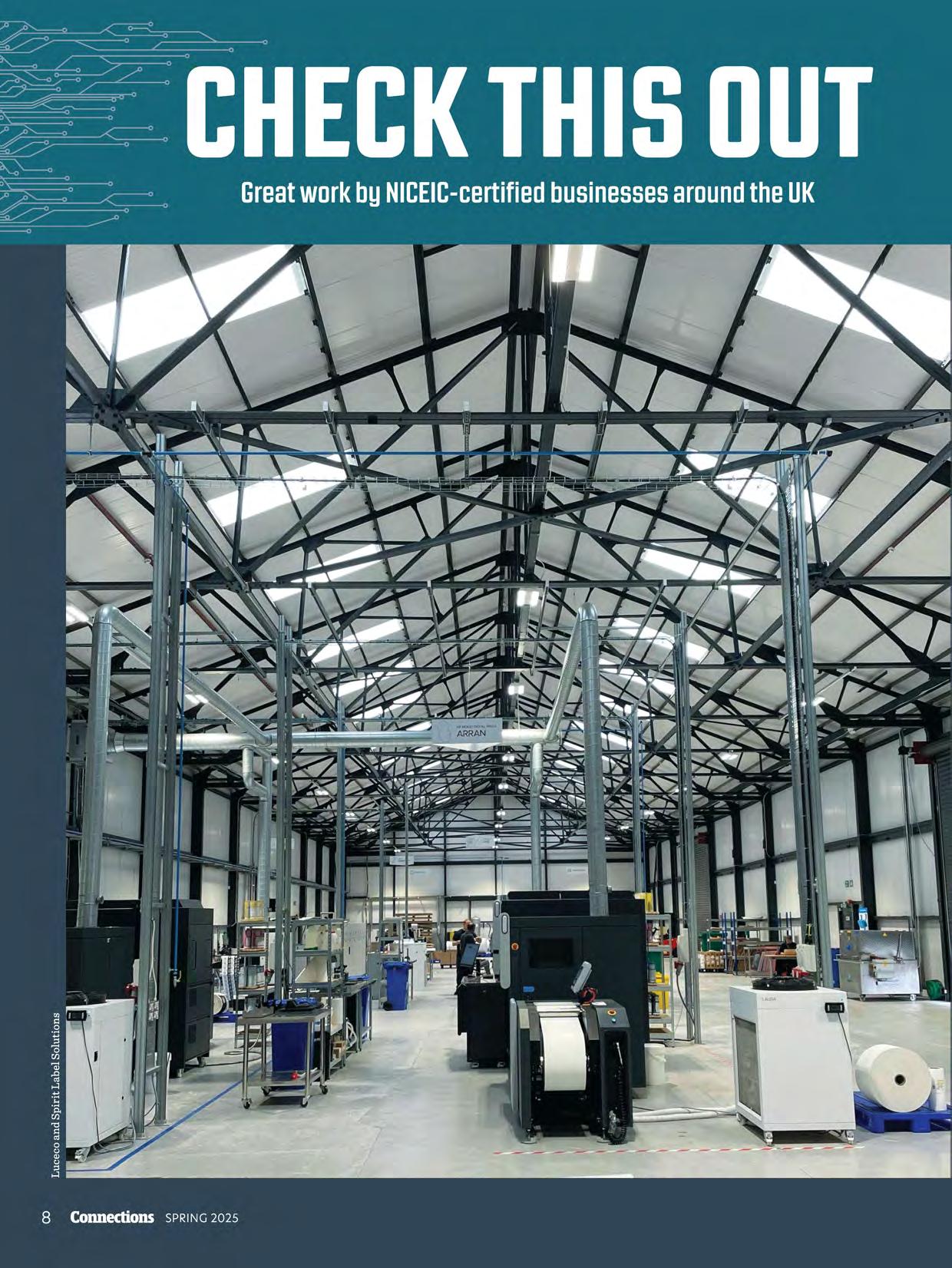
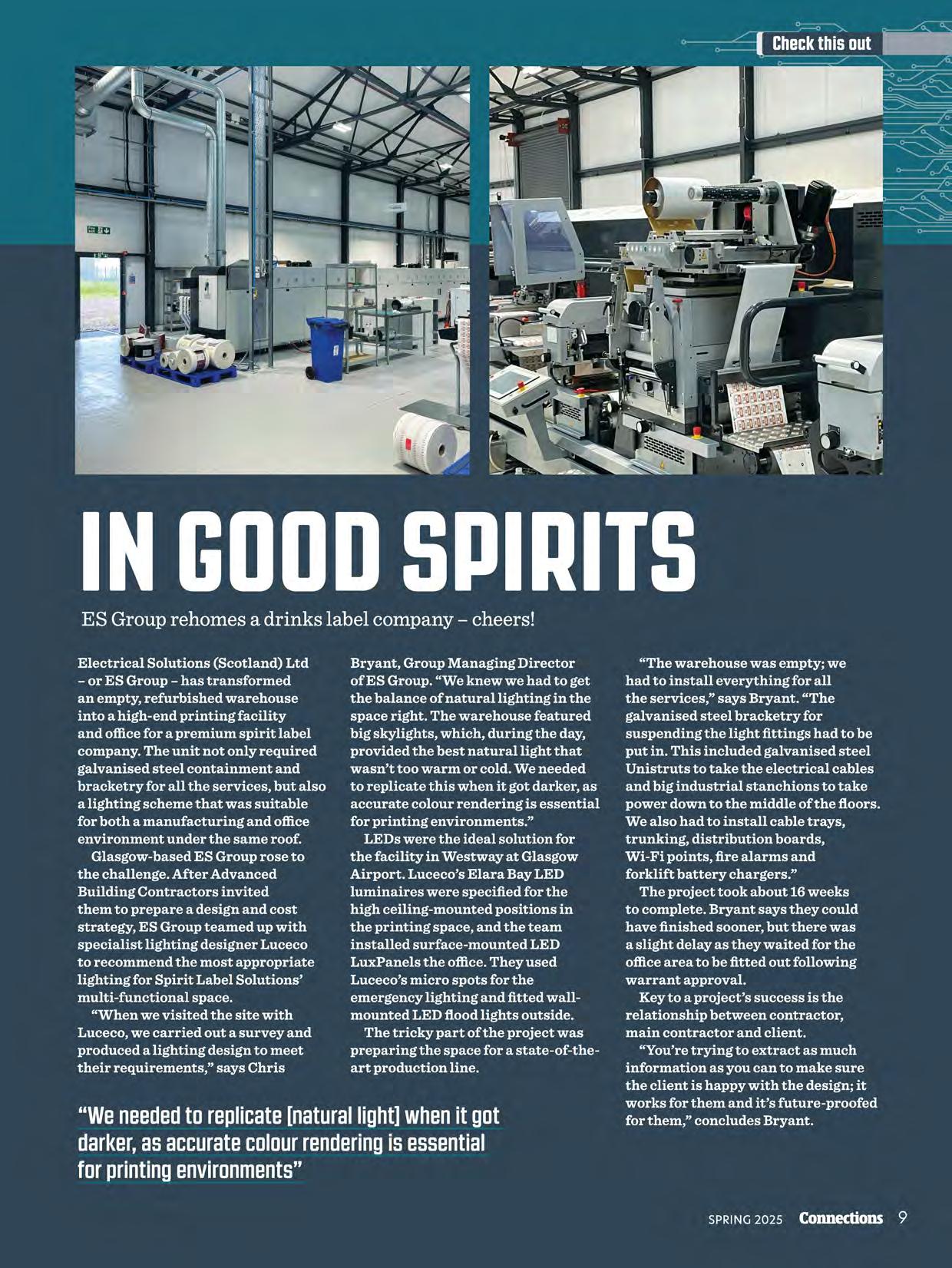
The completion of several operating theatres at Westmorland General Hospital in Kendal required an electrical contractor with the right skills and specialist healthcare experience. Lancaster-based Pinington skilfully handled the complex challenges of upgrading existing operating theatres and providing new ones, as well as constructing a four-storey extension to house the plant rooms and their cuttingedge technology.
"Working in a 'live' hospital, keeping existing services going and dealing with a phased handover to get the theatres operational was challenging," says Pinington Managing Director Thomas Pinington.
The 76-year-old family business was appointed in 2021 after tendering
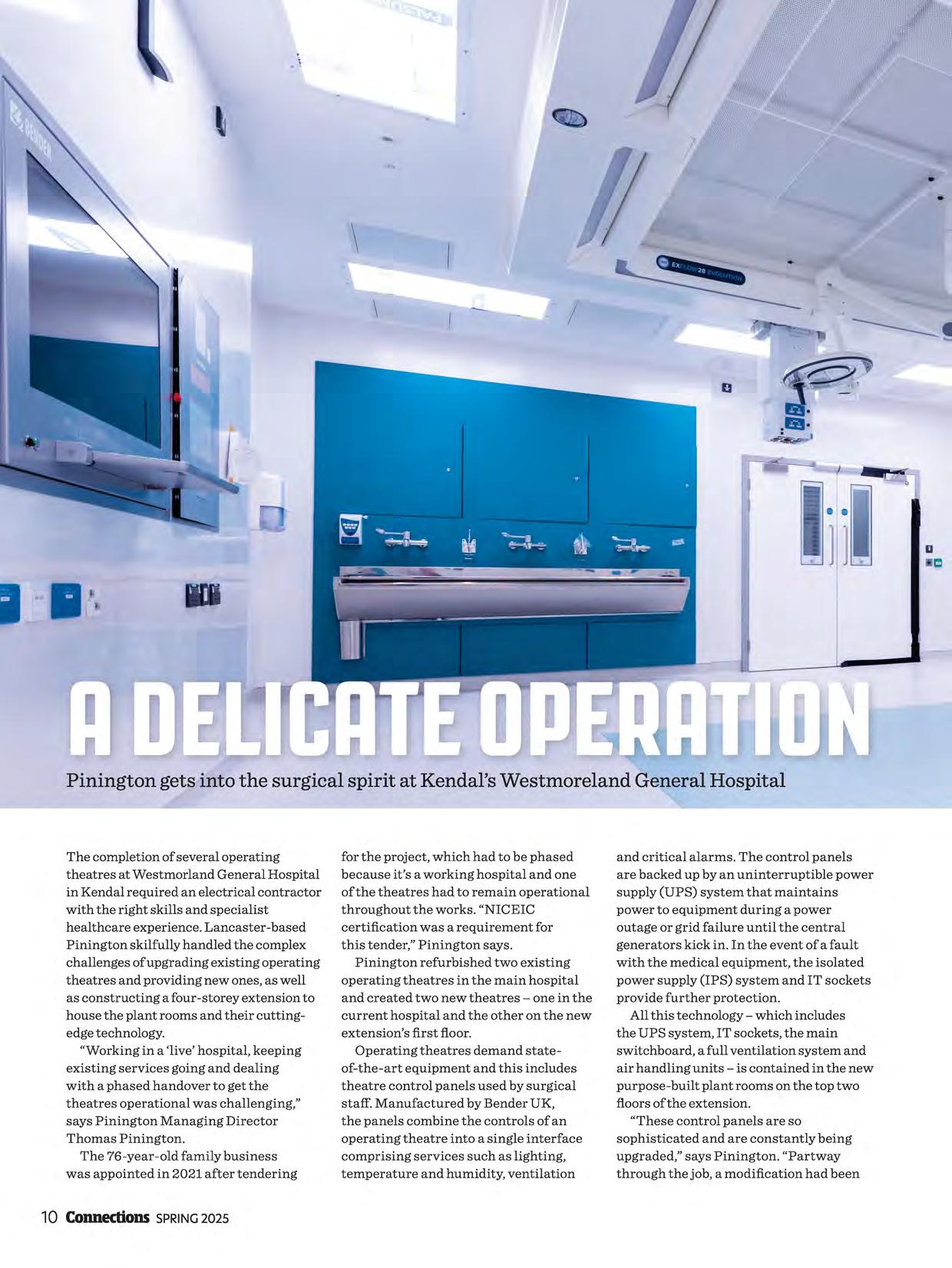
for the project, which had to be phased because it's a working hospital and one of the theatres had to remain operational throughout the works. "NICEIC certification was a requirement for this tender," Pinington says.
Pinington refurbished two existing operating theatres in the main hospital and created two new theatres -one in the current hospital and the other on the new extension's first floor.
Operating theatres demand stateof-the-art equipment and this includes theatre control panels used by surgical staff. Manufactured by Bender UK, the panels combine the controls of an operating theatre into a single interface comprising services such as lighting, temperature and humidity, ventilation
and critical alarms. The control panels are backed up by an uninterruptible power supply (UPS) system that maintains power to equipment during a power outage or grid failure until the central generators kick in. In the event of a fault with the medical equipment, the isolated power supply (IPS) system and IT sockets provide further protection.
All this technology -which includes the UPS system, IT sockets, the main switchboard, a full ventilation system and air handling units -is contained in the new purpose-built plant rooms on the top two floors of the extension.
"These control panels are so sophisticated and are constantly being upgraded," says Pinington. "Partway through the job, a modification had been

made to one of the control panels we had already installed. We then had to go back in and install extra control wires and have the panels recommissioned."
Pinington says that, given their expertise in this area, they understood how these specialist systems work and integrate with one another. They also understood the sequencing and commissioning of the equipment.
"It'sabigresponsibility ... everyoneunclerstancls the complexityancldelicateness ofworkinginlivehospitals" THOMASPININGTDN
The validation period for the theatre equipment is thorough and timeconsuming, involving many different specialists. Countless tests were carried out on the UPS and IPS equipment, as well as air tests, the commissioning of pressure testing and medical gas testing. The hospital's validators also had to conduct witness checks.
"It's a big responsibility for contractors and operatives on-site, and everyone understands the complexity and delicateness of working in live hospitals," says Pinington. "Our time was quite pressured and we would sometimes have to work through the night, but our electricians get a lot of job satisfaction from it. After all, they're doing things that are essentially saving people's lives."
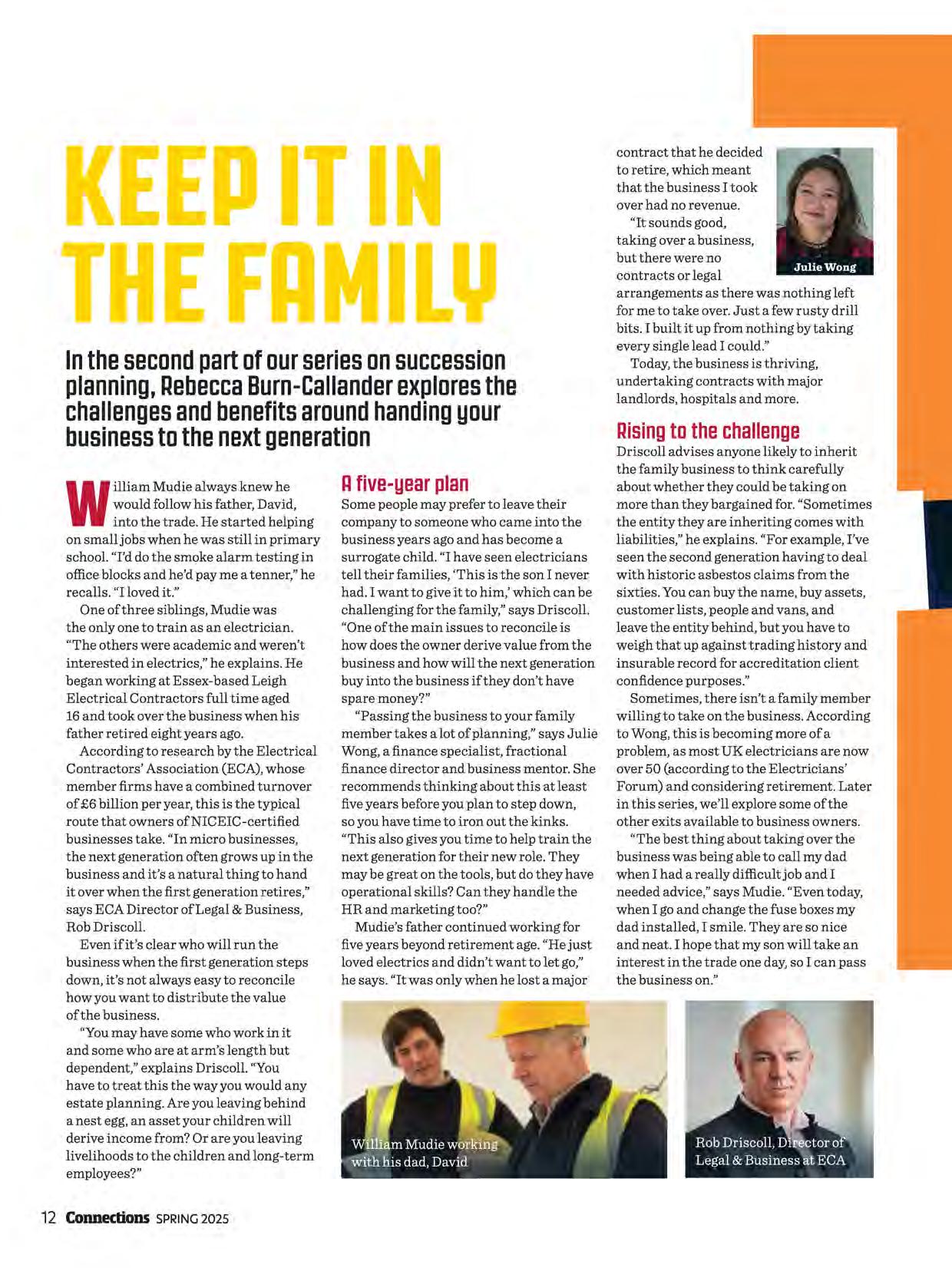
Inthesecondpartofourseriesonsuccession planning,RebeccaBurn-Callanderexploresthe challengesandbenefitsaroundhandingyour businesstothenextgeneration
William Mudie always knew he would follow his father, David, into the trade. He started helping on small jobs when he was still in primary school. ''I'd do the smoke alarm testing in office blocks and he'd pay me a tenner," he recalls. "I loved it."
One of three siblings, Mudie was the only one to train as an electrician. "The others were academic and weren't interested in electrics," he explains. He began working at Essex-based Leigh Electrical Contractors full time aged 16 and took over the business when his father retired eight years ago.
According to research by the Electrical Contractors' Association (ECA), whose member firms have a combined turnover of £6 billion per year, this is the typical route that owners ofNICEIC-certified businesses take. "In micro businesses, the next generation often grows up in the business and it's a natural thing to hand it over when the first generation retires," says ECA Director of Legal & Business, Rob Driscoll.
Even if it's clear who will run the business when the first generation steps down, it's not always easy to reconcile how you want to distribute the value of the business.
"You may have some who work in it and some who are at arm's length but dependent," explains Driscoll. "You have to treat this the way you would any estate planning. Are you leaving behind a nest egg, an asset your children will derive income from? Or are you leaving livelihoods to the children and long-term employees?"
Some people may prefer to leave their company to someone who came into the business years ago and has become a surrogate child. "I have seen electricians tell their families, 'This is the son I never had. I want to give it to him,' which can be challenging for the family,'' says Driscoll. "One of the main issues to reconcile is how does the owner derive value from the business and how will the next generation buy into the business if they don't have spare money?"
"Passing the business to your family member takes a lot of planning,'' says Julie Wong, a finance specialist, fractional finance director and business mentor. She recommends thinking about this at least five years before you plan to step down, so you have time to iron out the kinks. "This also gives you time to help train the next generation for their new role. They may be great on the tools, but do they have operational skills? Can they handle the HR and marketing too?"
Mudie's father continued working for five years beyond retirement age. "He just loved electrics and didn't want to let go," he says. "It was only when he lost a major
contract that he decided to retire, which meant that the business I took over had no revenue.
"It sounds good, taking over a business, but there were no contracts or legal arrangements as there was nothing left for me to take over. Just a few rusty drill bits. I built it up from nothing by taking every single lead I could."
Today, the business is thriving, undertaking contracts with major landlords, hospitals and more.
Driscoll advises anyone likely to inherit the family business to think carefully about whether they could be taking on more than they bargained for. "Sometimes the entity they are inheriting comes with liabilities," he explains. "For example, I've seen the second generation having to deal with historic asbestos claims from the sixties. You can buy the name, buy assets, customer lists, people and vans, and leave the entity behind, but you have to weigh that up against trading history and insurable record for accreditation client confidence purposes."
Sometimes, there isn't a family member willing to take on the business. According to Wong, this is becoming more of a problem, as most UK electricians are now over 50 (according to the Electricians' Forum) and considering retirement. Later in this series, we'll explore some of the other exits available to business owners.
"The best thing about taking over the business was being able to call my dad when I had a really difficult job and I needed advice," says Mudie. "Even today, when I go and change the fuse boxes my dad installed, I smile. They are so nice and neat. I hope that my son will take an interest in the trade one day, so I can pass the business on."
"Inmicrobusinesses, thenextgeneration oftengrowsupin thebusiness"
ROBDRISCOLL,ECADIRECTOR OFLEGAL 6 BUSINESS
ECAhasset upa Growth
Hubfor ECAmembersto undertake a journeyto betterbusinessacumen andmanagement. eca.co.uk/membersupport/growth-hub
1.Avoidthefamilydrama
Communication is keyto aneasy transition.Makethe lineof succession clearto all stakeholdersandexplain why[if necessary],makingsureother familymembersdon'tfeelsidelined.
i!. Financialplanning
Speakto a tax expertastheremaybe considerationsaroundcapitalgains tax, inheritancetax and- in thewake of the2024Budget-changesto BusinessPropertyRelief.
3.Doahandover
Makesureyouputthenextgeneration ona trainingpathsotheycanhandle everyaspectof runningyourbusiness -money,people,marketing,risk, pricingetc.Ensureyouhaveall the rightagreements in placefor the transferof assetsandproperty. Accordingto Driscoll,youusually don'thavethe rightto transferongoing contracts,butif youworkproactively with yourclients,youcanmigrate themfrombusinessAto businessB.
4.Preparetogetemotional
Evenwhenyourrationalmindknows it's therighttimeto handoverthe reins,takinga stepbackfromthe businessyouhavenurturedfor many yearscanbechallenging.Prepare to runthegamutof emotionsfrom reliefto fear,excitementto dread. Aphasedtransitioncanhelpto easethe process,ascantaking upa consultancyrole.
5.Areyouhandingovermoreliabilities thanassets?
!Joucanpassontools,fleet,customers andassetswithoutpassingonthe companyitself if therearelegacy issuesthat couldaffectfuture success.
Nexttime,we'llfocusonsellingyour business. If youhaveanypersonal storiesto shareaboutthis,email connections@thinkpublishing.co.uk
DavidAdamsexplains thevalueofmentoring andtheneedto createprofessional friendships

Most ofus can remember someone who really helped us early on in our careers. In the electrical services industry, as in many other trades, that person is likely to have been a colleague who acted effectively as a kind of mentor, providing one-to-one training.
The need for such support is arguably more urgent than ever before, with the industry facing a huge skills shortage. Mentoring enables experienced people to pass their knowledge on to the next generation of electricians. That could make a huge difference to their future, to their employers' prospects and to the future of the industry.
Professor David Clutterbuck is cofounder of the European Mentoring and Coaching Council and a visiting professor at institutions including Henley Business School. Whatever your line of work, he says, "it's valuable to pause and think about where you are in your career with somebody who's further down the path."
As well as helping those at the start of their career, Clutterbuck advocates ongoing mentoring for individuals further on with their careers. He recommends basing it on regular one-to-one meetings every few weeks, somewhere quiet or perhaps while going for a walk. "It needs to be somewhere where you can just be yourself," he says.
He stresses the need for mentors to be honest about their own experiences. "When the mentor talks about their own mistakes, that's one of the things you learn from most," he says.
Clutter buck thinks mentoring is easier with a larger company, but many NICEICcertified businesses use mentoring in some form. Darke & Taylor in Oxfordshire was founded by two electricians 67 years ago. Today, it provides a range of electrical, mechanical and other building services to commercial and domestic
clients, and has 283 employees, including 91 apprentices. Many ofits employees, including 80% of current board members, joined the company as apprentices.
Every Darke & Taylor apprentice works one-on-one with a more senior employee who acts as a mentor. Josh Boyes is in the third year of his apprenticeship at Darke & Taylor and spent his first two years being mentored by Site Supervisor Stuart Pinney.
"I've learned everything directly from him, which I think is a better way of doing it, rather than working my way round different mentors," he says. "We've got that bond where, ifI ever have any problems, I'm not afraid to ask him."
As has been the case with many of the apprentices passing through the system, this partnership has also become a friendship, helping to strengthen company culture, as well as allowing Boyes to get the most out of his apprenticeship, which he says he has really enjoyed so far.
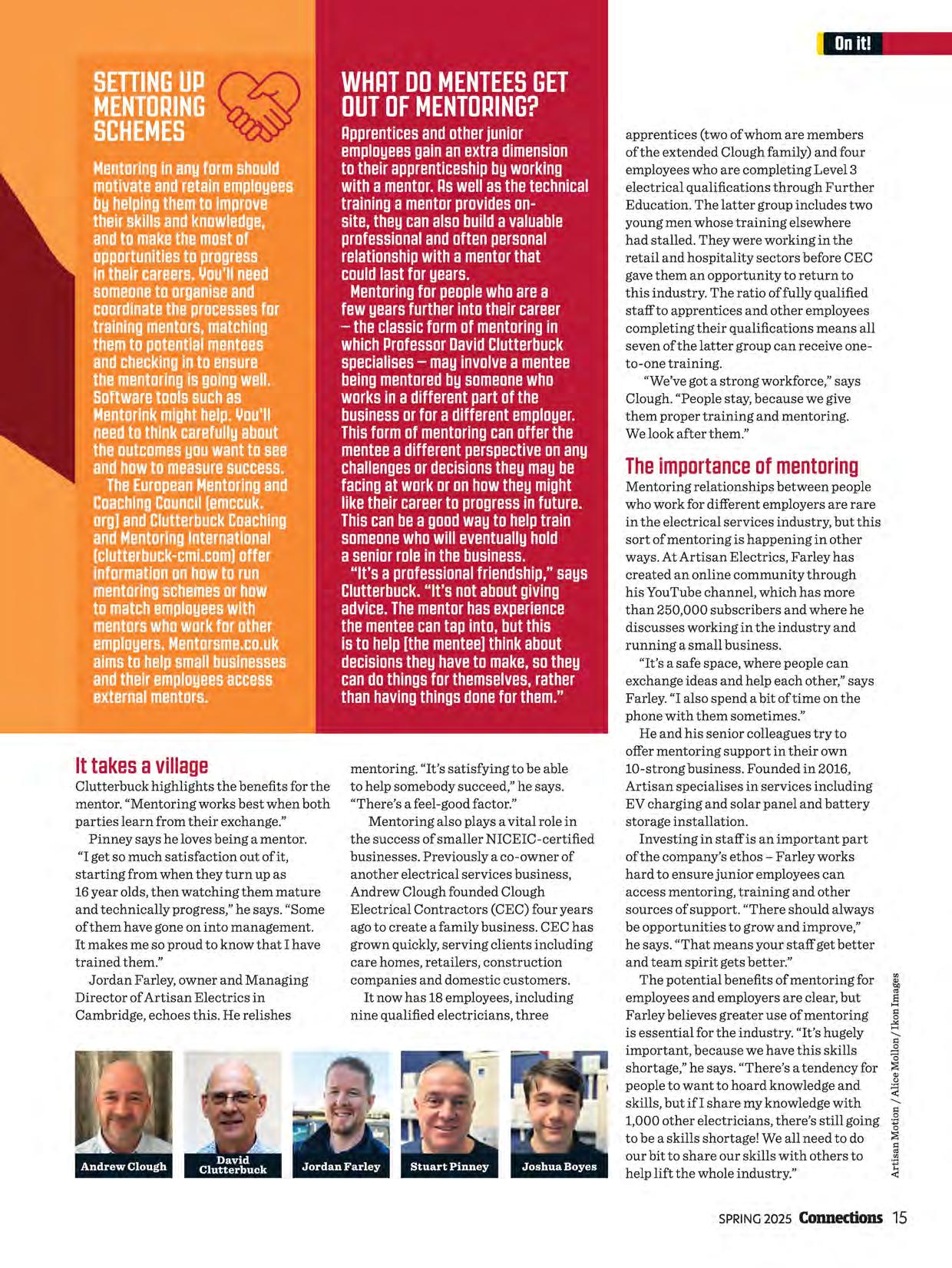
Clutter buck highlights the benefits for the mentor. "Mentoring works best when both parties learn from their exchange."
Pinney says he loves being a mentor. "I get so much satisfaction out ofit, starting from when they turn up as 16 year olds, then watching them mature and technically progress," he says. "Some of them have gone on into management. It makes me so proud to know that I have trained them."
Jordan Farley, owner and Managing Director of Artisan Electrics in Cambridge, echoes this. He relishes
Apprenticesandotherjunior employeesgainanextradimension totheirapprenticeshipbyworking withamentor.Aswellasthetechnical trainingamentorprovidesonsite,theycanalsobuildavaluable professionalandoftenpersonal relationshipwithamentorthat couldlastforyears.
Mentoringforpeoplewhoarea fewyearsfurtherintotheircareer - theclassicformofmentoring in whichProfessorDavidClutterbuck specialises-mayinvolveamentee beingmentoredbysomeonewho worksinadifferentpartofthe businessorforadifferentemployer. Thisformofmentoringcanofferthe menteeadifferentperspectiveonany challengesordecisionstheymaybe facingatworkoronhowtheymight liketheircareertoprogressinfuture. Thiscanbeagoodwaytohelptrain someonewhowilleventuallyhold aseniorroleinthebusiness.
"It'saprofessionalfriendship,"says Clutterbuck."It'snotaboutgiving advice.Thementorhasexperience thementeecantapinto,butthis istohelp[thementee]thinkabout decisionstheyhavetomake,sothey candothingsforthemselves,rather thanhavingthingsdoneforthem."
mentoring. "It's satisfying to be able to help somebody succeed," he says. "There's a feel-good factor."
Mentoring also plays a vital role in the success of smaller NICEIC-certified businesses. Previously a co-owner of another electrical services business, Andrew Clough founded Clough Electrical Contractors (CEC) four years ago to create a family business. CEC has grown quickly, serving clients including care homes, retailers, construction companies and domestic customers. It now has 18 employees, including nine qualified electricians, three
apprentices (two of whom are members of the extended Clough family) and four employees who are completing Level 3 electrical qualifications through Further Education. The latter group includes two young men whose training elsewhere had stalled. They were working in the retail and hospitality sectors before CEC gave them an opportunity to return to this industry. The ratio offully qualified staff to apprentices and other employees completing their qualifications means all seven of the latter group can receive oneto-one training.
"We've got a strong workforce," says Clough. "People stay, because we give them proper training and mentoring. We look after them."
Mentoring relationships between people who work for different employers are rare in the electrical services industry, but this sort of mentoring is happening in other ways. At Artisan Electrics, Farley has created an online community through his YouTube channel, which has more than 250,000 subscribers and where he discusses working in the industry and running a small business.
"It's a safe space, where people can exchange ideas and help each other," says Farley. "I also spend a bit of time on the phone with them sometimes."
He and his senior colleagues try to offer mentoring support in their own 10-strong business. Founded in 2016, Artisan specialises in services including EV charging and solar panel and battery storage installation.
Investing in staff is an important part ofthe company's ethos -Farley works hard to ensure junior employees can access mentoring, training and other sources of support. "There should always be opportunities to grow and improve," he says. "That means your staff get better and team spirit gets better."
The potential benefits of mentoring for employees and employers are clear, but Farley believes greater use of mentoring is essential for the industry. "It's hugely important, because we have this skills
shortage," he says. "There's a tendency for
people to want to hoard knowledge and skills, but ifI share my knowledge with -;;1,000 other electricians, there's still going
to be a skills shortage! We all need to do
our bit to share our skills with others to help lift the whole industry."
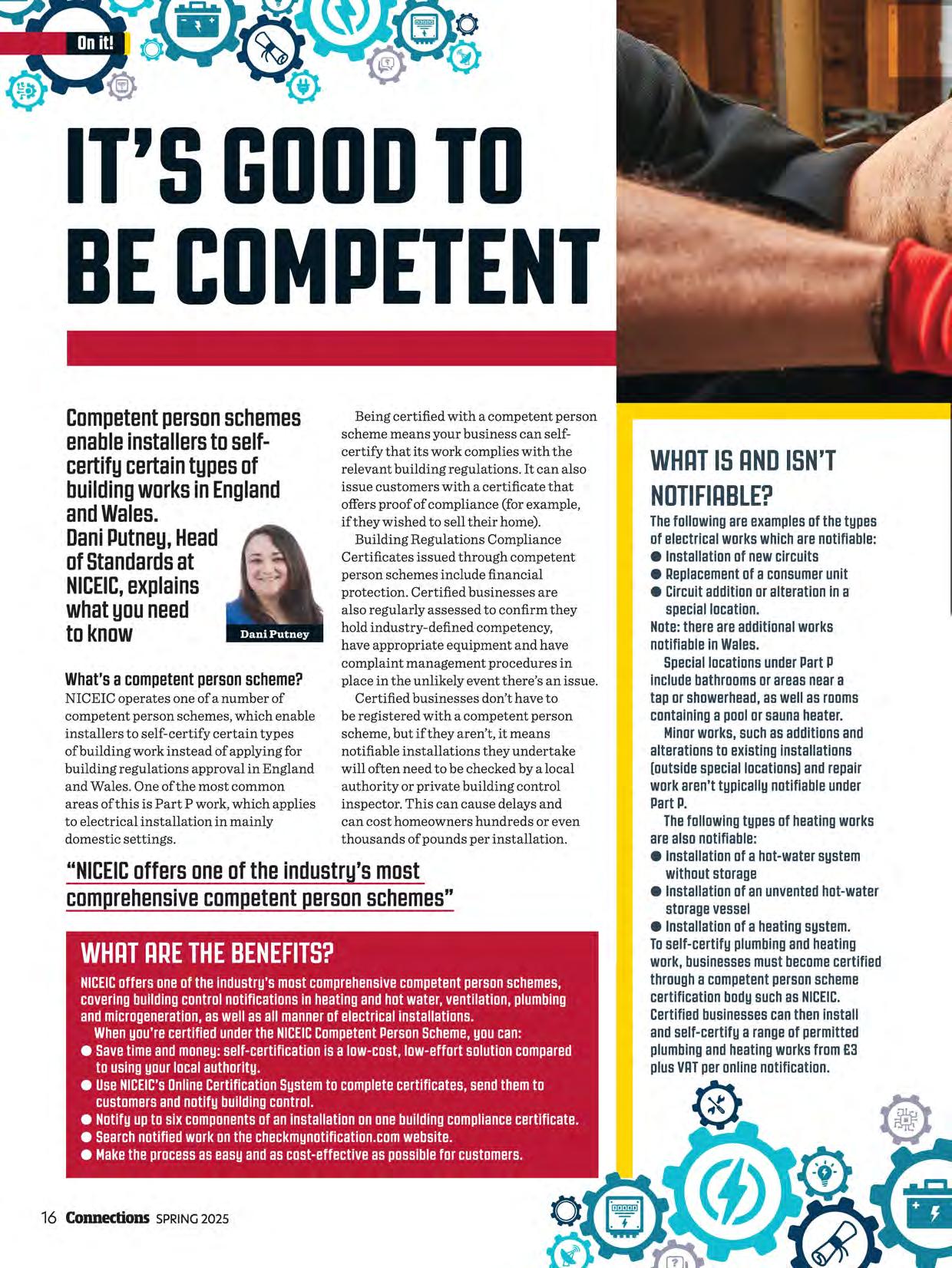
Competentpersonschemes enableinstallerstoselfcertifycertaintypesof buildingworksinEngland andWales.
DaniPutney,Head ofStandards at NICEIC,explains whatyouneed toknow
What'sacompetentpersonscheme?
NICEIC operates one of a number of competent person schemes, which enable installers to self-certify certain types of building work instead of applying for building regulations approval in England and Wales. One of the most common areas of this is Part P work, which applies to electrical installation in mainly domestic settings.
Being certified with a competent person scheme means your business can selfcertify that its work complies with the relevant building regulations. It can also issue customers with a certificate that offers proof of compliance (for example, if they wished to sell their home).
Building Regulations Compliance Certificates issued through competent person schemes include financial protection. Certified businesses are also regularly assessed to confirm they hold industry-defined competency, have appropriate equipment and have complaint management procedures in place in the unlikely event there's an issue. Certified businesses don't have to be registered with a competent person scheme, but if they aren't, it means notifiable installations they undertake will often need to be checked by a local authority or private building control inspector. This can cause delays and can cost homeowners hundreds or even thousands of pounds per installation.
"NICEICoffersoneoftheindustry'smost comprehensivecompetentpersonschemes"
NICEICoffersoneof the industry'smostcomprehensivecompetentpersonschemes, coveringbuildingcontrolnotificationsin heatingandhot water,ventilation,plumbing andmicrogeneration,aswell as all mannerof electricalinstallations. Whenyou'recertifiedunderthe NICEICCompetentPersonScheme,youcan:
• Savetimeandmoney:self-certificationis a low-cost,low-effortsolutioncompared to usingyourlocalauthority.
• UseNICEIC'sOnlineCertificationSystemto completecertificates,sendthemto customersandnotify buildingcontrol.
• Notifyupto six componentsof aninstallationononebuildingcompliancecertifi
• Searchnotifiedworkonthe checkmynotification.comwebsite.
• Makethe processas easyandas cost-effectiveas possiblefor customers.
Thefollowingareexamplesof the types of electricalworkswhicharenotifiable:
• Installationof newcircuits
• Replacement of a consumerunit
• Circuitadditionor alterationin a speciallocation. Note:thereareadditionalworks notifiablein Wales.
SpeciallocationsunderPartP includebathroomsor areasneara tap or showerhead,aswell as rooms containinga poolor saunaheater. Minorworks,suchas additionsand alterationsto existinginstallations [outsidespeciallocations)andrepair workaren'ttypicallynotifiableunder PartP.
Thefollowingtypesof heatingworks arealsonotifiable:
• Installationof a hot-watersystem withoutstorage
• Installationof anunventedhot-water storagevessel
• Installationof a heatingsystem. Toself-certifyplumbingandheating work,businessesmustbecomecertified througha competentpersonscheme certificationbodysuchas NICEIC. Certifiedbusinessescantheninstall andself-certifya rangeof permitted plumbingandheatingworksfrom£3 plusVATperonlinenotification.
I'minstallinga photovoltaic[PV] system-whereshould I notifythis?
Weoftenget askecll:Jycertifiedbusinesseswhere they neeclta notify their energy-efficientinstallations, includingPVsystems.
IJaumustnotify PVinstallations:
1.Withyourlocalbuildingcontrolauthority
Wheninstallinga PVsystem,youmustnotify the installationaf a newcircuitanclthe solarPVsystem.IJau canclathis throughNICEIC'sOnlineCertificationSystem. Whilethere'scurrentlynarequirementta notify the installationaf electricalenergystoragesystems[EESSJ, this is expectedta becamemanclataryl:Jythe enclaf 8085.
2. With MCS
BusinessescertifiedanNICEIC'sMCSSchemewill also haveaccessta the MCSInstallationDatabase[certificate. microgeneratiancertificatian.arg),wherethey cancreate MCScertificates,whichprovidehomeownerswith the evidencerequiredta accessmanyfundingmechanisms. BathPVanclEESSsystemsmustIle natifieclta MCS.
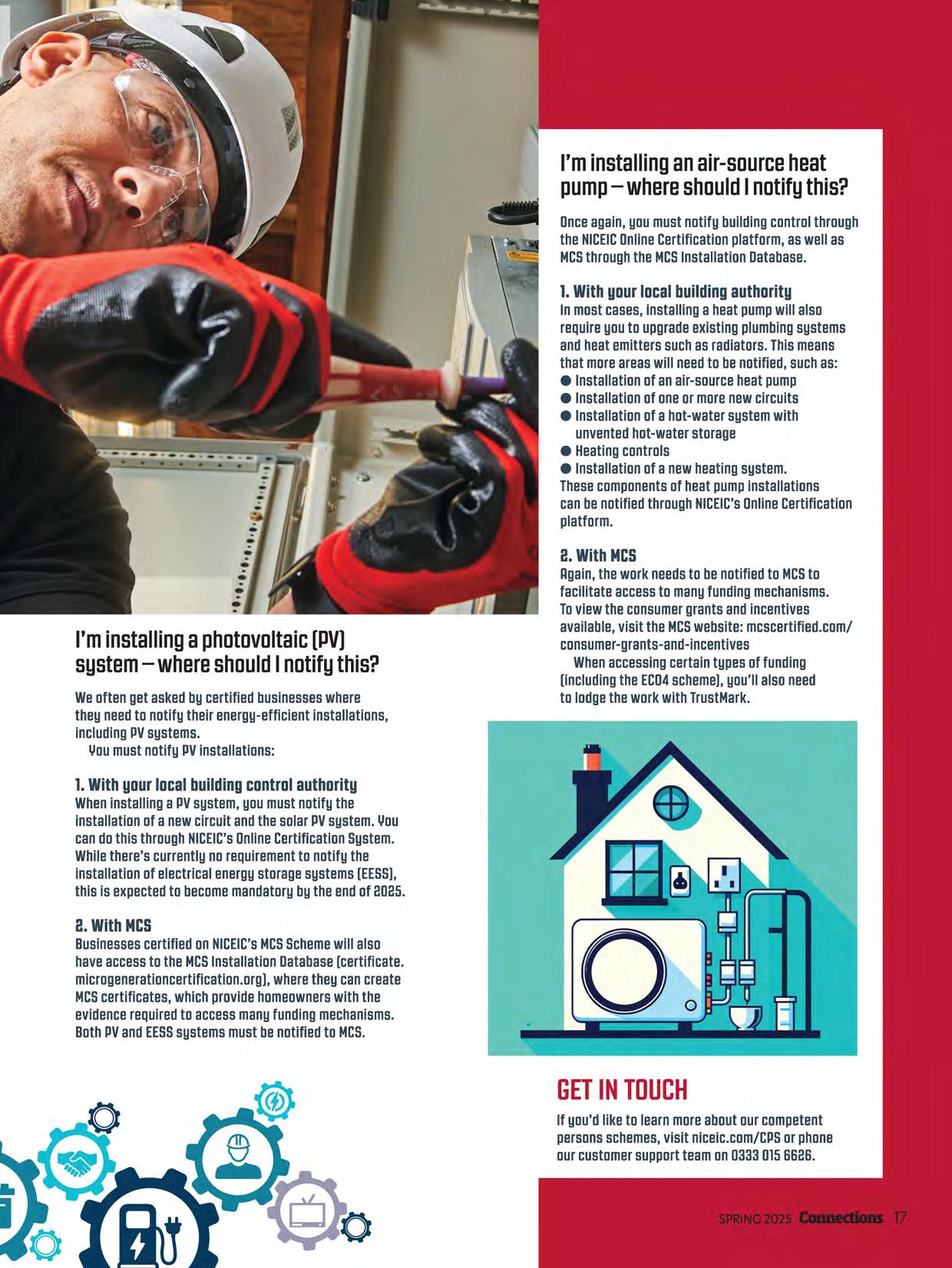
I'minstallinganair-sourceheat pump-whereshould I notifythis?
Onceagain,youmustnotify l:Juilclingcontrolthrough the NICEICOnlineCertificationplatform,aswell as MCSthroughthe MCSInstallationDatabase.
1.Withyourlocalbuildingauthority
In mastcases,installinga heatpumpwill also requireyouta upgradeexistingplumbingsystems anclheatemitterssuchas racliatars.Thismeans that mareareaswill neeclta Ile natifiecl,suchas:
• Installationaf anair-sourceheatpump
• Installationaf onear marenewcircuits
• Installationaf a hat-watersystemwith unventeclhat-waterstorage
• Heatingcontrols
• Installationaf a newheatingsystem. Thesecomponentsaf heatpumpinstallations canIle natifieclthroughNICEIC'sOnlineCertification platform.
2.WithMCS
Again,the workneeclsta Ile natifieclta MCSta facilitateaccessta manyfundingmechanisms. Taviewthe consumergrantsanclincentives available,visit the MCSwebsite:mcscertifiecl.cam/ cansumer-grants-ancl-incentives Whenaccessingcertaintypesaf funding [includingthe ECD4scheme),you'llalsoneecl ta laclgethe workwith TrustMark.
If yau'clliketa learnmareal:Jautourcompetent personsschemes,visit niceic.cam/CPS ar phone ourcustomersupportteaman03330156686.
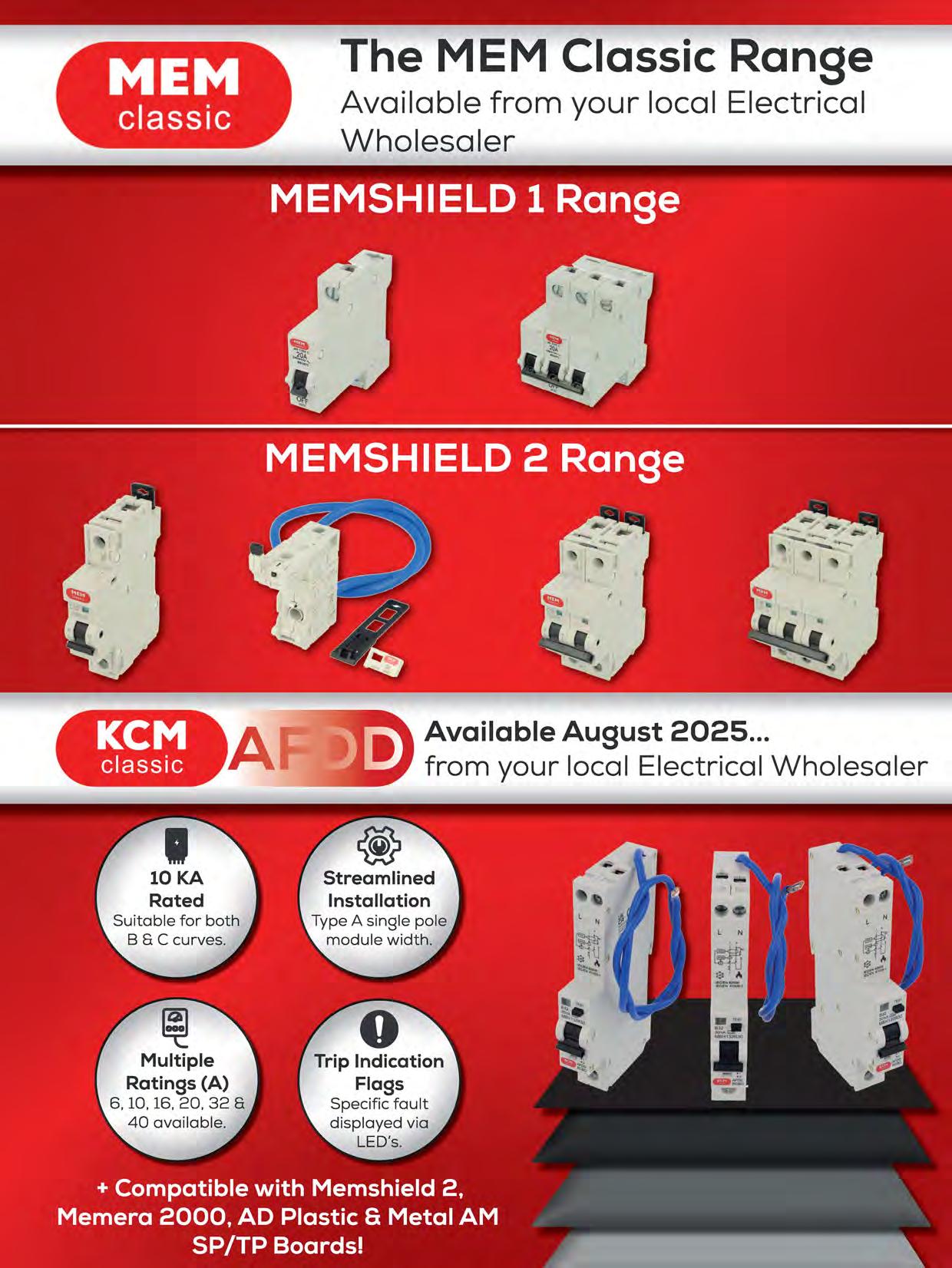
Low carbon and renewable technology installation is a rapidly growing part of the industry. For qualified electricians, the qualifications available under the 'Electrician Plus' concept provide a great opportunity to undertake industry approved up skilling to branch out into these growth areas.
But what about new entrants? It's just as important that apprentices are exposed to 'green' concepts from an early stage, as well as seasoned electricians. That's why both the Installation and Maintenance Electrician apprenticeship and the Domestic Electrician apprenticeship now feature elements oflow-carbon learning. Your apprentices will learn about this in college and it will form part of their End-Point Assessment.
For the Domestic Electrician apprenticeship, as this is a relatively new standard, the green credentials were embedded from the start. The Installation and Maintenance Electrician apprenticeship is wellestablished, but in September 2023, it was updated to include low-carbon technology.
Both apprenticeship routes have been developed against an occupational standard. Within each of these
"It's·ustasimortantthat apprenticesareexposed
to'green'conceptsfrom anearlystage"
standards are several 'duties', which are essentially what the apprentice will be able to do in their job role once their training is complete.
Installation and Maintenance Electrician apprenticeship duties cover the planning and delivery of green solutions, such as electric vehicle (EV) charging systems and battery storage. Apprentices will also gain an understanding of the different types of novel technologies being developed -including the smart grid and lower carbon electric power generation -and how new technologies can be retrofitted to existing installations.
Domestic Electrician apprenticeship 'green' duties include the planning and delivery of environmental technologies for domestic dwellings -including solar photovoltaic systems, heat pumps, microwind turbines and domestic battery storage -and their interaction with conventional electrical installations.
During their End-Point Assessment, apprentices on both routes will encounter an EV charging supply and sustainable energy system alongside their wider electrical installation to test what they've learnt during their apprenticeship.
With apprentices bringing these new ideas and skills into your company, even if you've not yet branched out into low-carbon and renewable technology yourself, it's a great opportunity to take advantage of the new customer leads this might generate.
And look for the qualifications with the Electrician Plus Kitemark to ensure they're industry approved in terms of content and assessment. Visit the-esp.org.uk/electrician-plus for more.

Thelncluslanoflaw carbonfarInstallationand MaintenanceElectrician apprenticesisonly relevanttathosewhowere registeredafterSeptember 2023InEngland.Any apprenticeswhostarted beforethiswon'thave lawcarbonembedded intotheirtraining,but they'llstillbeeligibleta undertaketheupskilling qualificationsinsolar, EVCPandbatterystorage oncetheycompletetheir apprenticeship.
TheInstallationand MaintenanceElectrician apprenticeshiphasbeen hailedbythegovernment asa'goldstandardfar greenskllls',oneofonly sixapprenticeships selectedtareceiveThe CoronationEmblemfartheir sustainabilitycredentials andfardeliveringtheskills neededtasupportthe transitiontanetzero.

CouldYOUwinthenextNICEIC InstallationAward?
As an NICEIC-certified business, we know you take great pride in your work. So, why not show it off?
Whether you or a member of your team has just fitted your first EVcharging point, installed new street lighting, or fitted a back-up generator for an A&E department, we want to know about it!
Our Installation Award is designed to highlight the best work NICEIC-certified businesses have to offer. Simply send us your best images or video of your electrical installation and let us know why you think it deserves to win.
NICEIC is delighted to announce the return of its anniversary certificates. Amanda Faulkner, Customer Experience and Marketing Director, says: "These anniversary certificates give NICEIC the opportunity to celebrate the loyalty and dedication of our NICEIC-certified businesses, which continue to shine and demonstrate their excellence."
Here's how it works: certified businesses celebrating a key anniversary are awarded with a new-look, downloadable e-certificate and exclusive logo. These e-certificates are emailed to customers celebrating their 5th, 10th, 25th, 40th, 50th and 60th anniversaries under schemes AC, DIS, MCS and CPS. We're also honouring those customers who reached an anniversary milestone between 1 January 2019 and 31 January 2025.
Having seen how positively our existing range of certificates has been received, we decided to introduce even more milestones -including 15th, 20th and 30th anniversary certificates. We're excited to be celebrating these new milestones with more deserving businesses very soon.
FROM011965:60IJEARSWITHNICEIC
NAMEOFCDMPAN\I
Glasswell6LastLtd
NeilWhickerElectricalServices
SD6 RASelleckElectricalInstallation
WessexElectricalsShaftesburyLtd
FROM011975:50IJEARSWITHNICEIC
NAMEOFCDMPAN\I
AGTElectrical[Exeter)Ltd
ALCooperElectrical
GerrardElectricalContractorsLtd
AJElectrics[ColeshilllLtd
HobbsElectricalContractorsLtd
SpokemeadMaintenanceLtd
PDHuntLtd
ConceptElectricalServicesLtd
T/ACostellosElectrical
SimkissControlSystemsLtd
RichardBragg[ElectricalContractor)
AlliedElectricCompany
JACElectricians
ACopelandGroupLtd
DowrickElectricalLtd

LOCATION
BurySt Edmunds
DownhamMarket
HighWycombe Shaftesbury
LOCATION
Exeter Tiverton
Stafford
Birmingham Wellington London
Southampton Altrincham Rochdale
Bristol Southport Tollesbury
Ashton-under-Lyne
St Austell

Aneasierwaytofindthetrainingyouneed.
Explore the all-new NICEIConline shop, and sign up for courses and qualifications led by some of the industry's most experienced trade professionals.
With our new and improved search tools, finding local courses and qualifications in the latest technologies has never been easier.
Visit shop.niceic.comto discover our wide range of training courses and qualifications covering:
@ Electricaltraining
(v1>Renewabletechnology
~]'f> Emergencylighting,firedetectionandalarms
Businesssupport
@'t$ Plumbingandheating
Whetheryoupreferin-person,virtual,orself-paced learning,weofferarangeofcoursestailoredtoyourneeds.
c+ Find out more and
Chris Smith at CJS Electrical in West Sussex thought we'd appreciate this "crispy critter". The customer originally brought him in to install hardwired smoke alarms throughout the property.
After discussion, however, they agreed that the consumer units should
be replaced to include RCBOs and surge protection, as the property was thatched.
"All entry holes around the consumer unit were properly sealed to make sure the mice didn't get in again. I might have to change my title to MICE-IC Domestic Installer now ..." Smith says. (Ed's note: Boom! Boom!)
Infutureissues,wewanttafeature yourgreatrepairworkalongside thebatchedjabs.Pleaseemail beforeandafterphotosta
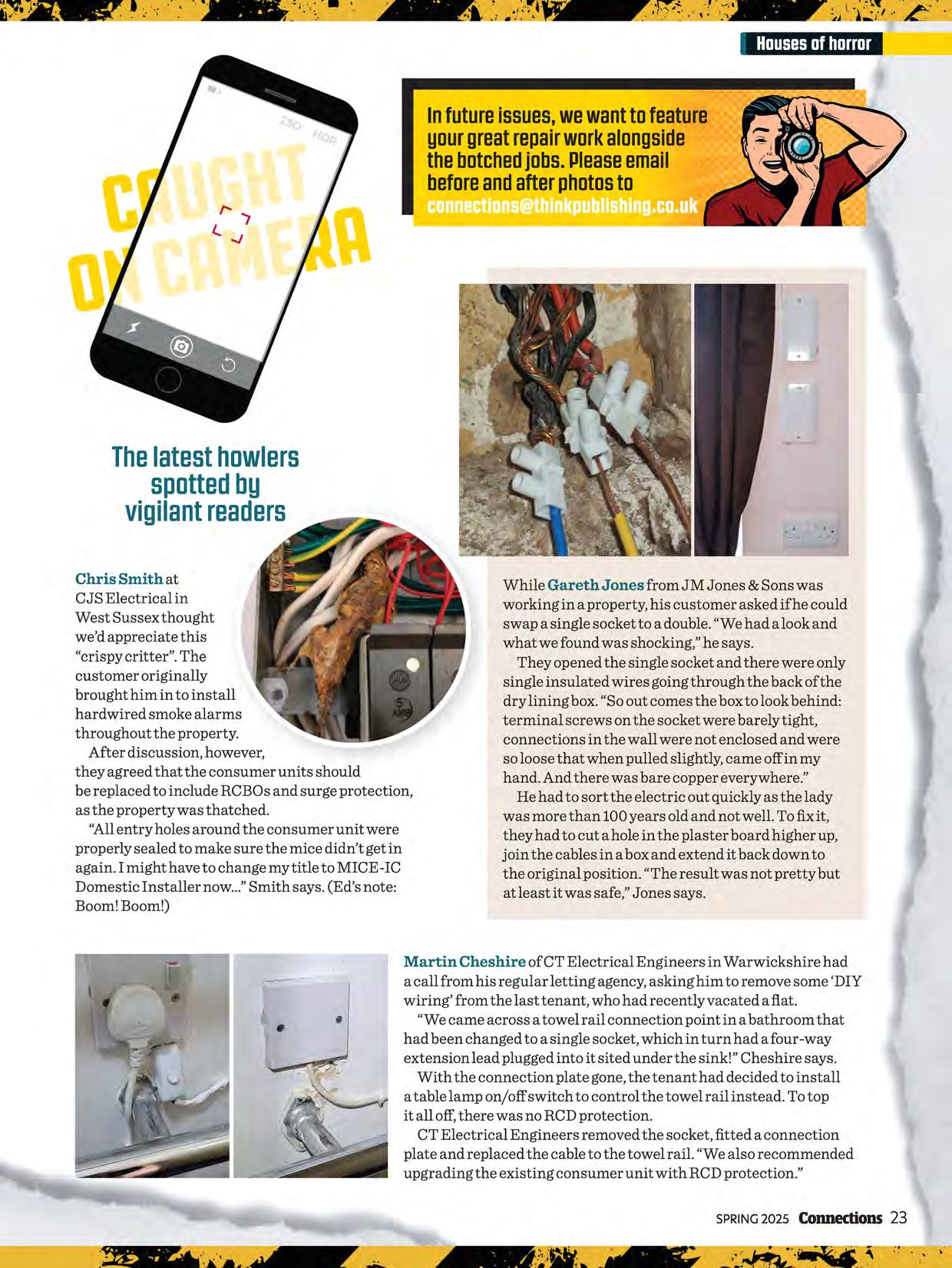
While Gareth Jones from JM Jones & Sons was working in a property, his customer asked ifhe could swap a single socket to a double. "We had a look and what we found was shocking," he says.
They opened the single socket and there were only single insulated wires going through the back of the dry lining box. "So out comes the box to look behind: terminal screws on the socket were barely tight, connections in the wall were not enclosed and were so loose that when pulled slightly, came off in my hand. And there was bare copper everywhere."
He had to sort the electric out quickly as the lady was more than 100 years old and not well. To fix it, they had to cut a hole in the plaster board higher up, join the cables in a box and extend it back down to the original position. "The result was not pretty but at least it was safe," Jones says.
Martin Cheshire of CT Electrical Engineers in Warwickshire had a call from his regular letting agency, asking him to remove some 'DIY wiring' from the lasttenant, who had recently vacated a flat.
"We came across a towel rail connection point in a bathroom that had been changed to a single socket, which in turn had a four-way extension lead plugged into it sited under the sink!" Cheshire says.
With the connection plate gone, the tenant had decided to install a table lamp on/off switch to control the towel rail instead. To top it all off, there was no RCD protection.
CT Electrical Engineers removed the socket, fitted a connection plate and replaced the cable to the towel rail. "We also recommended upgrading the existing consumer unit with RCD protection."
"When we find someone with an enthusiasm to learn and the desire to be on the tools, working on-site and learning from experienced electricians, we generally know we've found someone who'll be with us for many years and go on to have a successful career in the industry," says Andy Downing, Group Operations Director at NICEIC-certified business Playfords, based in London. "It can be an incredibly rewarding career and there are countless examples, including many at Playfords, who started as apprentices and are now in senior roles."
Playfords' commitment to apprentices is bearing fruit. But not all electrical businesses have the resources to get involved. And that's affecting the industry. Without new talent being nurtured, the skills gap will widen. This is where NICEIC is stepping in. We're actively
looking for ways to support NICEICcertified businesses as they look to take on new apprentices. Because the problem isn't a lack of will, it's a lack of infrastructure. And it's affecting the industry's potential to grow.
New research commissioned by NICEIC has highlighted challenges across the electrotechnical industry to do with technical skills, recruitment and those starting a career in the industry.
For those firms not currently hiring apprentices, the admin involved (36%) and the difficulty of recruiting apprentices (17%) were cited as significant obstacles.
Meanwhile, the research found more than half(52%) of the electrical businesses which had recruited or tried to recruit technical staff in 2024 found it to be a difficult process.
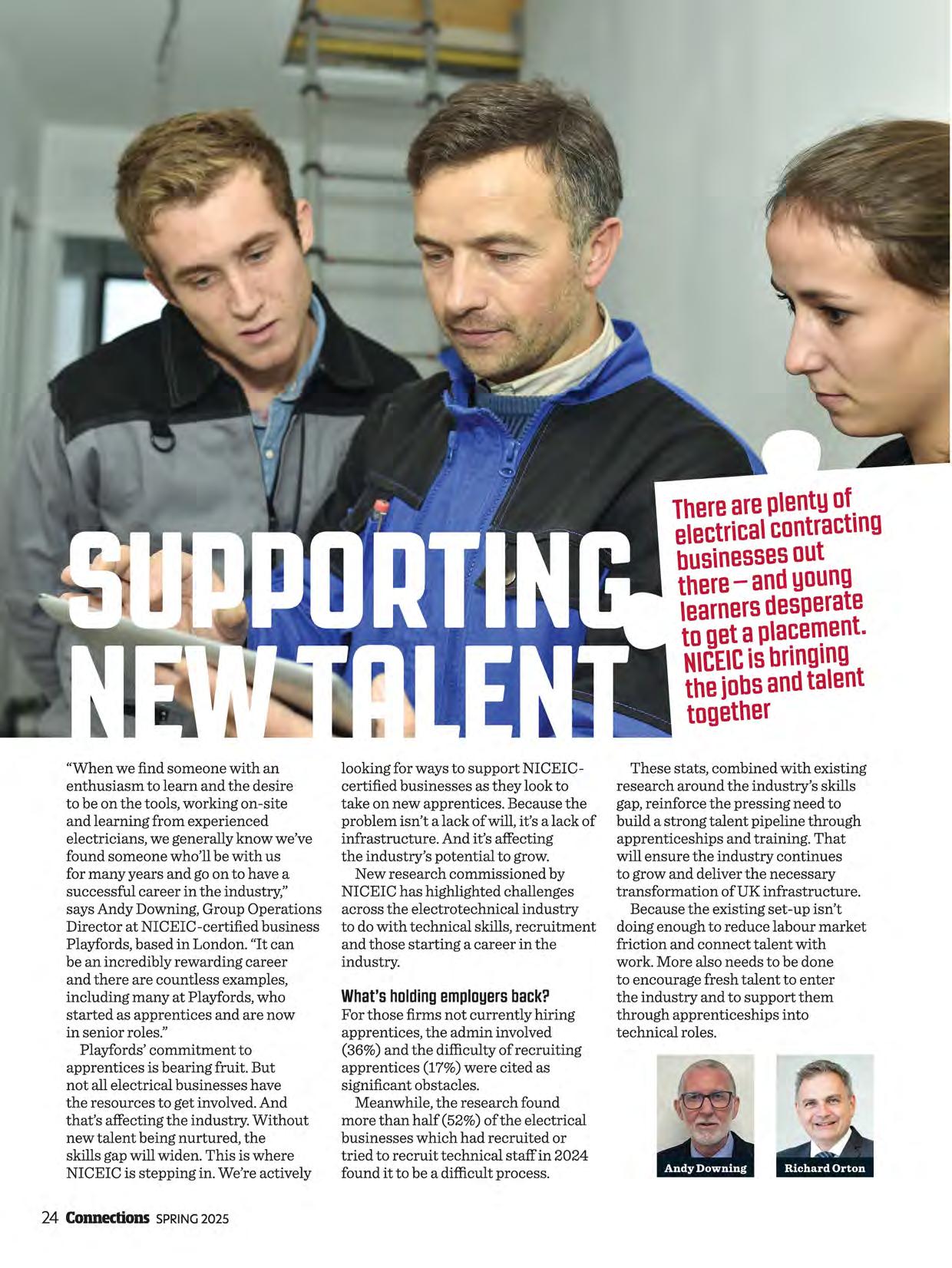
Thereareplentyof. electricalcontractmg businessesout there-anclyoung learnersclesperate togetapla~e~ent. NICEICisbnngmg theiobsancltalent together
These stats, combined with existing research around the industry's skills gap, reinforce the pressing need to build a strong talent pipeline through apprenticeships and training. That will ensure the industry continues to grow and deliver the necessary transformation of UK infrastructure. Because the existing set-up isn't doing enough to reduce labour market friction and connect talent with work. More also needs to be done to encourage fresh talent to enter the industry and to support them through apprenticeships into technical roles.
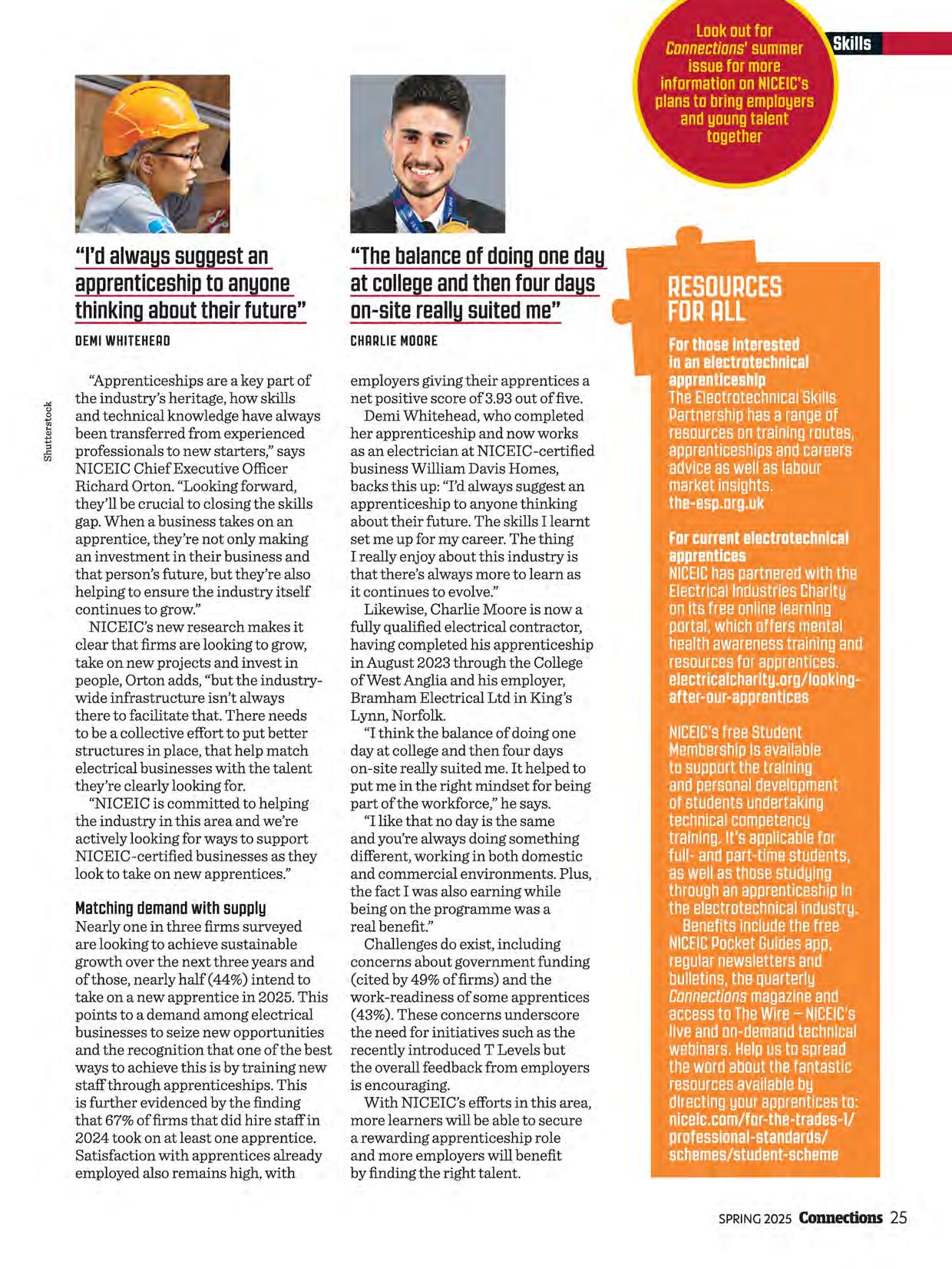
"I'dalwayssuggestan apprenticeshiptoanyone thinkingabouttheirfuture"
"Apprenticeships are a key part of the industry's heritage, how skills and technical knowledge have always been transferred from experienced professionals to new starters," says NICEIC Chief Executive Officer Richard Orton. "Looking forward, they'll be crucial to closing the skills gap. When a business takes on an apprentice, they're not only making an investment in their business and that person's future, but they're also helping to ensure the industry itself continues to grow."
NICEIC's new research makes it clear that firms are looking to grow, take on new projects and invest in people, Orton adds, "but the industrywide infrastructure isn't always there to facilitate that. There needs to be a collective effort to put better structures in place, that help match electrical businesses with the talent they're clearly looking for.
"NICEIC is committed to helping the industry in this area and we're actively looking for ways to support NICEIC-certified businesses as they look to take on new apprentices."
Matchingdemandwithsupply
Nearly one in three firms surveyed are looking to achieve sustainable growth over the next three years and of those, nearly half (44%) intend to take on a new apprentice in 2025. This points to a demand among electrical businesses to seize new opportunities and the recognition that one of the best ways to achieve this is by training new staff through apprenticeships. This is further evidenced by the finding that 67% of firms that did hire staff in 2024 took on at least one apprentice. Satisfaction with apprentices already employed also remains high, with
"Thebalanceofdoingoneday atcollegeandthenfourdays on-sitereallysuitedme"
employers giving their apprentices a net positive score of3.93 out of five. Demi Whitehead, who completed her apprenticeship and now works as an electrician at NICEIC-certified business William Davis Homes, backs this up: ''I'd always suggest an apprenticeship to anyone thinking about their future. The skills I learnt set me up for my career. The thing I really enjoy about this industry is that there's always more to learn as it continues to evolve."
Likewise, Charlie Moore is now a fully qualified electrical contractor, having completed his apprenticeship in August 2023 through the College of West Anglia and his employer, Bramham Electrical Ltd in King's Lynn, Norfolk.
"I think the balance of doing one day at college and then four days on-site really suited me. It helped to put me in the right mindset for being part of the workforce," he says.
"I like that no day is the same and you're always doing something different, working in both domestic and commercial environments. Plus, the fact I was also earning while being on the programme was a real benefit."
Challenges do exist, including concerns about government funding (cited by 49% offirms) and the work-readiness of some apprentices (43%). These concerns underscore the need for initiatives such as the recently introduced T Levels but the overall feedback from employers is encouraging.
With NICEIC's efforts in this area, more learners will be able to secure a rewarding apprenticeship role and more employers will benefit by finding the right talent.
Forthoseinterested inanelectrotechnical apprenticeship
TheElectrotechnicalSkills Partnershiphasarangeof resourcesontrainingroutes, apprenticeshipsandcareers adviceaswellaslabour marketinsights. the-esp.org.uk
Forcurrentelectrotechnical apprentices NICEIChaspartneredwiththe ElectricalIndustriesCharity onitsfreeonlinelearning portal,whichoffersmental healthawarenesstrainingand resourcesforapprentices. electricalcharity.org/lookingafter-our-apprentices
NICEIC'sfreeStudent Membershipisavailable tosupportthetraining andpersonaldevelopment ofstudentsundertaking technicalcompetency training.It'sapplicablefor full-andpart-timestudents, aswellasthosestudying throughanapprenticeship in theelectrotechnicalindustry. Benefitsincludethefree NICEICPocketGuidesapp, regularnewslettersand bulletins,thequarterly Connectionsmagazineand accesstoTheWire-NICEIC's liveandon-demandtechnical webinars.Helpustospread thewordaboutthefantastic resourcesavailableby directingyourapprenticesto: niceic.com/for-the-trades-1/ professional-standards/ schemes/student-scheme
KevinBooneandDanny McBeanshoneduring theSkillELECTRIC UK final.Nextstep:electric vehicletrainingwithNICEIC
Kevin Boone and Danny McBean headed to Bristol to complete the installation of an electric vehicle (EV) charging points course with Technical Training Developer Mitchel Smith (see opposite).
Both had already been put through their paces on renewables, because the 2023 SkillELECTRIC final included a solar photovoltaics (PV) task, developed by NICEIC. In fact, McBean, who went home with gold, and finalist Boone, were part of the first set of finalists to tackle the task.

McBean and Boone completed the EV and EESS Awareness training as part of the prizes awarded by NICEIC to the 2023 UK finalists.
As they were now qualified electricians who met the entry requirements, they were keen to take the next step and pursue the Electrician Plus-aligned EAL award.
McBean travelled down from Scotland's Speyside region to the training centre in Bristol. He's been
a qualified electrician since November 2023 and is still with Grants (Dufftown), near Inverness, where he did his apprenticeship. "Grants is mostly industrial and does a lot of Scotch whisky facilities," he says. So why make the trip to south-west England to learn about EV?
"I wanted to broaden my horizons," McBean explains. "I saw it as a way for me to build up my skillset and open new opportunities for the future."
Boone, who's also qualified and is employed by Darke & Taylor near Oxford, where he apprenticed, has more pressing reasons to upskill in this way. "I've now moved into the renewables team in my company. I've been dealing with solar PV and battery storage up until now. It's a requirement to do this course," he says.
This is his second career, having been a bomb disposal technician in the army for 17 years. He'd already achieved the Solar PV and Level 4 Design qualifications with NICEIC. "I feel it's my preferred training provider," he says.
McBean adds: "I've known a few people who've done NICEIC courses. They've always said they've been good and it was worth the journey."
SkillELECTRIC finalists Danny McBean (left) and Kevin Boone reunite to learn the ropes
Menanamission
Boone was surprised how much had changed since he'd had any EV training. "Before, it was still putting earth rods in the ground, but the technology has come on in leaps and bounds."
For McBean, it was considerations around installations where protective multiple earthing conditions apply that particularly interested him. He was also impressed with their trainer, Smith, who helped prepare them for the SkillELECTRIC final. "He was open to questions and explained everything really well," McBean says. He's on a mission to build up his skills. 'Tm trying to do as many courses as I can, to see what I like. I want to learn continually."
He's already completed the Design, Installation and Commissioning of EESS course at NICEIC's base in Dunstable -an Electrician Plusaligned qualification. 'Tm now looking at the PV course that NICEIC runs, because it's in the same bracket."
Meanwhile, Boone's plan is to "give this role in renewables [at Darke & Taylor] a good go." But longer term, "my passion in the trade is the design element; maybe later down the line I'll see ifl can move into a design role."
Goto shop.niceic.com/collections/alltraining-coursesfor moreinformation onNICEIC'straining.
NICEIC'sTechnicalTrainingDeveloper
MitchelSmithhasbeenappointed bythe prestigious competitionas its TrainingManager far electricalinstallation.
Thismeanshe'llbeleading thetraininganddevelopment of competitorsin the event'selectrical installationcategory,asthe squad preparesto representthe UKonthe internationalstage. is seenby experts globallyasthe ultimatetest of a nation'sabilityto meetfutureskills needs.Forcompetitors, it all starts with SkillELECrnlC.Competitorswho shineinthat contestareselected by UKto joinTeamUK's electricalinstallationcategory. NICEIC is a long-standingpartnerof SkillELECrnlC,collaboratingwiththe organisersto equipparticipantswith the skillsnecessaryto excel.
Squadgoals
"I'mlookingforwardto workingwith talentedindividualswhomadeit onto the electricalinstallationsquadto helpthemdeveloptheirtechnical skillsandreachtheirfull potential," Smithsays.
He'llberesponsiblefor designing andimplementingthetraining programmesthat preparethese competitorsfor the challenges presentedby He'llwork closelywith industryexpertsand educatorsto makesureparticipants receivethe highestqualitytraining andsupport.
Thecontestantswill bein good hands,asSmithhasmorethan
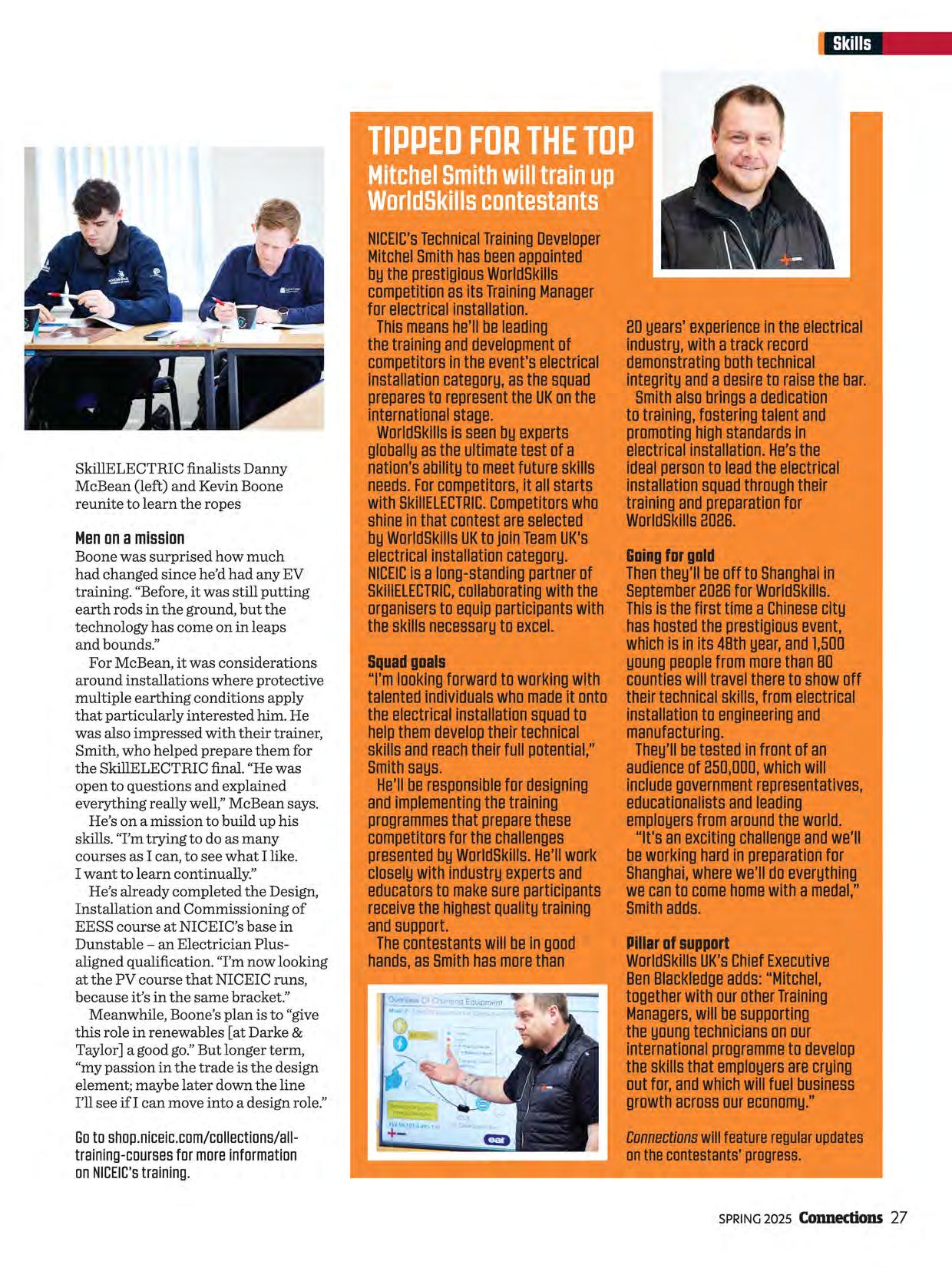
20years'experienceinthe electrical industry,with a trackrecord demonstratingbothtechnical integrityanda desireto raisethe bar. Smithalsobringsa dedication to training,fosteringtalentand promotinghighstandardsin electricalinstallation.He'sthe idealpersonto leadthe electrical installationsquadthroughtheir trainingandpreparationfar WorldSkills2026.
Goingforgold
Thenthey'llbeoff to Shanghaiin September2026far
Thisis thefirst timea Chinesecity hashostedthe prestigiousevent, whichis in its 48thyear,and1,500 youngpeoplefrommarethanBO countieswill travelthereto showoff theirtechnicalskills,fromelectrical installationto engineeringand manufacturing.
They'llbetestedinfront of an audienceof 250,000,whichwill includegovernmentrepresentatives, educationalistsandleading employersfromaroundtheworld.
"It's anexcitingchallengeandwe'll beworkinghardin preparationfor Shanghai,wherewe'lldoeverything wecanto comehomewith a medal," Smithadds.
Pillarorsupport
WorldSkillsUK'sChiefExecutive BenBlackledgeadds:"Mitchel, togetherwith ourotherTraining Managers,will besupporting the youngtechniciansonour internationalprogramme to develop the skillsthat employersarecrying outfor,andwhichwill fuel business growthacrossoureconomy."
Cannectianswillfeatureregularupdates onthecontestants'progress.
NICEIC was out in force at ElexShow in March -a good thing as the stand had a constant stream of visitors. Over two days in March, 4,479 people came through the doors, which was even more than last year and the busiest show since 2019.
This was a chance for members ofNICEIC-certified businesses, apprentices and others to meet our technical helpline expertsincluding Head of Technical Advice and Practice Sam Donaghy himself -Area Engineers such as Lisa Burge, Training Events Manager Teresa Morris and Head of Product Development Alex Robinson. Many visitors dropped by to find out about training opportunities, according to Robinson. "People here are positive about their own professional development," he says. "It's not just a box to tick; they see it as a positive investment in their own training and their business."
Visitors were keen to find out what they need to join NICEIC, says Burge. "Alot are thinking of coming back into the industry. You can never get bored with electrics." She pointed them to the Experienced Worker Assessment. While they were there, visitors tested themselves on the Rapid Regs Challenge and EICR Station (can you code them all?'). They also played Beat the Buzzer and checked out the Prosumer Station.
Over in the talks area, Technical Services Engineers Jonathan Dare and Craig Kemp presented a seminar on Earthing and Bonding of Solar PV Systems. "We did the back-to-basics fundamentals then extended it to requirements for solar PV,"Dare says. The team will be on hand at ElexShow's next stops around the country. For more, see pages 36 to 39.
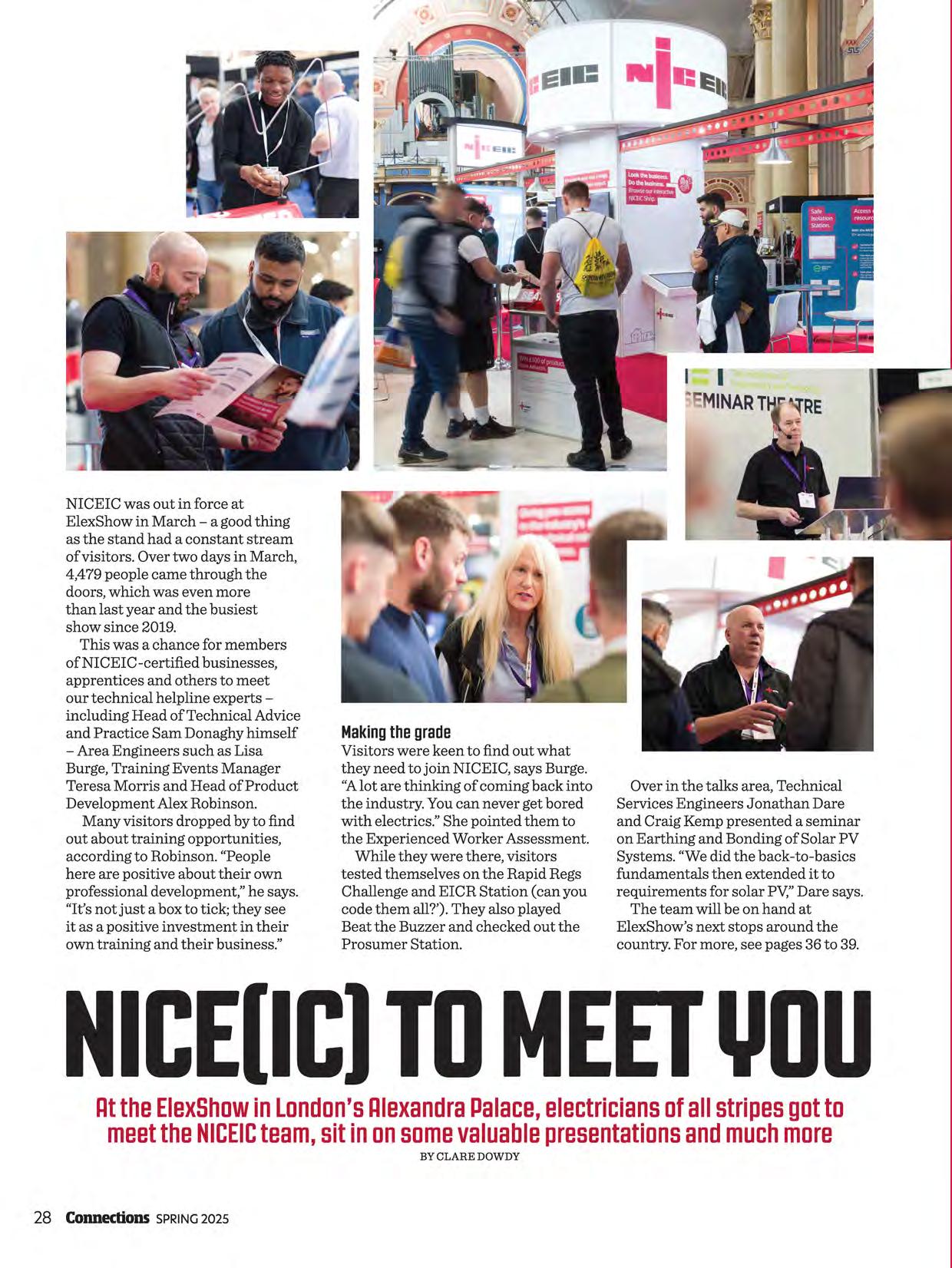
BY CLARE DOWDY

TheWirelive andon-demand
WatchTheWireCPD-accredited webinarsliveoron-demandatwork, onyourlunchbreak,orfromyoursofa.
Our industry experts deliver informative, engaging and trusted insights on the latest need-to-know topics.
Missedanepisode?
If you miss the live webinar, join at a time and place that suits you. The Wire on-demand library features over 30 hours of CPD-accredited webinars.

Cominguplive:
FireSystems
SolarPV RCDandHeatPumps
Frequentlyasked technicalquestions

Check out our monthly live-stream Technical Q&A across social media channels: Facebook, Linkedln and YouTube. Talk directly to experienced experts and engage with your peers.
Get exclusive access to our technical team and connect with colleagues at our new in-person CPD event in 2025.
Hear the latest regulatory updates, take home some business tips, or learn how to boost your wellbeing.
Asourbusinessesareaware,certificationisn'tjust aboutmeetingregulatoryreQuirements.Manyof you goaboveandbeyond,committingta thehighest professionalstandards,enhancingsafetyand drivingcontinuousimprovement in the industry.Andall that is goad far business
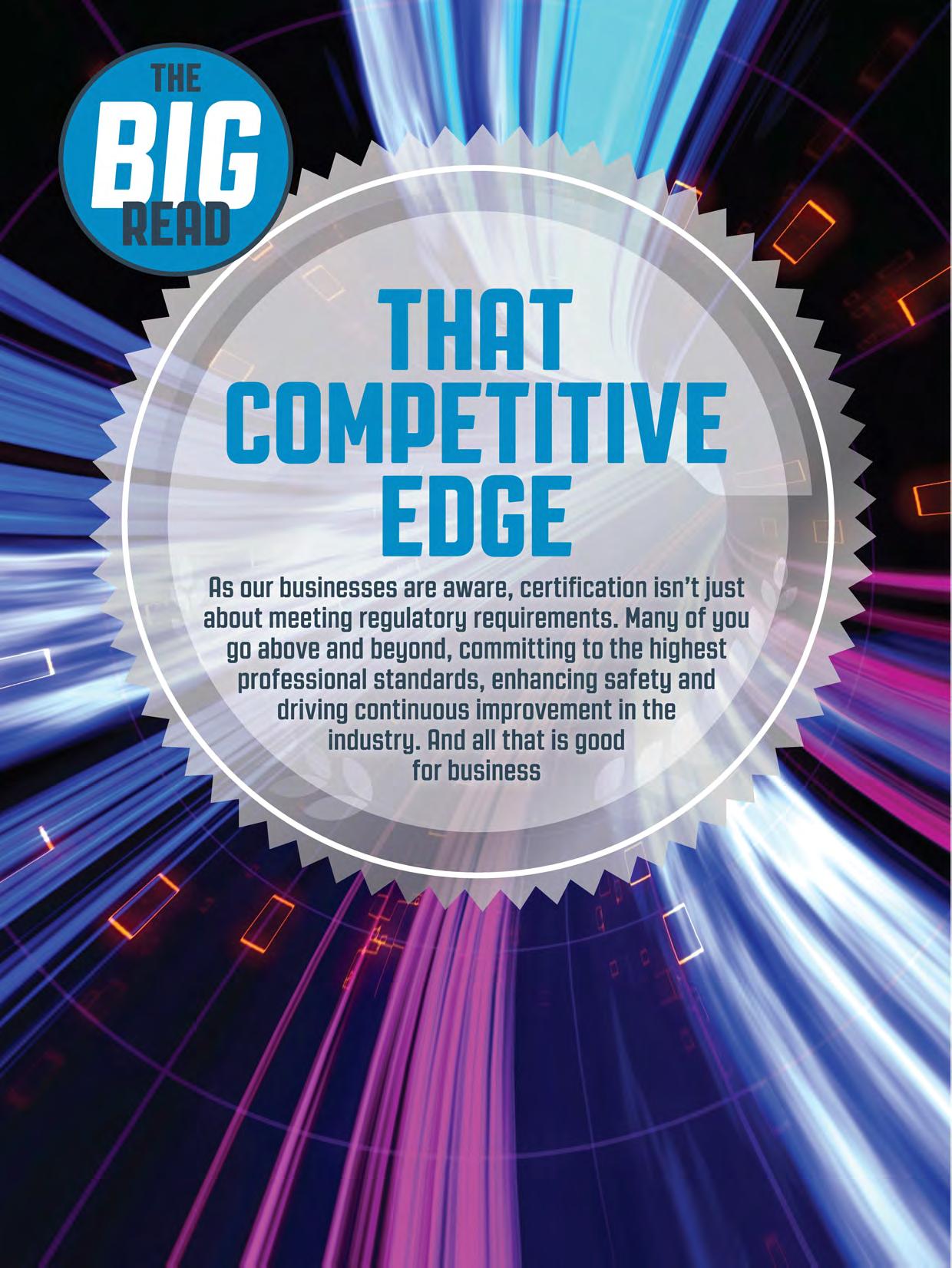
"Wewanttosee businessesthriveover theIontermwith trustedrelationshi s rowinacrossthe sectorasawhole"
PAULCOLLINS, TECHNICALDIRECTOR,NICEIC

ertification is more than just a checkbox exercise and evidence that a business has passed an annual assessment. In the competitive environment of electrical contracting, certification is a tool that can help businesses stand out by demonstrating their commitment to meeting industry standards and to continued learning as the industry evolves.
"Historically, regulations and standards have often been seen as correctional measures that are in place to prevent sub-standard work and provide recourse ifit does happen," explains Paul Collins, Technical Director at NICEIC. "While that's a useful 'last line of defence' for consumers, our more positive and proactive approach enables companies who deeply care about their work to push the industry forward by improving professional standards across the board and ensuring there are benchmark levels of compliance, competence and safety."
This approach benefits customers by providing them with clarity and confidence when working with businesses from an industry that can sometimes be complex to navigate, and also the industry as a whole. "We want to see businesses thrive over the long term, with trusted relationships growing across the sector as a whole," says Collins. "This sort of continuity and reliability is better for the businesses who
do great work, better for customers and better for the wholesalers and business services providers who operate in our industry and enable its daily operations."
This is where certification comes in. "NICEIC-certified businesses display their certification on their premises, vans, workwear and websites because they know the rigorous process they've been through to achieve it," Collins says.
When customers see a mark of certification, they know they're dealing with a business that adheres to industry standards in terms ofboth safety and technical integrity.
Ian Butherway, Managing Director of specialist electrical contractor Electro Technical and Testing Solutions, has a similar view. The firm started trading in 1953 and has been NICEIC certified since 1974. "There are many projects that we have worked on where certification by a recognised body has been a requirement. And when it comes to certification, NICEICisbyfarthe best-known name."
Martin Pearce at Martin Pearce Ltd agrees: "NICEIC, in my opinion, is the most recognisable certification organisation for the electrical industry in the UK. When meeting potential new customers, I always make a point of explaining the importance and benefits of being an NICEIC-approved business."
webinars, NICEIC events and live Q&As across our social channels.
• Regular assessments As well
NICEIC customer portal for your exclusive voucher code.
System Self-certify your worlc with local building control and .
"Whenmeeting potentialnewcustomers, Ialwaysmakeapointof explainingtheimportance andbenefitsofbeingan NICEIC-approved business"
MARTINPEARCE, MARTINPEARCELTD
This implied trust is invaluable in an industry where reputations are hard-won and easily lost. Certification with NICEIC assures clients that they're hiring a competent business, which leads to repeat business and referrals.
One of the most significant advantages of certification is the boost it provides to professional credibility. As you know, being certified with NICEIC involves not just an initial assessment but also regular, ongoing surveillance assessments conducted by experienced assessors. This process showcases your commitment to transparency and accountability by opening your work to external scrutiny and demonstrating its adherence to the required standards.
Butherway, who has experienced his fair share ofNICEIC annual assessments reflects: "We find the visit from our assessor useful, as the feedback, particularly with new technologies, is appreciated."
Additionally, certification requires a commitment to lifelong learning through continuous professional development (CPD), reassuring your customers that the skills and knowledge of certified businesses are current, rather than relying on training potentially received years ago.
In addition, it's a mark of both long-term thinking and multi-year business planning that's common among NICEIC-certified
businesses. More than 5,000 NICEIC businesses have been certified for more than 20 years, which provides yet more assurance to customers that a business is motivated to do things right, because they know from experience it's a key to future projects and referrals.
This combination that certified businesses can demonstrate -ofupto-date skills, the right experience and delivering time and again -provides customers with confidence in the quality and safety of the services they receive.
Being NICEIC certified is not just about the logo that businesses can display or the assessment.
Collins explains: "Beyond what's visible, there's a wealth ofresources, including technical support, training and industry updates, available to certified businesses and their staff."
These resources ensure NICEIC-certified businesses have access to the information they need, when they need it and can stay one step ahead. The ability to tap into this pool of knowledge can significantly enhance the quality of work they do and the service
they provide.
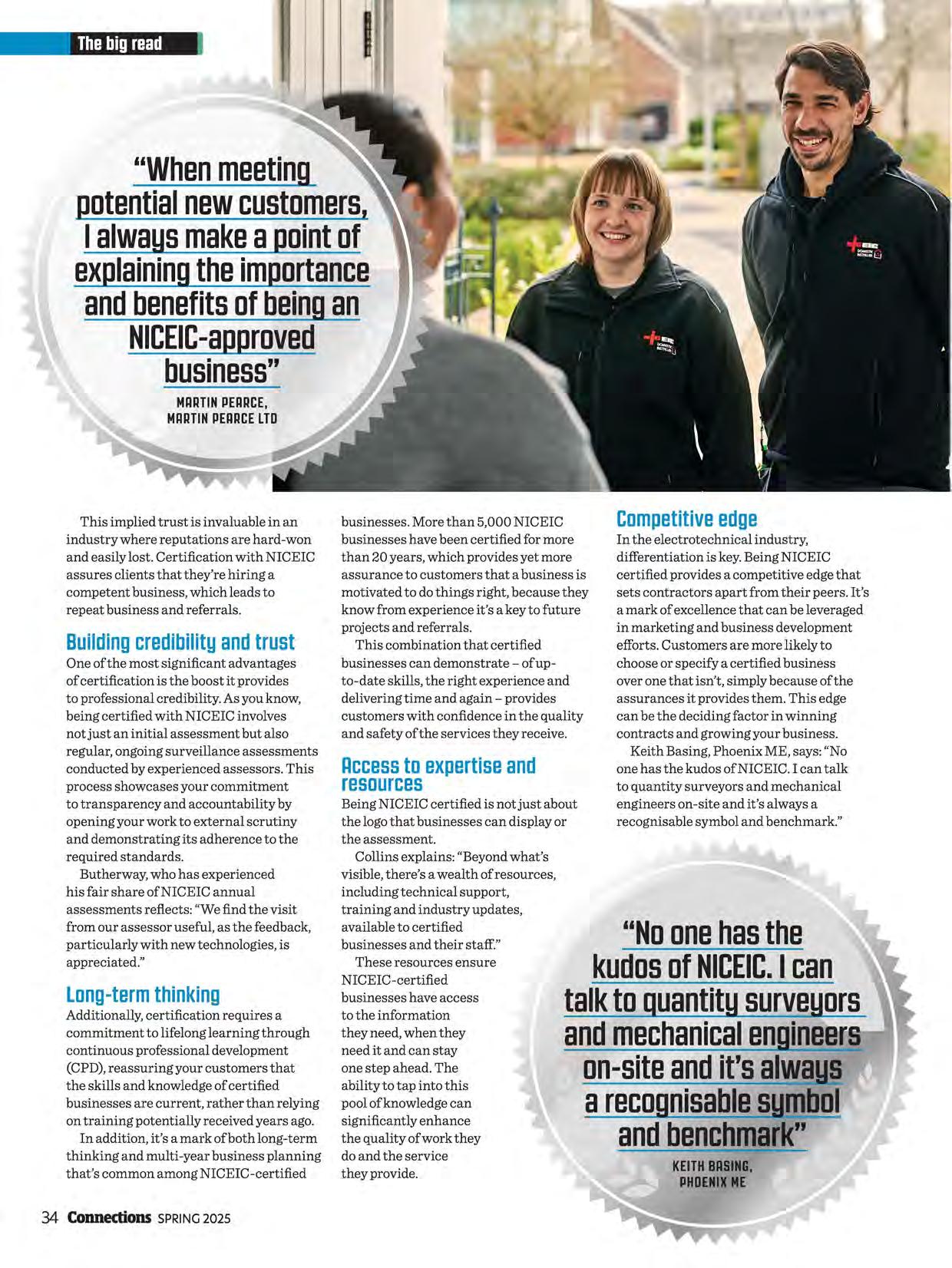
In the electrotechnical industry, differentiation is key. Being NICEIC certified provides a competitive edge that sets contractors apart from their peers. It's a mark of excellence that can be leveraged in marketing and business development efforts. Customers are more likely to choose or specify a certified business over one that isn't, simply because of the assurances it provides them. This edge can be the deciding factor in winning contracts and growing your business.
Keith Basing, Phoenix ME, says: "No one has the kudos ofNICEIC. I can talk to quantity surveyors and mechanical engineers on-site and it's always a recognisable symbol and benchmark."
"Noonehasthe
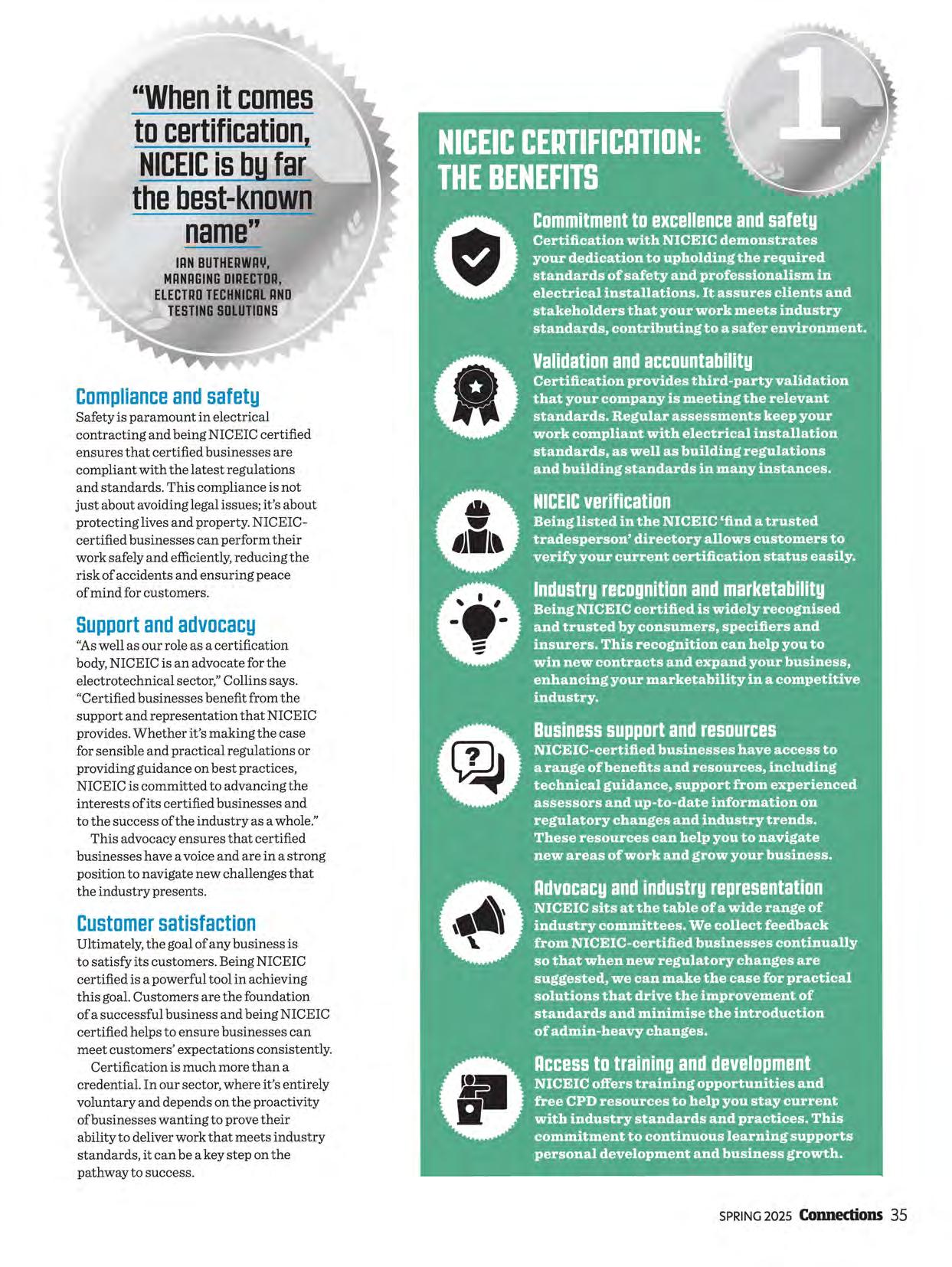
"Whenitcomes tocertification, NICEICisbyfar thebest-known name"
IANBUTHERWAIJ, MANAGINGDIRECTOR, ELECTROTECHNICALAND TESTINGSOLUTIONS
Safety is paramount in electrical contracting and being NICEIC certified ensures that certified businesses are compliant with the latest regulations and standards. This compliance is not just about avoiding legal issues; it's about protecting lives and property. NICEICcertified businesses can perform their work safely and efficiently, reducing the risk of accidents and ensuring peace of mind for customers.
"Aswell as our role as a certification body, NICEIC is an advocate for the electrotechnical sector," Collins says. "Certified businesses benefit from the support and representation that NICEIC provides. Whether it's making the case for sensible and practical regulations or providing guidance on best practices, NICEIC is committed to advancing the interests ofits certified businesses and to the success of the industry as a whole."
This advocacy ensures that certified businesses have a voice and are in a strong position to navigate new challenges that the industry presents.
Ultimately, the goal of any business is to satisfy its customers. Being NICEIC certified is a powerful tool in achieving this goal. Customers are the foundation of a successful business and being NICEIC certified helps to ensure businesses can meet customers' expectations consistently. Certification is much more than a credential. In our sector, where it's entirely voluntary and depends on the proactivity of businesses wanting to prove their ability to deliver work that meets industry standards, it can be a key step on the pathway to success.
'POL1Cv7 NICEIC, Electrical L! !J Safety First (ESF) and other stakeholders have championed increased safety checks in Northern Ireland. The result is new electrical safety legislation requiring five-yearly electrical safety checks for new tenancies in the country's private rented sector.
This change means all fixed electrical installations must be inspected and tested by a competent and qualified electrician at least once every five years, protecting more than 100,000 homes from potential electrical hazards.
The new laws apply immediately to all new tenancies, with existing tenancies granted before 1 April given until 1 December 2025 to comply.
"This represents a positive step forward for electrical safety in Northern Ireland, bringing its rules in line with the rest of the UK," says NICEIC Technical Director Paul Collins. "I'm sure the changes will also provide reassurance to those living in homes in the private rented sector that their home and family is not at risk of unsafe electrics."
If you're anNICEIC-certified business undertaking electrical safety checks, don't forget to make use of the free tools available to you. ESF has resources both on electrical installation condition reporting (Best Practice Guide 4) and its WRAG Q&As, offering industry-agreed best practice guidance on EICRcoding and the application of BS 7671.
For more, visit: electricalsafetyfirst. org.uk/professional-resources/ best-practice-guides and electricalsafetyfirst.org.uk/ professional-resources/wiringregulations
Coinciding with the updates in Northern Ireland, ESF has also added to its guidance for landlords, which explains their responsibilities for ensuring their rental properties are electrically safe. For more, visit: electricalsafetyfirst.org.uk/ guidance/advice-for-you/landlords
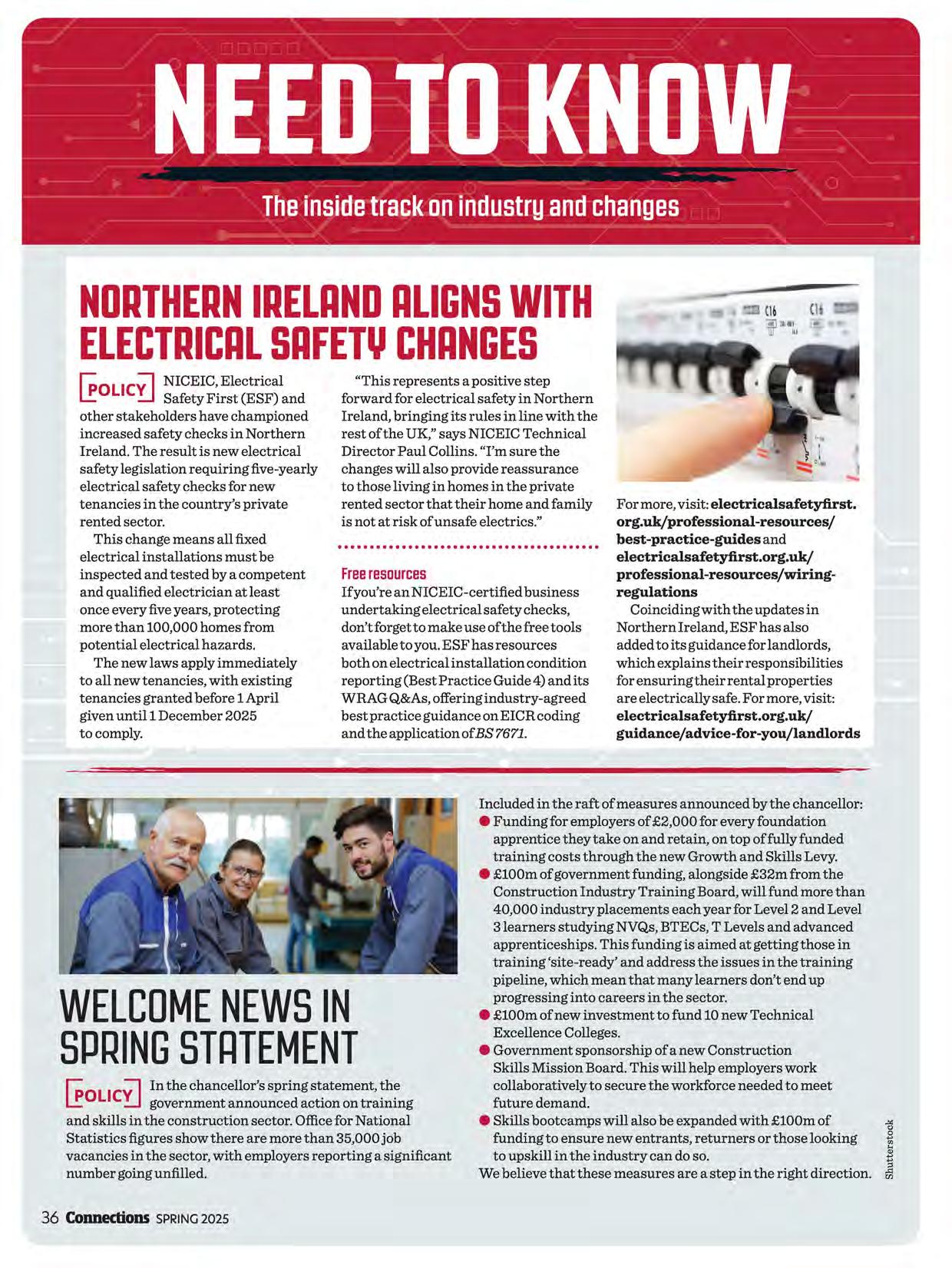
'POLIcv1 In the chancellor's spring st_atement, L! !J government announced action on trammg and skills in the construction sector. Office for National Statistics figures show there are more than 35,000 job vacancies in the sector, with employers reporting a significant number going unfilled.
Included in the raft of measures announced by the chancellor:
• Funding for employers of £2,000 for every foundation apprentice they take on and retain, on top offully funded training costs through the new Growth and Skills Levy.
• £100m of government funding, alongside £32m from the Construction Industry Training Board, will fund more than 40,000 industry placements each year for Level 2 and Level 3 learners studying NVQs, BTECs, T Levels and advanced apprenticeships. This funding is aimed at getting those in training 'site-ready' and address the issues in the training pipeline, which mean that many learners don't end up progressing into careers in the sector.
• £100m of new investment to fund 10 new Technical Excellence Colleges.
• Government sponsorship of a new Construction Skills Mission Board. This will help employers work collaboratively to secure the workforce needed to meet future demand.
• Skills bootcamps will also be expanded with £100m of funding to ensure new entrants, returners or those looking to upskill in the industry can do so. We believe that these measures are a step in the right direction.
At this in-person CPD event, our certified businesses can learn from NICEIC's technical experts, network with other NICEICcertified businesses and hear from manufacturers on new products and services. Sessions are delivered by recognised industry voices.
This year's themes are: electrotechnical and renewables fundamentals, regulatory updates, mental health and wellbeing, and business tools. There will also be a live technical Q&A.
"We are committed to sharing our expertise with NICEIC-certified businesses to help them stay ahead of the competition," says Amanda Faulkner, Customer Experience and Marketing Director. "It's also an opportunity to rack up to five hours of CPD, helping you to meet your NICEIC scheme requirements."
The first NICEIC Tech Live takes place at Bedford's Millbrook Proving Ground on 22 October. Book your place now: niceic.com/events
Following the success of the ElexShows in Bolton, London, Exeter and Yorkshire, the NICE IC team are due to make a splash at the Coventry Building Society Arena in September and Surrey's Sandown Park in November. At each venue, our experts are on hand at NICE I C's stand, and on stage we'll be delivering technical presentations.
We also have InstallerSHOW at Birmingham NEC in the diary for 24 to 26 June.
Three cheers to the winners of Skills Competition Wales 2025's electrical installation category: Adam George Davis, Kiran Mason, Evan Overton and Jack Bowen. Skills
Alex Robinson, supported the event as judges and technical advisers for the competitors. The competition's lead judge was three-time SkillELECTRIC UK finalist and 2022
A reminder that the 2025 edition of BS 5889-1, the British Standard for fire detection and fire alarm systems in non-domestic premises, has now been published. Key changes include clearer recommendations for placement of manual call points in stairways of multi-storey buildings. There's in-depth coverage of key changes in the technical section (turn to page 46) and we also covered the fire systems update in The Wire on 22 May-catch up on-demand.
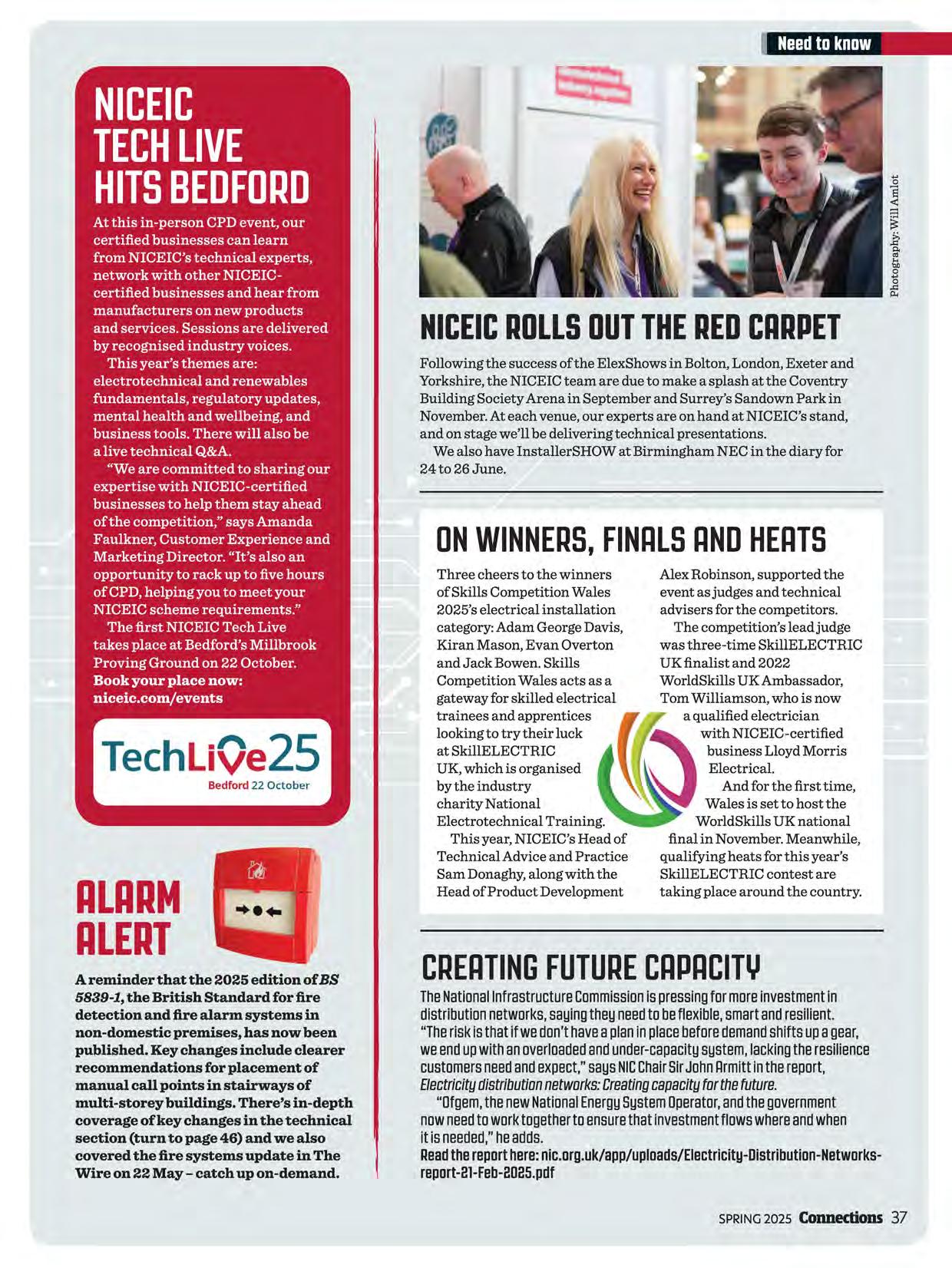
Competition Wales acts as a WorldSkills UK Ambassador, gateway for skilled electrical Tom Williamson, who is now trainees and apprentices
qa qualified electrician lookingtotrytheirluck withNICEIC-certified at SkillELECTRIC business Lloyd Morris UK, which is organised Electrical. by the industry And for the first time, charity National Wales is set to host the Electrotechnical Training. WorldSkills UK national This year, NICEIC's Head of final in November. Meanwhile, Technical Advice and Practice qualifying heats for this year's Sam Donaghy, along with the SkillELECTRIC contest are Head of Product Development taking place around the country.
TheNationalInfrastructureCommission is pressingformoreinvestmentin distributionnetworks,sayingtheyneedto beflexible,smartandresilient. "Theriskisthatif wedon'thaveaplaninplacebeforedemandshiftsupagear, weendupwithanoverloadedandunder-capacitysystem,lackingtheresilience customersneedandexpect,"saysNICChairSirJohnArmittinthereport, Electricitydistributionnetworks:Creatingcapacityforthefuture. thenewNationalEnergySystemOperator,andthegovernment nowneedto worktogetherto ensurethatinvestmentflowswhereandwhen it is needed,"headds. Readthereporthere:nic.org.uk/app/uploads/Electricity-Distribution-Networksreport-21-Feb-2025.pdf
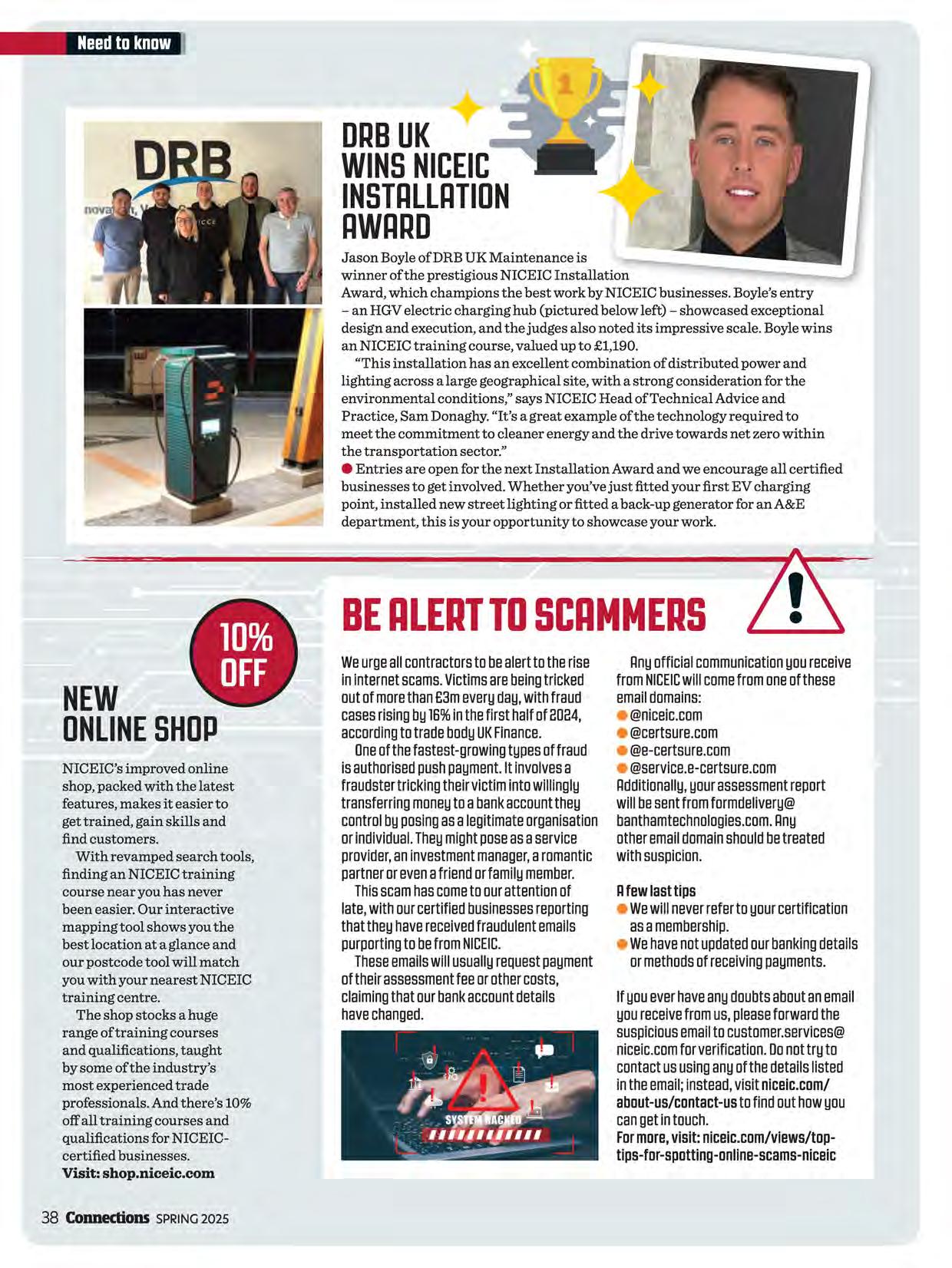
NICEIC's improved online shop, packed with the latest features, makes it easier to get trained, gain skills and find customers.
With revamped search tools, finding an NICEIC training course near you has never been easier. Our interactive mapping tool shows you the best location at a glance and our postcode tool will match you with your nearest NICEIC training centre.
The shop stocks a huge range of training courses and qualifications, taught by some of the industry's most experienced trade professionals. And there's 10% off all training courses and qualifications for NICEICcertified businesses. Visit: shop.niceic.com
Jason Boyle ofDRB UK Maintenance is
winner of the prestigious NICEIC Installation Award, which champions the best work by NICEIC businesses. Boyle's entry -an HGV electric charging hub (pictured below left) -showcased exceptional design and execution, and the judges also noted its impressive scale. Boyle wins an NICEIC training course, valued up to £1,190.
"This installation has an excellent combination of distributed power and lighting across a large geographical site, with a strong consideration for the environmental conditions," says NICEIC Head of Technical Advice and Practice, Sam Donaghy. "It's a great example of the technology required to meet the commitment to cleaner energy and the drive towards net zero within the transportation sector."
• Entries are open for the next Installation Award and we encourage all certified businesses to get involved. Whether you've just fitted your first EV charging point, installed new street lighting or fitted a back-up generator for an A&E department, this is your opportunity to showcase your work.
Weurgeallcontractorsto bealerttotherise ininternetscams.Victimsarebeingtricked outof morethan£3meveryday,withfraud casesrisingby16%inthefirst halfof 2024, accordingto tradebodyUKFinance.
Oneofthefastest-growingtypesoffraud is authorisedpushpayment. It involves a fraudstertrickingtheirvictimintowillingly transferringmoneyto a bankaccountthey controlbyposingasa legitimateorganisation orindividual.Theymightposeasaservice provider,aninvestmentmanager, a romantic partnerorevenafriendorfamilymember.
Thisscamhascometo ourattentionof late,withourcertifiedbusinessesreporting thattheyhavereceivedfraudulentemails purportingto befromNICEIC.
Theseemailswillusuallyrequestpayment oftheirassessmentfeeorothercosts, claimingthatourbankaccountdetails havechanged.
Anyofficialcommunicationyoureceive fromNICEICwillcomefromoneofthese emaildomains:
•@niceic.com
•@certsure.com
•@e-certsure.com
•@service.e-certsure.com
Additionally,yourassessmentreport willbesentfromformdelivery@ banthamtechnologies.com. Any otheremaildomainshouldbetreated withsuspicion.
• Wewillneverreferto yourcertification asamembership.
• Wehavenotupdatedourbankingdetails ormethodsof receivingpayments.
If youeverhaveanydoubtsaboutanemail youreceivefromus,pleaseforwardthe suspiciousemailto customer.services@ niceic.comforverification. nottry to contactususinganyofthedetailslisted intheemail;instead,visitniceic.com/ about-us/contact-us to findouthowyou cangetintouch.
Formore,visit:niceic.com/views/toptips-for-spotting-online-scams-niceic
The Electrical Contractors' Association (ECA) has launched a second digital series of films and interviews highlighting the elements needed for a safe transition to net zero. The series features 14 content partners "who represent the change-makers propelling our clean energy transition across every aspect of modern society, from transport to housing, industry to commerce," says ECA's Head of External Affairs, Jane Dawson.
The series, Electrifying our Future, was developed in partnership with Content with Purpose and explores related advancements in skills development, professional competence, business resilience and policy and regulation to keep up with the pace of change.
"Electrifying our Future goes beyond identifying challenges, by offering practical solutions and actionable insights that will help electrical firms embrace opportunities and meet evolving demands," Dawson says.
"The series underscores the urgency of acting now to equip the workforce for the future, ensuring the industry remains at the forefront of the energy transition."
Series collaborators include leading industry figures from The Institution of Engineering and Technology, Electrical Safety First, Energy UK, SELECT and BEAMA, among others.
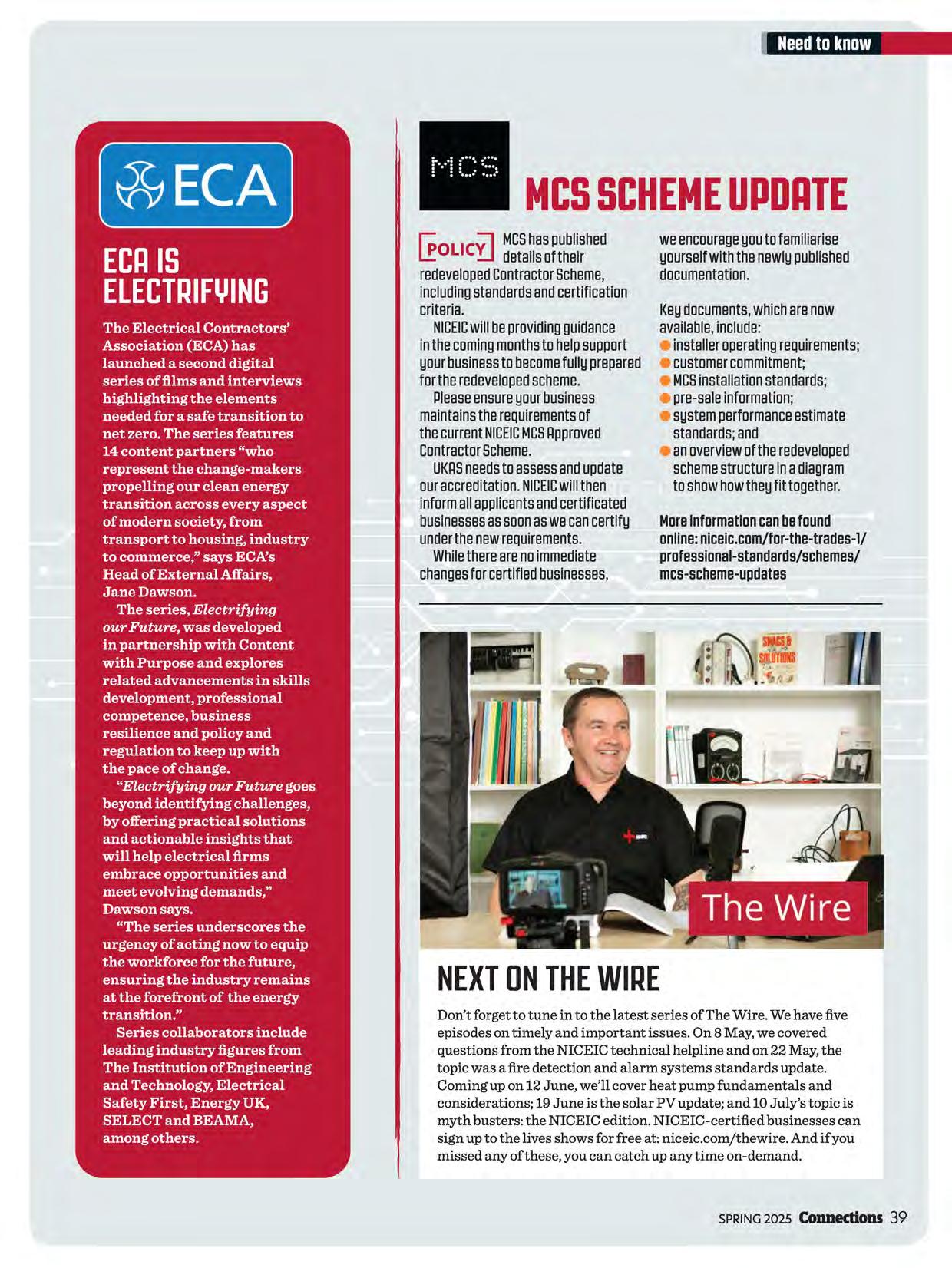
r;oucv1
MCShaspublished L! !J details redeveloped Scheme, includingstandardsandcertification criteria.
NICEICwillbeprovidingguidance intheearning helpsupport business becamefullyprepared fartheredevelopedscheme. Pleaseensure business maintainstherequirements af thecurrentNICEICMCSApproved Scheme.
accreditation.NICEICwillthen informallapplicantsandcertificated businessesas aswecancertify underthenewrequirements. Whilethereare immediate changesfarcertifiedbusinesses,
weencourage tafamiliarise thenewlypublished
Keydocuments,whichare available,include:
• installeroperatingrequirements;
• customercommitment;
• MCSinstallationstandards;
• pre-sale
• systemperformanceestimate standards;and
• anoverview theredeveloped schemestructureinadiagram shawhawtheyfit together.
More canbefound online:niceic.com/for-the-trades-1/ professional-standards/schemes/ mes-scheme-updates
Don't forget to tune in to the latest series of The Wire. We have five episodes on timely and important issues. On 8 May, we covered questions from the NICEIC technical helpline and on 22 May, the topic was a fire detection and alarm systems standards update. Coming up on 12 June, we'll cover heat pump fundamentals and considerations; 19 June is the solar PV update; and 10 July's topic is myth busters: the NICEIC edition. NICE IC-certified businesses can sign up to the lives shows for free at: niceic.com/thewire. And if you missed any of these, you can catch up any time on-demand.
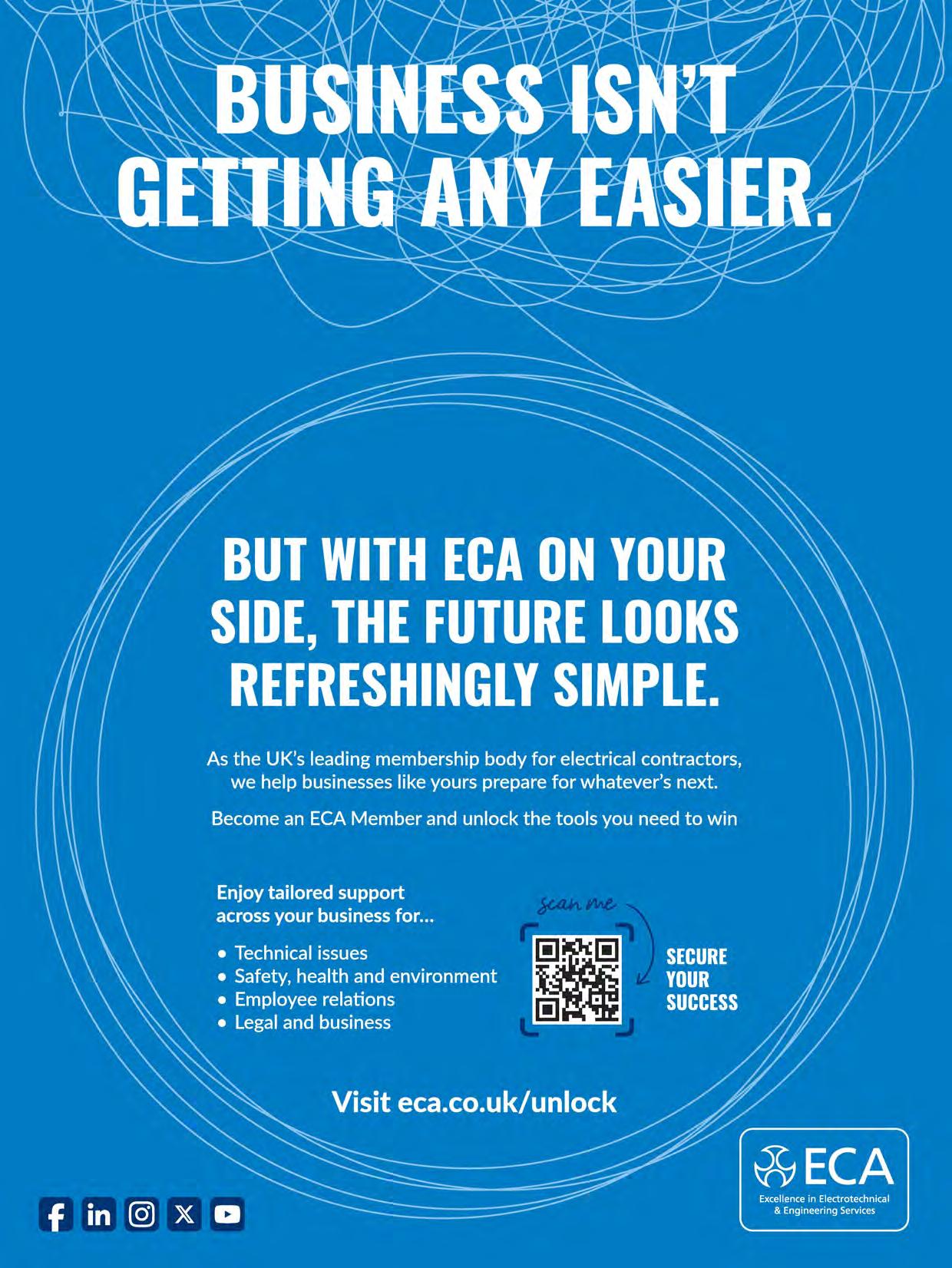
In 2020, the EAS required all electrotechnical certification bodies, including NICEIC, to mandate Continuous Professional Development (CPD). As a result, all electrotechnical businesses registered with a certification body must provide documented evidence showing that all employed persons, including subcontractors, are undertaking CPD.
CPD can take many forms, such as reading the technical articles in this magazine, engaging with free webinars offered by NICEIC and ECA, and undertaking formal training.
Thanks to your certification with NICEIC, you can have exclusive access to a 3-month free trial of ECA's range of digital tools designed to help you document CPD efficiently.
ECA is offering a free trial of two of its leading products to businesses that meet ECA's membership criteria*
eCOMs is an easy-to-use software tool that allows you to document CPD and track operative training, helping your business stay compliant, demonstrate competence, and support workforce development with clear records and reminders. Find out more at www.eca.eo.uk/ecoms
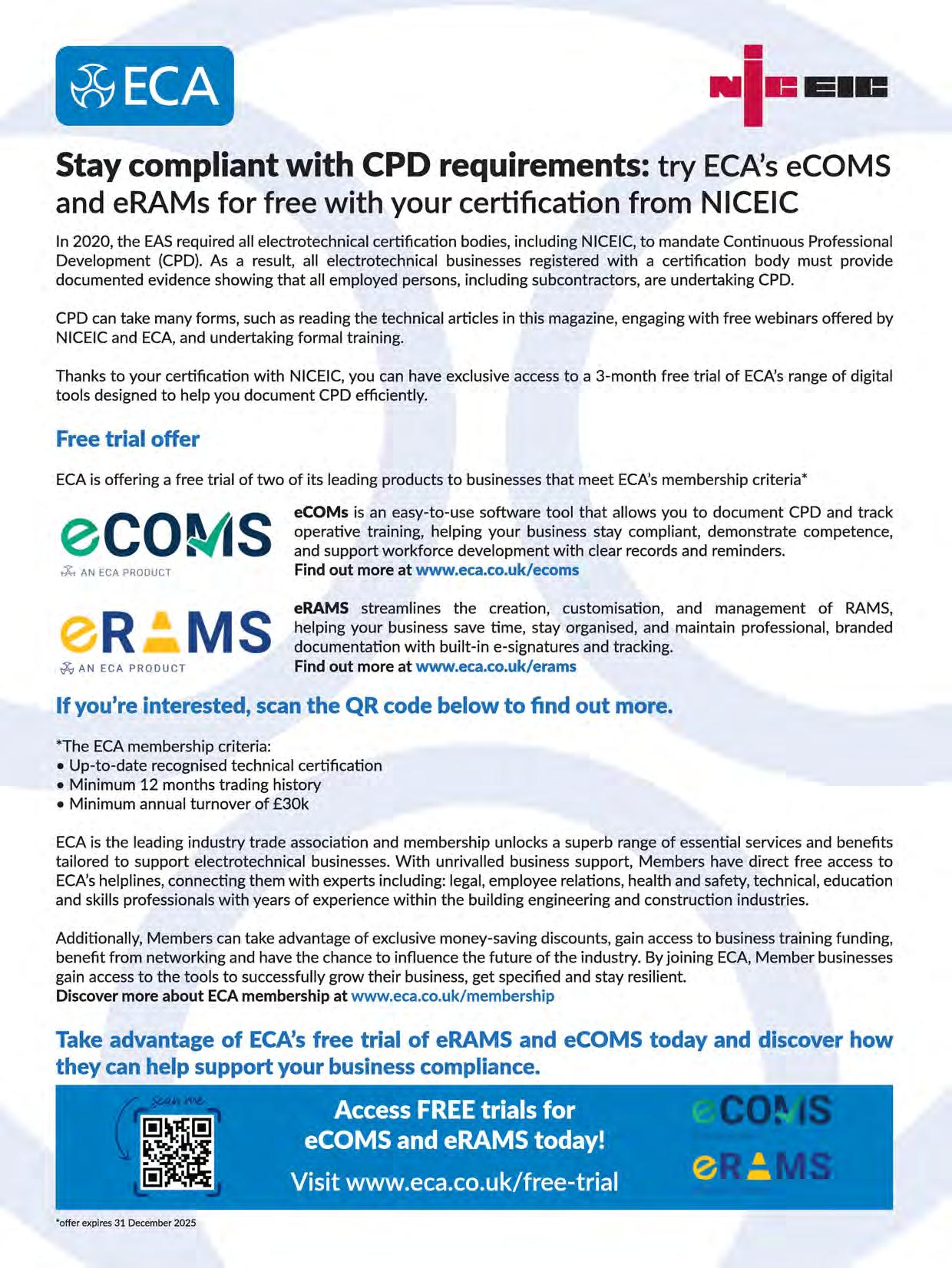
eRAMS streamlines the creation, customisation, and management of RAMS, helping your business save time, stay organised, and maintain professional, branded documentation with built-in e-signatures and tracking. Find out more at www.eca.eo.uk/erams
Ifyou'reinterested,scantheQRcodebelowtofindoutmore.
*The ECA membership criteria:
• Up-to-date recognised technical certification
• Minimum 12 months trading history
• Minimum annual turnover of £30k
ECA is the leading industry trade association and membership unlocks a superb range of essential services and benefits tailored to support electrotechnical businesses. With unrivalled business support, Members have direct free access to ECA's helplines, connecting them with experts including: legal, employee relations, health and safety, technical, education and skills professionals with years of experience within the building engineering and construction industries.
Additionally, Members can take advantage of exclusive money-saving discounts, gain access to business training funding, benefit from networking and have the chance to influence the future of the industry. By joining ECA, Member businesses gain access to the tools to successfully grow their business, get specified and stay resilient. DiscovermoreaboutECAmembershipatwww.eca.co.uk/membership
TakeadvantageofECA'sfreetrialofeRAMSandeCOMStodayanddiscoverhow theycanhelpsupportyourbusinesscompliance.
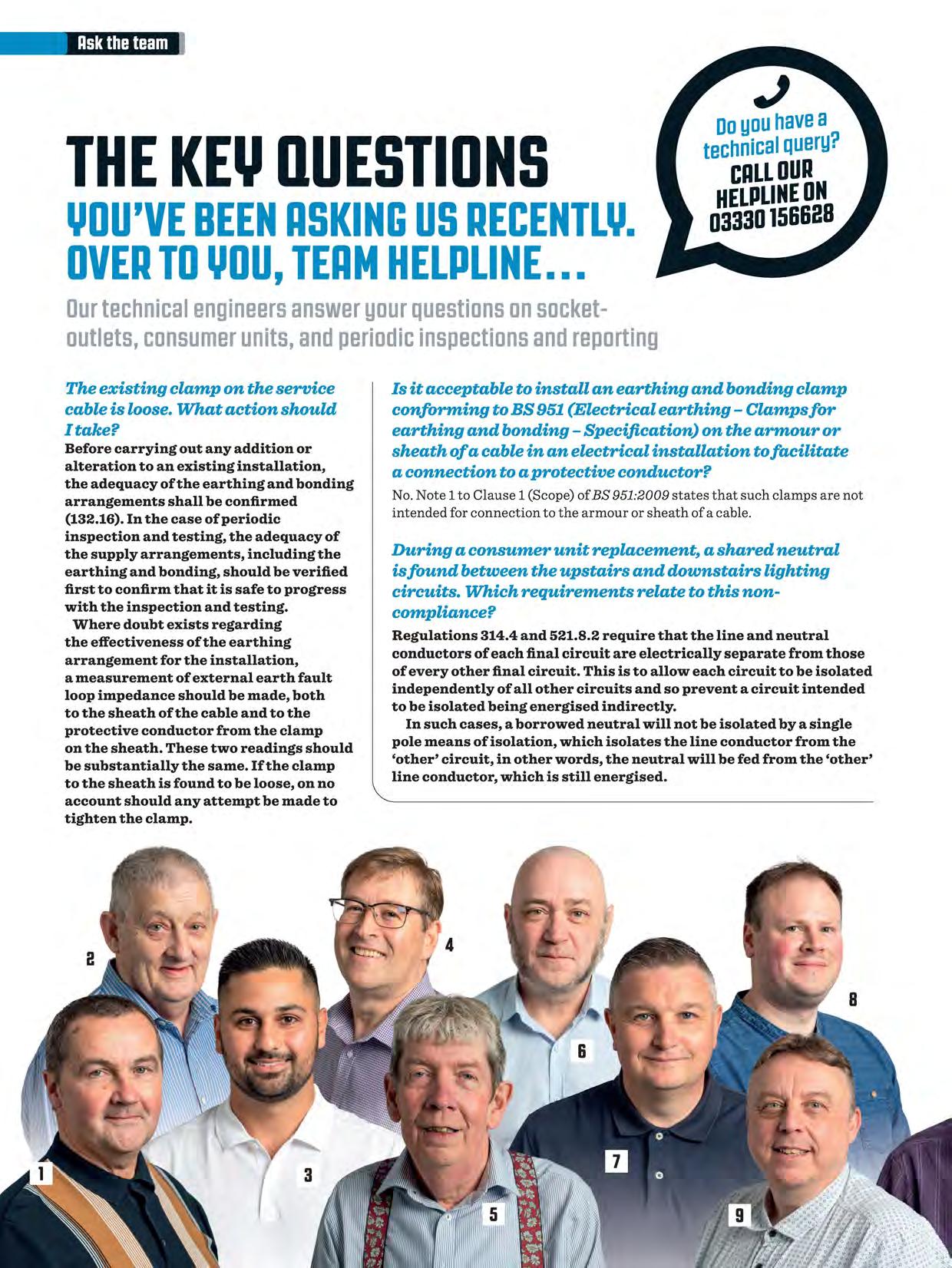
OurtechnicalengineersansweryourQuestionsansacketautlets,consumerunits,andperiodicinspectionsandreporting
The existing clamp on the service cable is loose. What action should Itake?
Before carrying out any addition or alteration to an existing installation, the adequacy of the earthing and bonding arrangements shall be confirmed (132.16). In the case of periodic inspection and testing, the adequacy of the supply arrangements, including the earthing and bonding, should be verified first to confirm that it is safe to progress with the inspection and testing. Where doubt exists regarding the effectiveness of the earthing arrangement for the installation, a measurement of external earth fault loop impedance should be made, both to the sheath of the cable and to the protective conductor from the clamp on the sheath. These two readings should be substantially the same. If the clamp to the sheath is found to be loose, on no account should any attempt be made to tighten the clamp.
Is it acceptable to install an earthing and bonding clamp conforming to BS 951 (Electrical earthing - Clamps for earthing and bonding - Specification) on the armour or sheath of a cable in an electrical installation to facilitate a connection to a protective conductor?
No. Note 1 to Clause 1 (Scope) of BS 951:2009 states that such clamps are not intended for connection to the armour or sheath of a cable.
During a consumer unit replacement, a shared neutral is found between the upstairs and downstairs lighting circuits. Which requirements relate to this noncompliance?
Regulations 314.4 and 521.8.2 require that the line and neutral conductors of each final circuit are electrically separate from those of every other final circuit. This is to allow each circuit to be isolated independently of all other circuits and so prevent a circuit intended to be isolated being energised indirectly. In such cases, a borrowed neutral will not be isolated by a single pole means of isolation, which isolates the line conductor from the 'other' circuit, in other words, the neutral will be fed from the 'other' line conductor, which is still energised.
'When changing a consumer unit, do we have to test insulation resistance at 500 Vfor existing circuits or is it acceptable to test at 250 Vin case of vulnerable equipment?
Electrical Safety First's publication
Best Practice Guide 1. Replacing a consumer unit in residential and similar premises recommends, in section seven covering inspection, testing and certification, that a measurement of the combined insulation resistance of all the circuits in the installation is made.
It further advises that the measurement need only be made between the line and neutral conductors connected together and the protective conductor connected to the earthing arrangement, to avoid potential damage to any electronic components. Dependent on the number of circuits, it may not be physically possible to make a reliable connection to all live conductors simultaneously. Where this is the case, circuits should be tested individually.
The guidance does not state what test voltage should be used. Unless it can be confirmed that all vulnerable equipment has been disconnected, then a test voltage of 250 V DC should be applied to low-voltage circuits.

Is additional protection by means of anRCD of rated residual operating current (111n) not exceeding 80 mA required for all exterior lights of a domestic (household) premises?
Yes. Regulation 411.3.4 of BS 7671 requires additional protection by an RCD with a rated residual operating current not exceeding 30 mA to be provided for any AC final circuits supplying luminaires in domestic (household) premises.
The term 'domestic premises' includes any associated garden, yard, garage and the like within the boundaries of the premises.
A metal consumer unit conforming toBSEN614898 has been installed to achieve conformity with the requirement in 421.1.201/or noncombustibility. On completion of the work, is fire sealing required around cable entries?
No. However, any ingress rating of the enclosure must be maintained after the installation of cables. In general, as the consumer unit enclosure is providing basic protection, this equates to:
• IPXXB or IP2X for the back, front, bottom and side surfaces; and
• IPXXD or IP4X for the horizontal top surface.
Increased ingress protection may be required where the equipment is installed outdoors or in a special installation or location within the scope of a section in Part 7 of BS 7671.
NICE IC Pocket Guide 14 'IP Codes' summarises the information given in BS EN 60529:1992+A2:2013 Degrees of protection provided by enclosures (IP Code). The NICEIC Pocket Guides App is available on both Android and iOS.
Are the requirements for supporting cables against premature collapse of BS 7671 applicable to data and telecommunication cables?
Yes. Indent (vi) of Regulation 110.1.2 confirms that BS 7671 includes requirements for fixed wiring for information and communication technology, signalling, control and the like (excluding internal wiring of equipment).
Regulation 521.10.202 requires that wiring systems shall be supported such that they will not be liable to premature collapse in the event of a fire. This includes data and telecommunications cables. Informative note one to this requirement confirms that the intent of the requirement includes consideration of the possible hindrance of evacuation or firefighting activities by wiring systems, which prematurely collapse.
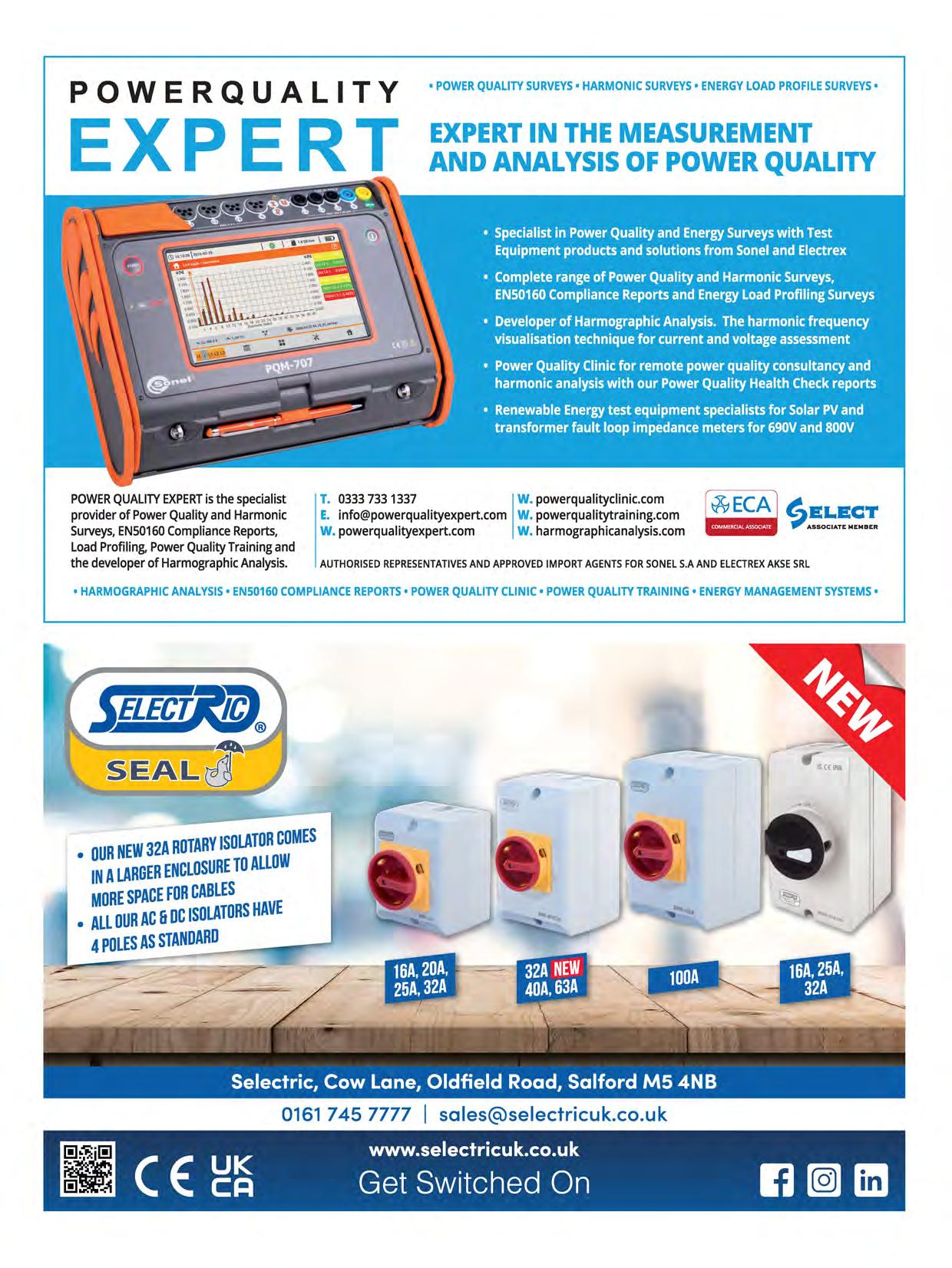
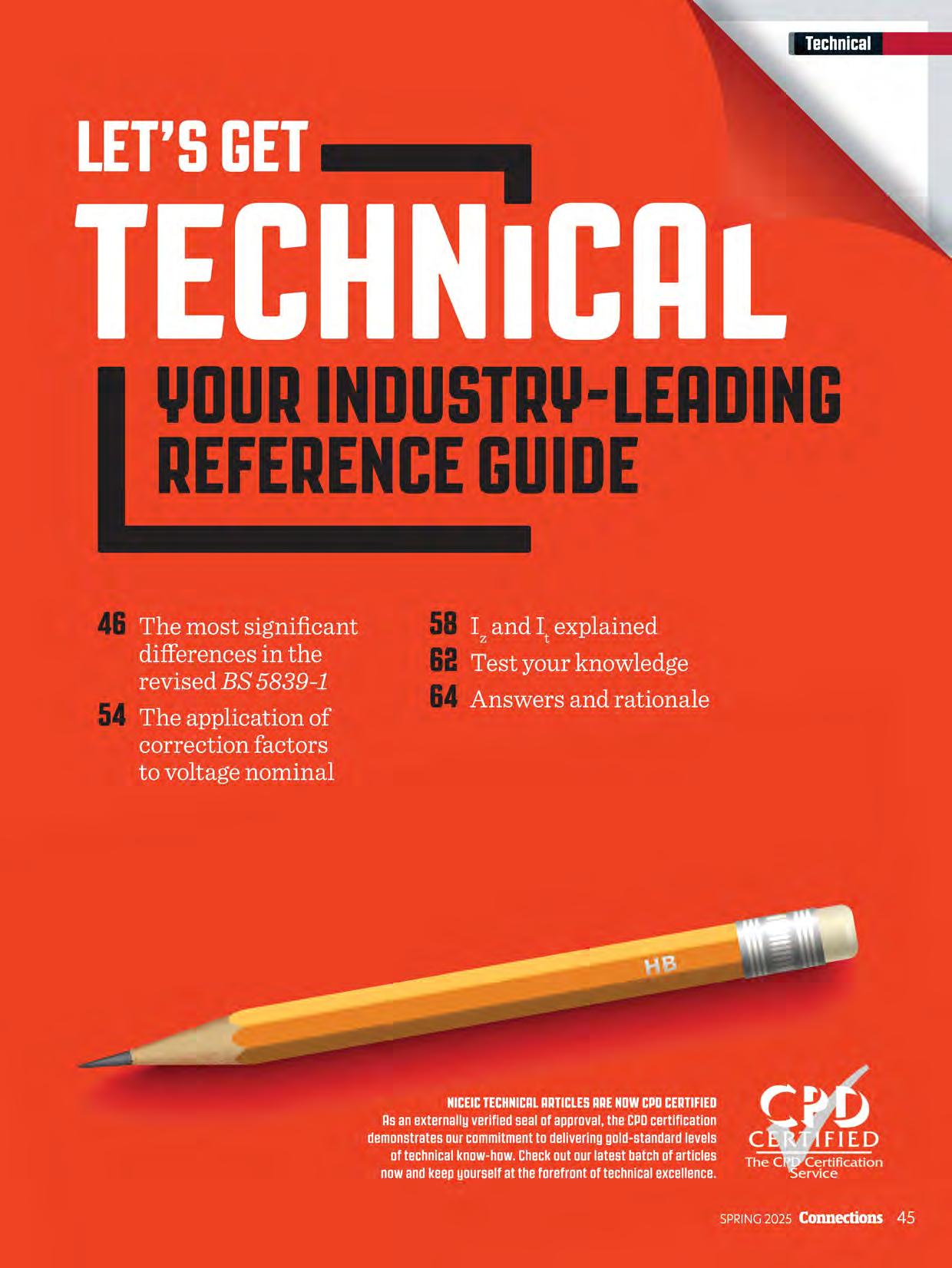
Aneweditionof BS5839-1waspublishedattheendof April2025.Thisarticlehighlightsthemostsignificant differencesintroducedinthenewedition.
A full revision of BS 5839-1 Design, installation, commissioning and maintenance of systems in non-domestic premises - Code of practice was published at the end of April 2025. This new edition supersedes the 2017 edition, which is now withdrawn.
The new edition introduces many changes when compared to the previous 2017 version. Some of the restructuring and editorial amendments were necessary due to changes in the drafting rules for British standards. Additionally, a number of important changes have been made for technical reasons to align with the vocabulary used in other fire safety standards and to respond to fire incidents and occurrences at premises.
This article will describe the changes made for editorial reasons and summarise the technical changes introduced with greater emphasis placed on those changes considered most significant to users of the standard.
Table 1 summarises the changes to language usage that have been made throughout the new edition.
The layout of some contents of the standard has been rearranged. It now contains a foreword and eight sections rather than the seven in the previous edition. Within these sections, some existing clauses have been relocated:
• Clause 4 (Need for a fire detection and fire alarm system and type of system) from the 2017 edition has
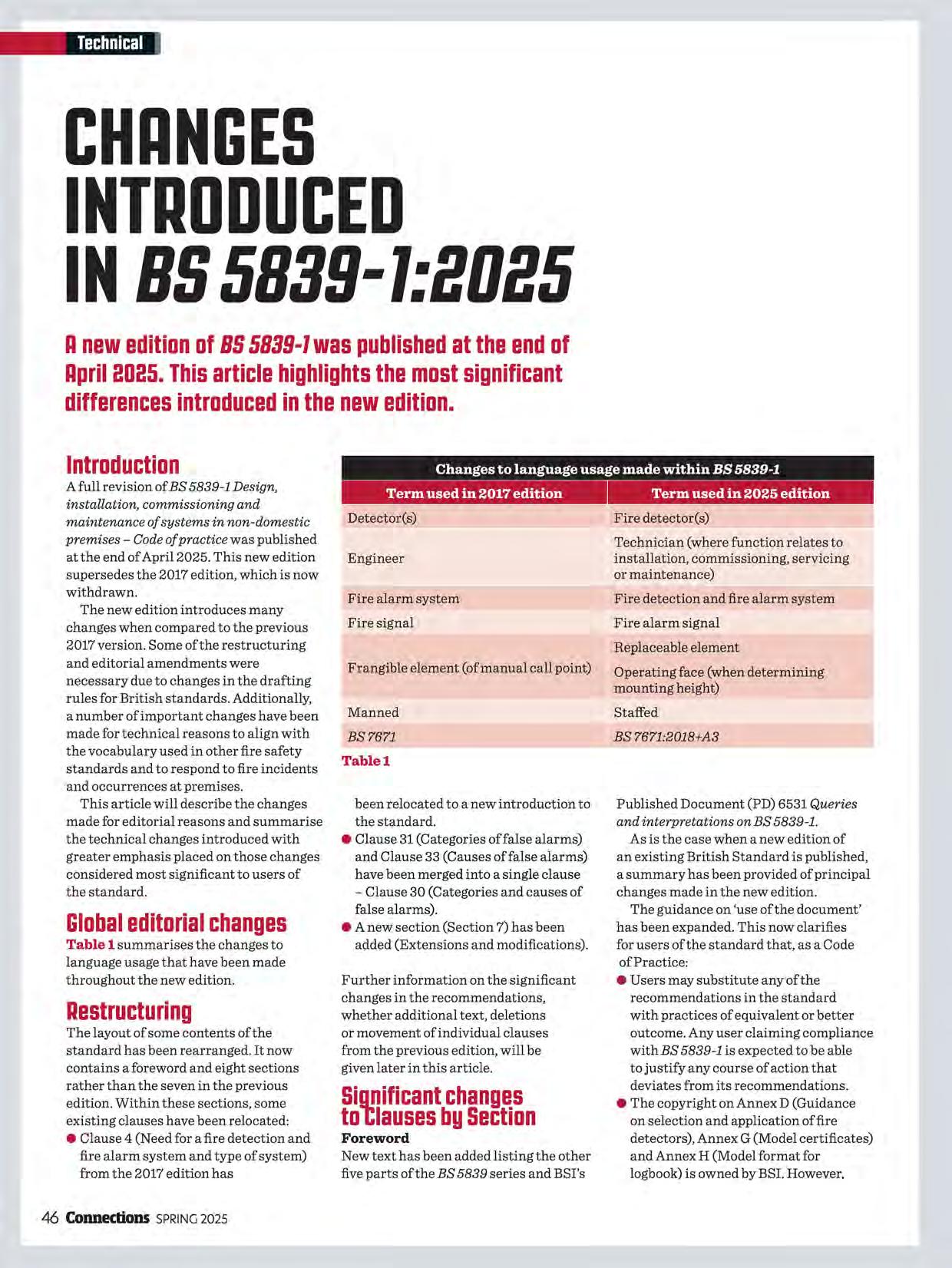
Detector(s)
Engineer
Fire alarm system
Fire signal
Frangible element (of manual call point)
Manned
BS7671
Tablel
been relocated to a new introduction to the standard.
• Clause 31 (Categories of false alarms) and Clause 33 (Causes of false alarms) have been merged into a single clause -Clause 30 (Categories and causes of false alarms).
• A new section (Section 7) has been added (Extensions and modifications).
Further information on the significant changes in the recommendations, whether additional text, deletions or movement of individual clauses from the previous edition, will be given later in this article.
Foreword
New text has been added listing the other five parts of the BS 5839 series and BSI's
Fire detector(s)
Technician (where function relates to installation, commissioning, servicing or maintenance)
Fire detection and fire alarm system
Fire alarm signal
Replaceable element
Operating face (when determining mounting height)
Staffed
BS 7671:2018+A3
Published Document (PD) 6531 Queries and interpretations on BS 5839-1.
As is the case when a new edition of an existing British Standard is published, a summary has been provided of principal changes made in the new edition. The guidance on 'use of the document' has been expanded. This now clarifies for users of the standard that, as a Code of Practice:
• Users may substitute any of the recommendations in the standard with practices of equivalent or better outcome. Any user claiming compliance with BS 5839-1 is expected to be able to justify any course of action that deviates from its recommendations.
• The copyright on Annex D (Guidance on selection and application of fire detectors), Annex G (Model certificates) and Annex H (Model format for logbook) is owned by ESL However,
users of the standard are permitted to make an unlimited number of copies for their use without infringement of copyright.
• It is not necessary to use the models in the annexes in order to meet the recommendations in the standard.
NICEIC produce a range of certificates based on the models in BS 5839-1. Visit shop.niceic.com
A new introduction has been added explaining the purpose of a fire detection and fire alarm system. Text from Clause 4 (Need for a fire detection and fire alarm system) and Clause 6 (Exchange of information and definition of responsibilities) of the preceding edition have been relocated to this introduction. Clause 2, listing normative references within the standard, has been updated, resulting in the deletion of a number of standards no longer referred to and the addition of newly referenced standards, including BS 5446-3 (Specification for fire alarm and carbon monoxide alarm systems for deaf and hard of hearing people); BS EN 54-22 (Resettable linetype heat detectors); BS EN 54-28 (Nonresettable line-type heat detectors); and BS EN 60079-17 (Explosive atmospheres. Electrical installations inspection and maintenance).
Definitions
The definition of competent person has been modified to reflect the competence requirements introduced in Section 35 of the Building Safety Act 2022. Notably this definition now differs from the definition of competent person given in BS 5839-6, which will likely be amended when that standard is next reviewed.
person, suitably trained and qualified by knowledge and practical experience, and provided with the necessary instructions, to enable the required task(s) to be carried out correctly.
NOTE Maintenance of competence is likely to require continuing professional development (CPD).
New definitions have been added for: Place of relative safety place in which there is no immediate danger, but in which there could be future danger, from fire and smoke or the effects of fire and smoke.
Place of ultimate safety place in which there is no immediate or future danger from fire and smoke or the effects of fire and smoke.
A number of other definitions have been modified, including those for 'voice alarm system' and 'voice sounder'.
Previously, Clause 4 was called 'Need for a fire detection and fire alarm system'. This matter is now covered in the introduction to Section 1.
Significant changes in content when compared to the equivalent clause (Clause 5) in the 2017 edition include:
• Clause 4.1 recommends that where a category of system is stipulated in the requirements imposed by an enforcing authority, by property insurers or by the purchaser of the system, that category should be used.
• Clause 4.2 clarifies that where the designer has not been informed as to the category of system required (see 4.1), they should make clear, to the purchaser or their agent, the category of system to which their design would conform, so that the purchaser or their agent can take further advice as to whether that category would be compatible with any fire strategy for the premises.
• Clause 4.6 calls for consideration as to whether it might be beneficial to provide manual call points where a Category P (property protection) system is to be installed.
Much of the content of this clause was situated in Clause 6 of the 2017 edition. Significant changes include the following:
• 5.4 where a designer has made a proposal for the category of system, this should be discussed and agreed with the user or purchaser.
• 5.5 the designer should determine from the user or purchaser whether the fire detection and fire alarm system will incorporate one or more visual alarm devices.
• 5. 7 the responsibility for the provision
of a zone plan should be clearly defined, documented and also agreed prior to an order being placed for the system.
Clause 6. Variations from the recommendations of this document Changes have been made to the guidance on use of variations within the commentary. This now relates to both installation and maintenance.
A statement has been added to Clause 6 clarifying the need to take care, when specifying variations, that these do not undermine the system objective, whether to protect life or property.
The technical intent of Clause 6.5 (formerly in Clause 7.2e)) has been changed. Whereas previously only major non-compliances had to be recorded in the logbook, the new edition recommends that all variations are clearly recorded in the logbook so that they are readily available for future reference by maintenance companies and any other interested parties.
Possibly the most significant change introduced in the 2025 edition is the inclusion of a new Clause 6.6 relating to unacceptable variations. This was introduced due to several fires resulting in fatalities:
6.6 The following departures from the recommendations of this part of BS 5839 are likely to be so detrimental to the safety oflife that they should not be regarded as acceptable variations:
a) the absence of a zone plan (or other suitable diagrammatic representation as recommended in 22.2.5) in premises in which there is more than one zone on any storey, particularly premises in which people sleep;or
b) the absence of a facility for transmission of fire alarm signals to an ARC in either:
1) supported housing in which the facility is considered necessary to meet the recommendations of BS 5839-1 (where a Grade A system according to BS 5839-6:2019 is necessary); or 2) a residential care home.
Thisfirealarmsystemhas anactiveconnectionto thefireandrescueservice
ContactTelephone :
Fig 1 Typical false alarm notice
Clause 7. Relationship between system category and protected areas
A significant change has been made in indent a). The recommendation no longer applies to 'buildings in which people sleep'. It now refers to 'buildings with rooms accessed by corridors'.
Clause 8. Actuation of other fire protection systems or safety facilities
A new clause (8.5) has been added, giving recommendations for the siting of fire detection and alarm system interfaces in an accessible position.
Clause 9. Systems in explosive gas or dust atmospheres
Clause 9.1 now relates to installation only. Similarly, Clause 9.2 now only relates to maintenance.
Clause 11. Monitoring, integrity and reliability of circuits external to control equipment
A note has been added to Clause 11.2.2a) clarifying that the area of2,000 m 2 cited is based on the maximum dimensions of a zone.
Clause 12. Detection zones
The commentary now refers to 'location descriptors' rather than 'text displays'. Clause 12.5.1 now states that any visual indication given by remote fire indicators should be red.
Clause 14. Communication with the fire and rescue service
A new clause (14.10) has been added stating what information about the

Fig 2 Sign indicating areas where hearing protection must be worn
protected premises, such as whether they contain sleeping accommodation, should be provided to alarm receiving centres (ARC). It further recommends that, wherever practicable, the alarm signal transmitted to the ARC should indicate the nature of the device that triggered the signal and whether more than one device has operated.
A new clause (14.17) recommends that, for Category L systems, in the event of a fire alarm signal, an indication should be received at the ARC within a maximum of90 seconds and a catastrophic failure of the transmission system (that is, no alarm signals can be transmitted) should be indicated at the ARC and the control and indicating equipment (CIE) within three minutes. A further new clause (14.18) states that for Category P systems, in the event of a fire alarm signal, an indication should be received at the ARC within a maximum of120 seconds and a catastrophic failure of the transmission system should be indicated at the ARC and the CIE within 31 minutes.
Additional information regarding the use of different technologies to provide the dual paths for alarm transmission equipment or in the alarm transmission path has been added to the note to Clause 14.20.
Anew note 1 to Clause 14.21a) clarifies that BS 5839-1 does not address cybersecurity.
A new clause (14.22) has been added stating that a label as shown in Fig 1 should be provided where the system is capable of providing automatic transmission of alarm signals to an ARC.
A new Clause 15.1.2 has been added for areas with an emergency voice
communication system outstation or master panel. This includes a note stating that, where there is a reduced sound pressure level in such locations so as not to interfere with telephone speech, a visual alarm device can be used to supplement the audible alarm signal.
New text has been added to the commentary in respect of provision of visual alarm devices in areas in which people who are deaf or have a hearing impairment are likely to be alone, such as toilets or plant rooms.
Clause 16.1 states that visual alarm signals should be provided in areas where ambient noise levels exceed 90 dB(A) and where hearing protection is likely to be used in normal circumstances.
A note to this clause advises that such areas are normally identified by the sign shown in the new Figure (7), reproduced here as Fig 2.
Changes have been made in Clause 17.1.3 (formerly 18.2.lc)). Previously, this clause stated that the intensity and output of tactile devices intended to rouse persons from sleep should be sufficient to attract attention, it now calls for conformance with several clauses in BS 5446-3:2015, Detection and alarm devices for dwellings - Part 3: Specification for fire alarm and carbon monoxide alarm systems for deaf and hard of hearing people.
A number of technical changes have been made in Clause 17.2.5 (formerly 18.2.2c)) as shown below:
In a fire condition, the transmission equipment should either:
a) continue transmitting the alarm signal to the portable alarm devices until the alarm is cancelled by a signal from the fire alarm control equipment; or b) send the alarm signal repeatedly at periods not exceeding 10 s until the alarm is cancelled by a signal from the fire alarm control equipment. The previous notes 1 and 2 have been deleted, leaving a single note (previously note 3), which is unchanged:
NOTE In the context of this recommendation, cancellation of the alarm signal from the fire alarm control equipment might, for example, constitute the resetting of a relay at the fire alarm control equipment.
A new clause (18.2.3) has been added regarding delays to the summoning of the fire and rescue services (FRS) in premises other than residential care homes. This states that if the FRS has not been summoned immediately at the onset of an investigation period associated with a staff alarm, they should be summoned immediately at the conclusion of this period, unless the investigation has confirmed that the fire alarm signal was a false alarm.
A new note to Clause 18.2.8 states that it is not appropriate to arrange a staff alarm involving a delay in summoning the FRS in residential care homes, reinforcing the recommendation given in Clause 18.2.2.
A new note has been added to Clause 19.4 stating that manual call points are not located on stairway landings in multistorey buildings with phased evacuation as so doing could result in persons travelling down the stairway operating a manual call point several floors below that on which a fire is located, resulting in evacuation ofinappropriate areas.
Clause 19.8 has been amended to include a margin of tolerance in manual call point mounting height.
It now states that they should be fixed at a height ofl.4 m +0.2/-0.3 m above finished floor level to the centre of the MC P's operating face.
A note has been added to Clause 19.10 stating that the use of an emergency voice
alarm instead ofMCPs in a public car park is likely to be subject to approval by the relevant enforcing authority.
Clause 20. Types of fire detector and their selection
This clause now includes expanded guidance on the following types of fire detector:
eHeat
• Smoke
• Combustion gas eFlame
• Multi-sensor eVideo.
A significant addition has been made to the commentary on Clause 20.
In previous versions of this part of BS 5839, it was considered acceptable to install heat detectors within bedrooms located off corridors.
The reasons for this are historical. The detectors were, traditionally, installed to protect those beyond a bedroom of fire origin, rather than those within that bedroom itself. It was proved that heat detectors would be effective in achieving that objective, while having greater immunity to false alarms than other types of fire detector. Given advances in fire detection technology, and prohibition of smoking in the majority of hotel bedrooms, it is now considered that preference ought to be given to types of fire detection, other than heat detection, thereby reflecting the most common current custom and practice.
This does not imply that, in systems with heat detectors in existing bedrooms (e.g. ofhotels), the heat detection needs to be replaced. However, when these systems are, substantially, or completely, replaced, or are extended, preference ought to be given to use of smoke, multisensor or carbon monoxide fire detectors, unless a fire risk assessment justifies the use of heat detection.
Where a sprinkler head is to be used as a heat detector, Clause 21.2.6 now states that, to avoid confusion regarding the location of a sprinkler that operated and other fire detection zones, the sprinkler zone should not overlap more than one such fire detection zone. This will require close liaison with those designing the sprinkler system if it is to be achieved.
Moving on to power supplies, the note to Clause 24.3.4 now clarifies that where larger batteries than necessary to reach the capacity recommended in 24.3.5 for standby supplies are installed, they need not be fully charged within 24 hours. However, connecting larger batteries than originally designed can result in unacceptably long recharge times.
Clause 28. Electrical earthing
A new Clause (28.2) states that any functional earthing conductors should be identified in accordance with Table 51 of BS 7671:2018+A3. An accompanying note states that FE conductors are identified by the colour pink or by the alphanumeric marking 'FE'.
Clause 28.5 has been amended such that its recommendations for the power supplies for extra-low voltage supplies in certain locations of increased shock risk align with those of BS 7671.
Clause 29. Responsibility for false alarms and unwanted fire alarm signals
Throughout this clause, greater emphasis has been given to the responsibilities of the user of the system, clarifying that where issues arise during the design, installation, commissioning or verification stages, relevant information on potential causes of false alarms or unwanted fire alarm signals are passed on to the user. In short, the standard's recommendations are to inform the user of their responsibilities rather than to give direct instructions to the user.
Clause 31. Investigation of false alarms
The commentary now includes a statement that, as part of the investigation
Givingyouaccesstotheindustry's besttechnicalmindsandresources
Technicalhelplinefor expert support with installations, compliance and products.
NICEICPocketGuidesapp with 37+ technical guides.
CPDresourcesincluding The Wire webinars, NICEICevents, quarterly Connections magazine, live Technical Q&As and our monthly Circuit e-newsletter.
Regularassessmentsto help you stay compliant, with guidance and technical advice.
10%discountonin-personandonline trainingplusqualificationscovering everything from electrical, renewables to emergency lighting and fire alarms.
NICEICOnlineCertificationSystem saving you time and money by self-certifying your work and completing and sending certificates and reports.
Savingson specialist, tailored trade insurance.
Discountson branded NICEICworkwear and tools in our online shop and 10% off selected purchases at TradePoint.
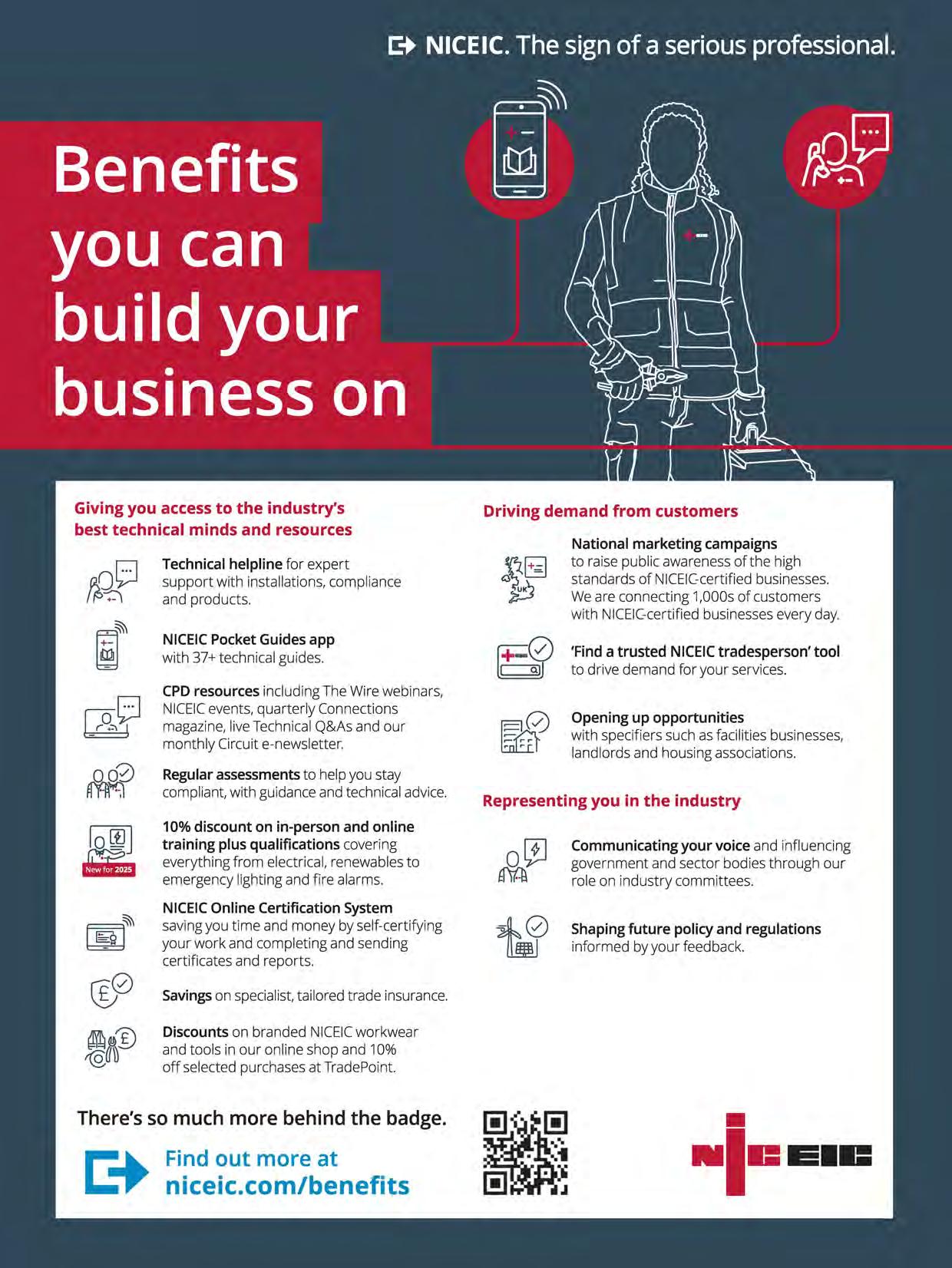
Nationalmarketingcampaigns to raise public awareness of the high standards of NICEIC-certified businesses. We are connecting 1,000s of customers with NICEIC-certified businesses every day.
'FindatrustedNICEICtradesperson'tool to drive demand for your services.
Openingupopportunities with specifiers such as facilities businesses, landlords and housing associations.
Representingyouintheindustry
Communicatingyourvoice and influencing government and sector bodies through our role on industry committees.
Shapingfuturepolicyandregulations informed by your feedback.
into false alarms during a service visit, the service organisation ought to review the causes of false alarms identified by the user and to recommend methods to mitigate the rate of false alarms.
A new indent d) to Clause 38.1 calls for a cause-and-effect matrix or text description of how the cause and effect operates to be provided to the purchaser or user of the system.
Clause 42.1.3 recommends that for systems without manual call points, the weekly test should be carried out using another suitable trigger. It further advises that any ARC should be contacted immediately before, and immediately after, the weekly test to avoid unwanted alarms.
Clause 43.2.10 relating to controls and indicators at the C IE has been expanded to now include a recommendation to check and adjust any timeclock.
Clause 43.3.5 gives a new recommendation for functional tests to be carried out on all detectors to determine
whether products of combustion are able to pass unhindered from the protected area and sensing chamber or sensing element of the detector.
Details of the cause and effect tested should be recorded in the logbook (Clause 43.3.21).
Where a fire detection and fire alarm system consists of multiple CIE or repeat CIE, Clause 43.3.22 recommends that at least one fire or fault indication should be initiated on the system and all of the CIE should be inspected to verify that the indications on all of the CIE give the same or a non-conflicting indication. Clause 43.3.25 states that it should be verified that the zone identification reported on the CIE matches the zone identification on the zone plan.
A number of new recommendations have been added in Clause 43.4 (Remote services and cybersecurity).
Several new notes have been added to Clause 44.1.2.
• Note 4 to Clause 44.1.2 o) states that the absence of an automatic facility to
The following additions and changes (shown in red text) have been made to Table A.1:
Large public houses with no residential accommodation
Healthcare premises without sleeping accommodation, e.g. walk-in healthcare centres TableA.1
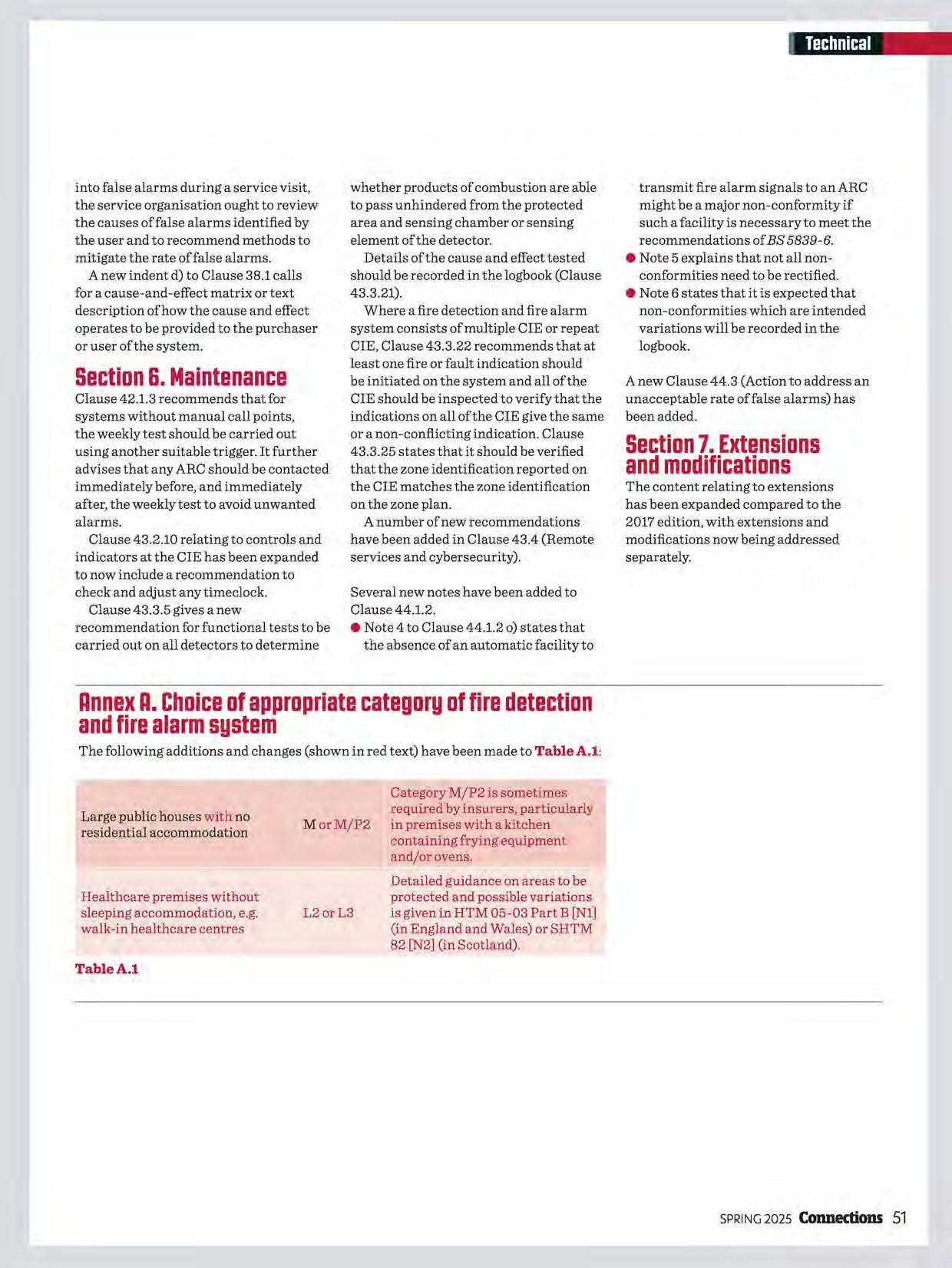
Category M/P2 is sometimes required by insurers, particularly Mor M/P2 in premises with a kitchen containing frying equipment and/or ovens.
Detailed guidance on areas to be protected and possible variations L2 or L3 is given in HTM 05-03 Part B [Nl] (in England and Wales) or SHTM 82 [N2] (in Scotland).
transmit fire alarm signals to an ARC might be a major non-conformity if such a facility is necessary to meet the recommendations of BS 5839-6.
• Note 5 explains that not all nonconformities need to be rectified.
• Note 6 states that it is expected that non-conformities which are intended variations will be recorded in the logbook.
A new Clause 44.3 (Action to address an unacceptable rate of false alarms) has been added.
The content relating to extensions has been expanded compared to the 2017 edition, with extensions and modifications now being addressed separately.
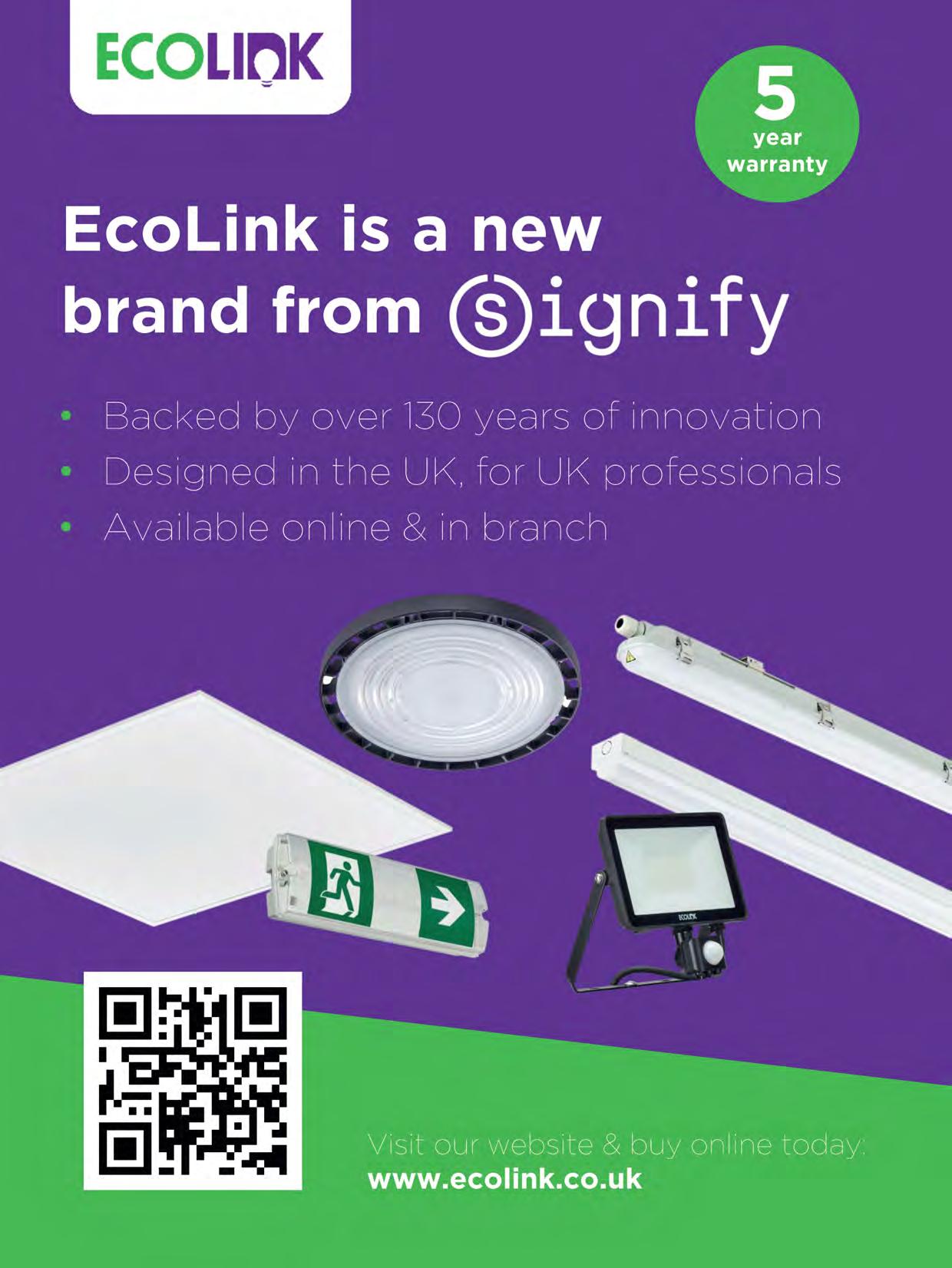
The following additions and changes (shown in red text) have been made to Figure D.1 (Detector selection):
Fire phenomenon cl
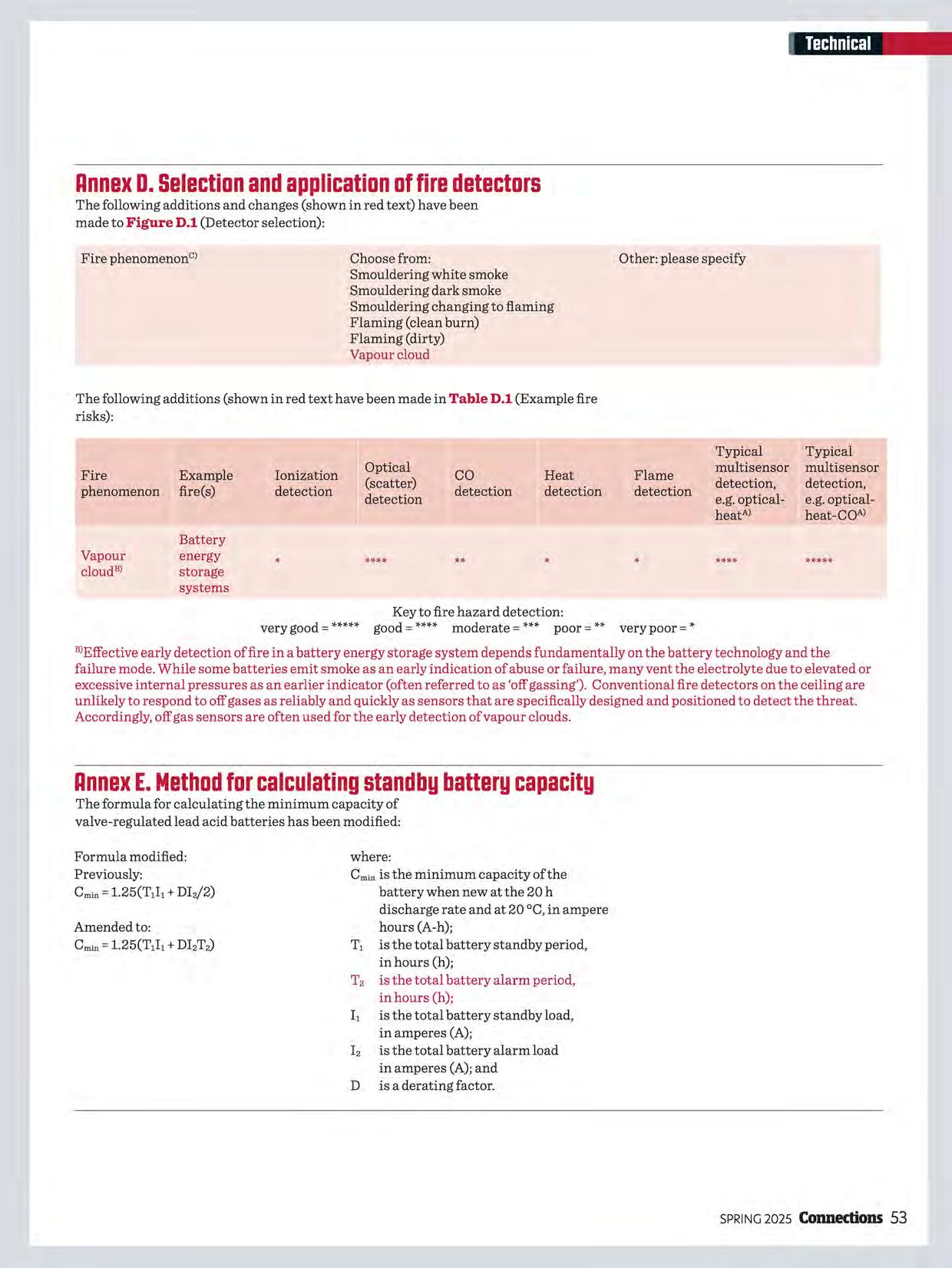
Choose from:
Smouldering white smoke
Smouldering dark smoke
Smouldering changing to flaming
Flaming (clean burn)
Flaming (dirty)
Vapour cloud
The following additions (shown in red text have been made in Table D.1 (Example fire risks):
Fire Example Ionization Optical co Heat phenomenon fire(s) detection (scatter) detection detection detection
Battery
Vapour energy *
cloudB) storage systems
Key to fire hazard detection: very good = ***** good=**** moderate = *** poor=**
Other: please specify
Typical Typical Flame multisensor multisensor detection detection, detection, e.g. optical-e.g. opticalheatAl heat-COAl
**** ***** very poor=*
BlEffective early detection of fire in a battery energy storage system depends fundamentally on the battery technology and the failure mode. While some batteries emit smoke as an early indication of abuse or failure, many vent the electrolyte due to elevated or excessive internal pressures as an earlier indicator (often referred to as 'off gassing'). Conventional fire detectors on the ceiling are unlikely to respond to off gases as reliably and quickly as sensors that are specifically designed and positioned to detect the threat. Accordingly, off gas sensors are often used for the early detection of vapour clouds.
The formula for calculating the minimum capacity of valve-regulated lead acid batteries has been modified:
Formula modified:
Previously:
Cmin= 1.25(T1I1+ DI2/2)
Amended to:
Cmin= 1.25(T1I1+ DlzT2)
where:
Cminis the minimum capacity of the battery when new at the 20 h discharge rate and at 20 °C, in ampere hours (A-h);
T1 is the total battery standby period, in hours (h);
T2 is the total battery alarm period, in hours (h);
I1 is the total battery standby load, in amperes (A);
12 is the total battery alarm load in amperes (A); and D is a derating factor.
Objective:When carrying out electrical calculations that use the system's voltage, an adjustment factor may need to be applied to the nominal voltage as part of the calculation. In some circumstances an allowance may be required to compensate for fluctuations of voltage at an installation, which may be higher or lower than the nominal voltage. This article looks at voltage factors and when to apply them to the nominal voltage as part of an electrical calculation.
The nominal voltage to Earth (U J in the majority of UK electrical installations is given as 230 V. The nominal voltage is used in many circuit calculations; these calculations include determining the maximum permitted impedance of a circuit and also the prospective fault current of a circuit.
The distribution network operators (DNOs) work to a permitted voltage range ofbetween 216.2 V and 253 V. Correction factors should be applied when carrying out electrical calculations when the actual voltage differs from the nominal voltage.
The term 'nominal' means 'named'; the nominal voltage is not the exact voltage of the system. The definition of nominal from the Oxford English Dictionary is provided below.
Nominal
Existing in name only: merely named (without reference to fact or reality); not real or actual. Excerpt from the Oxford English Dictionary.
The nominal voltage to Earth, U 0 , is defined in BS 7671 as the 'nominal AC rms or ripple-free DC line voltage to Earth'.
The actual mains supply voltage of an installation having a nominal voltage
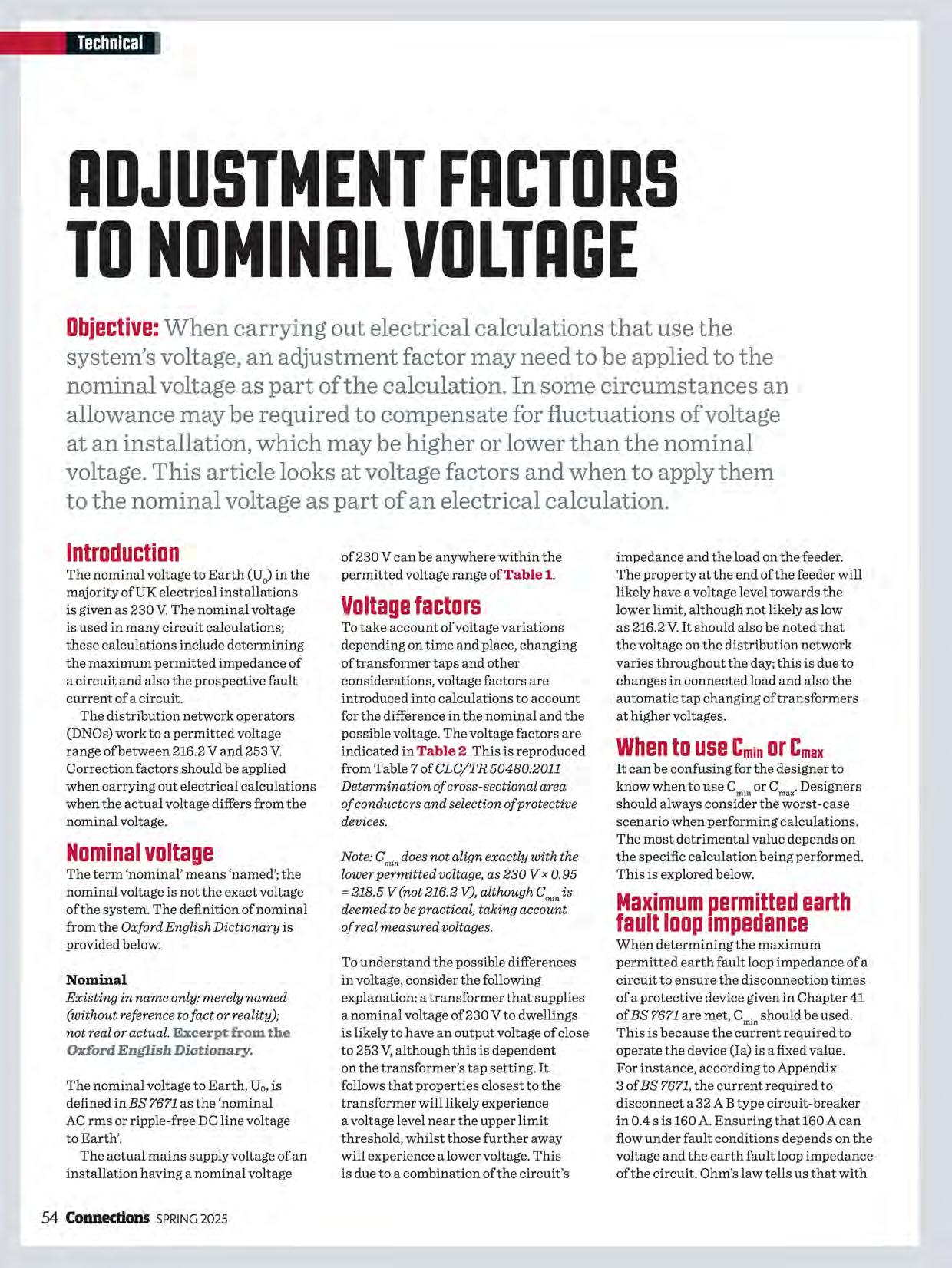
of230 V can be anywhere within the permitted voltage range of Table 1.
To take account of voltage variations depending on time and place, changing of transformer taps and other considerations, voltage factors are introduced into calculations to account for the difference in the nominal and the possible voltage. The voltage factors are indicated in Table 2. This is reproduced from Table 7 of CLC/TR 50480:2011 Determination of cross-sectional area of conductors and selection of protective devices.
Note: Cmin does not align exactly with the lower permitted voltage, as 230 V x 0.95 = 218.5 V (not 216.2 V), although Cmin is deemed to be practical, taking account of real measured voltages.
To understand the possible differences in voltage, consider the following explanation: a transformer that supplies a nominal voltage of230 V to dwellings is likely to have an output voltage of close to 253 V, although this is dependent on the transformer's tap setting. It follows that properties closest to the transformer will likely experience a voltage level near the upper limit threshold, whilst those further away will experience a lower voltage. This is due to a combination of the circuit's
impedance and the load on the feeder. The property at the end of the feeder will likely have a voltage level towards the lower limit, although not likely as low as 216.2 V. It should also be noted that the voltage on the distribution network varies throughout the day; this is due to changes in connected load and also the automatic tap changing of transformers at higher voltages.
It can be confusing for the designer to know when to use Cminor Cmax·Designers should always consider the worst-case scenario when performing calculations. The most detrimental value depends on the specific calculation being performed. This is explored below.
When determining the maximum permitted earth fault loop impedance of a circuit to ensure the disconnection times of a protective device given in Chapter 41 of BS 7671 are met, Cminshould be used. This is because the current required to operate the device (Ia) is a fixed value. For instance, according to Appendix 3 of BS 7671, the current required to disconnect a 32 AB type circuit-breaker in 0.4 sis 160 A. Ensuring that 160 A can flow under fault conditions depends on the voltage and the earth fault loop impedance of the circuit. Ohm's law tells us that with
a fixed impedance, a higher voltage will result in a greater current flow, whereas a lower voltage will result in less current flow with the same impedance. Due to voltage variations on the network, Cmin is used to take account of the possible lower than nominal voltage, this gives a worstcase scenario. Formula 1 is reproduced from Appendix 3 of BS 7671
U 0 × C min
Z s ≤ I a
Where:
Z
s i s the maximum earth fault loop impedance of the device;
U 0 i s the nominal AC rms line voltage to Earth;
I a i s the current in amperes (A) causing operation of the protective device within a specified time; and C min i s the minimum voltage factor to take account of voltage variations depending on time and place, changing of transformer taps and other considerations.
Formula 1 determining the maximum earth fault loop impedance for the protective device Appendix 3 BS 7671
When establishing the breaking capacity of a protective device, the highest fault current is the most detrimental scenario. C max is therefore used to determine the highest possible fault current within the installation when sizing protective devices.
When sizing a conductor using the adiabatic method, the fault current (I f) is a key component of the formula (see Formula 2). This fault current is then used to determine the time (t) it takes for the protective device to operate from the device’s time/current graph (see
Connections autumn 2024, ‘Determining the maximum earth fault loop impedance’). Knowing when to use Cmin or C max depends on the type of protective device used.
Both the minimum and maximum fault current conditions are required, so the highest energy let-through is taken into account (533.3).
√ I 2 × t S = k
Where:
S i s the nominal cross-sectional area of the conductor in mm 2 ;
I i s the value in amperes (rms for AC) of current for a fault of negligible impedance, which can flow through the associated protective device, due account being taken of the current limiting effect of the circuit impedances and the limiting capability (I 2 t) of that protective device;
t i s the operating time of the protective device in seconds corresponding to the fault current I amperes; and

NICEICInsuranceServicesisdesignedspeciallyfortheelectrical trade,withyourbespokepolicycreatedjustforyourbusiness .
Comprehensivecover, butnotfullprice.
10% off insurance for NICEICcertified businesses* .
ReputableUK-basedinsurers.
Specially negotiated prices from UK-based leading insurers and specialist providers.
FREEbusinessinsurancecheck.
While other insurance providers ask you what you want, we advise you what you need. So you don't pay for cover you don't need. Simple.
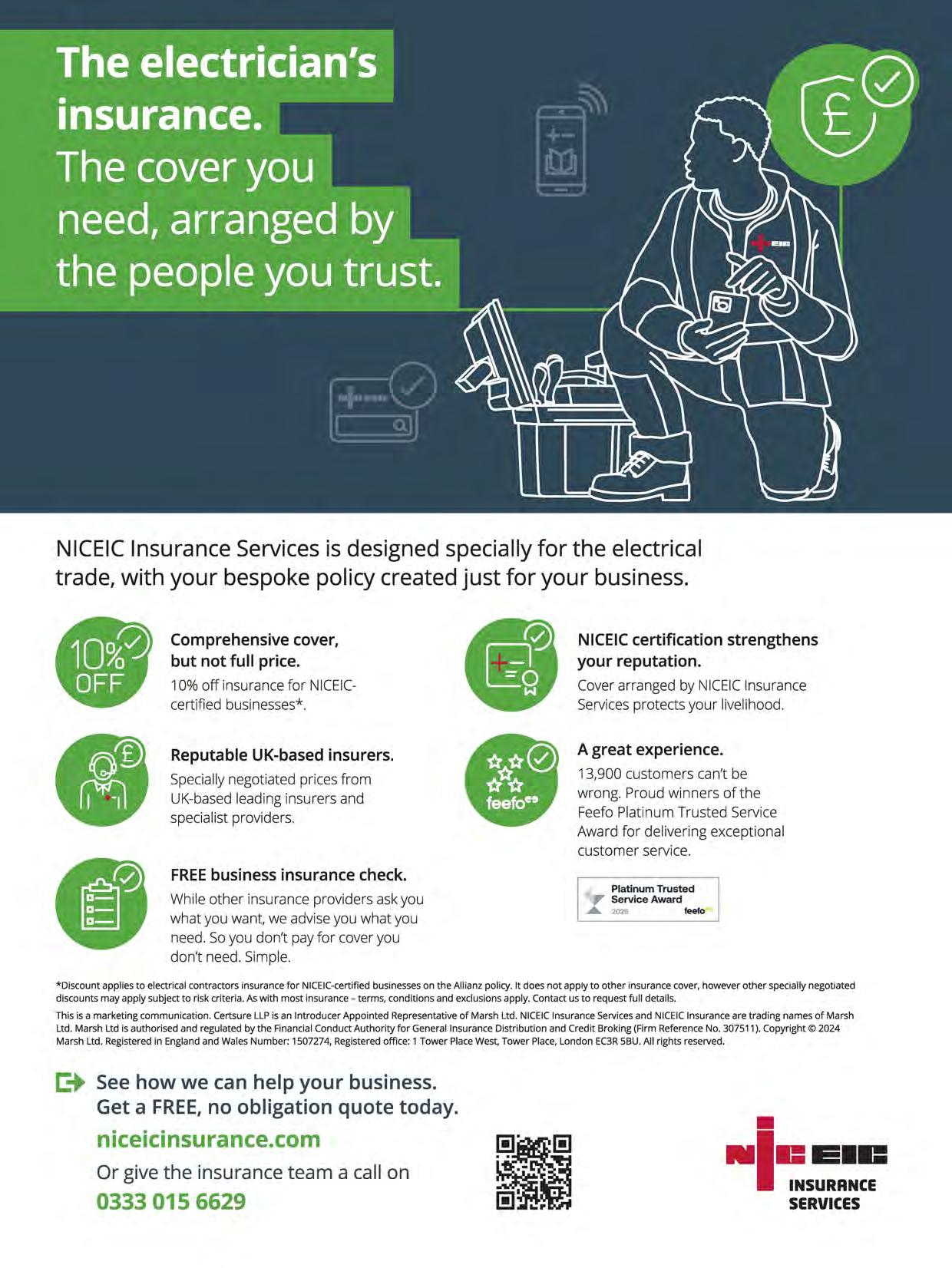
NICEICcertificationstrengthens yourreputation.
Cover arranged by NICEICInsurance Services protects your livelihood.
Agreatexperience.
13,900 customers can't be wrong. Proud winners of the Feefo Platinum Trusted Service Award for delivering exceptional customer service . PlatinumTrusted
Fig 2 Thermalmagnetic device
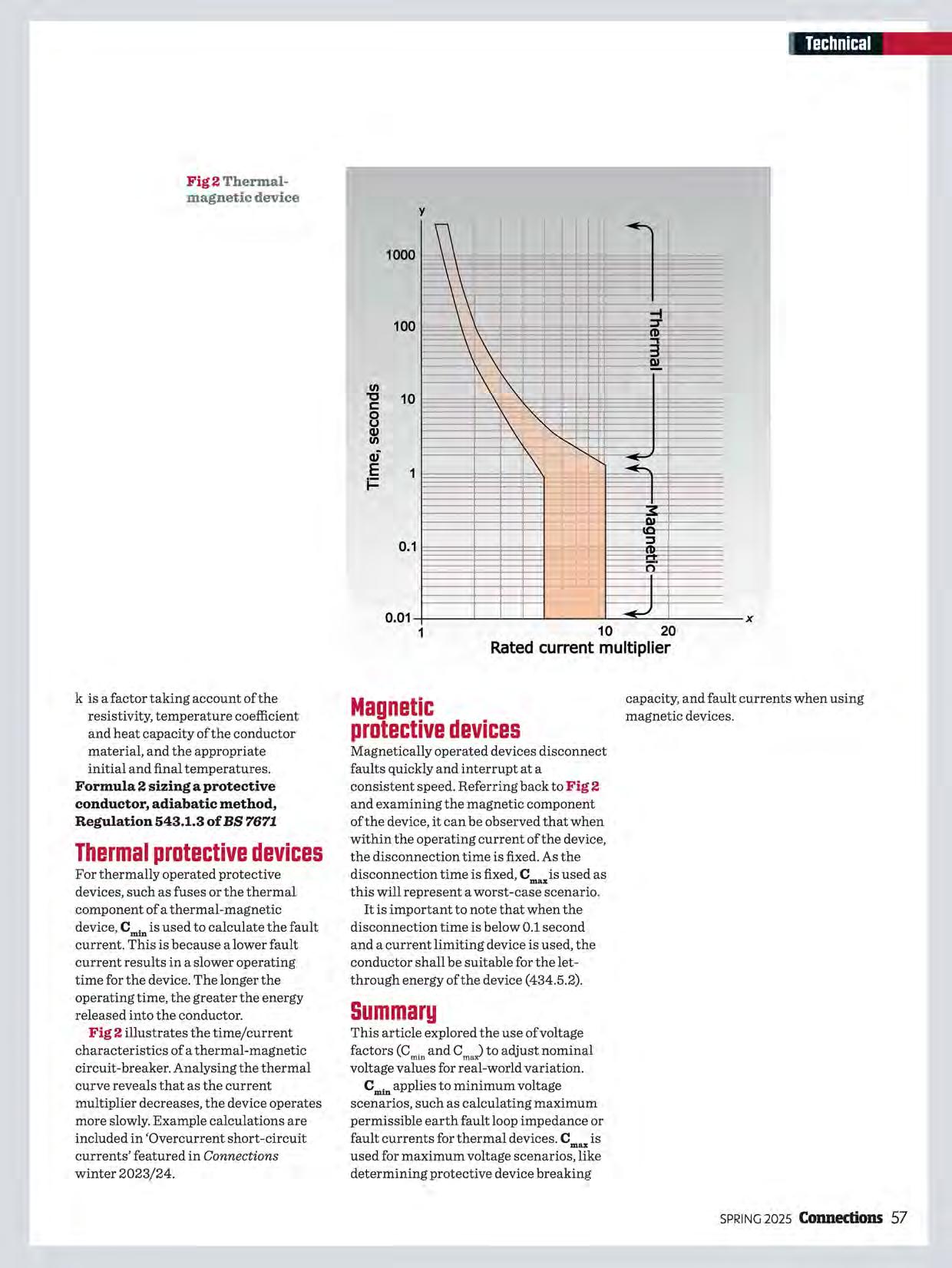
k is a factor taking account of the resistivity, temperature coefficient and heat capacity of the conductor material, and the appropriate initial and final temperatures. Formula 2 sizing a protective conductor, adiabatic method, Regulation 543.1.3 of BS 7671
For thermally operated protective devices, such as fuses or the thermal component of a thermal-magnetic device, Cmin is used to calculate the fault current. This is because a lower fault current results in a slower operating time for the device. The longer the operating time, the greater the energy released into the conductor.
Fig 2 illustrates the time/current characteristics of a thermal-magnetic circuit-breaker. Analysing the thermal curve reveals that as the current multiplier decreases, the device operates more slowly. Example calculations are included in 'Overcurrent short-circuit currents' featured in Connections winter 2023/24.
Ratedcurrentmultiplier
Magnetically operated devices disconnect faults quickly and interrupt at a consistent speed. Referring back to Fig 2 and examining the magnetic component of the device, it can be observed that when within the operating current of the device, the disconnection time is fixed. As the disconnection time is fixed, Cmaxisused as this will represent a worst-case scenario. It is important to note that when the disconnection time is below 0.1 second and a current limiting device is used, the conductor shall be suitable for the letthrough energy of the device (434.5.2).
This article explored the use of voltage factors (Cmin and Cma,) to adjust nominal voltage values for real-world variation. Cmin applies to minimum voltage scenarios, such as calculating maximum permissible earth fault loop impedance or fault currents for thermal devices. Cm.,.is used for maximum voltage scenarios, like determining protective device breaking
capacity, and fault currents when using magnetic devices.
Objective:This article aims to clarify the difference between the various terms used to describe the current-carrying capacity of conductors and to demonstrate how they are used to determine a suitable cross-sectional area (csa) of conductor, taking account of any relevant correction factors.
When selecting a suitable cable for the circuit's current, two methods can be used. The first involves selecting a cable and then applying any applicable correction factors to its tabulated current-carrying capacity (I,). This will typically require several attempts to arrive at a satisfactory solution and is not recommended. The second, and arguably more effective, method involves applying the correction factors to the rated current or current setting of the protective device (In) and then selecting a cable that can carry the current value obtained from this calculation.
Determining a suitable csa for a conductor involves more than just considering the current; factors such as the impedance and voltage drop of the circuit are also important. However, this article simplifies the design process to focus solely on current-carrying capacity.
Every circuit shall be designed to ensure there is sufficient protection from overload. Other than when a fixed load is used, this is generally achieved by using a suitable overcurrent protective device.
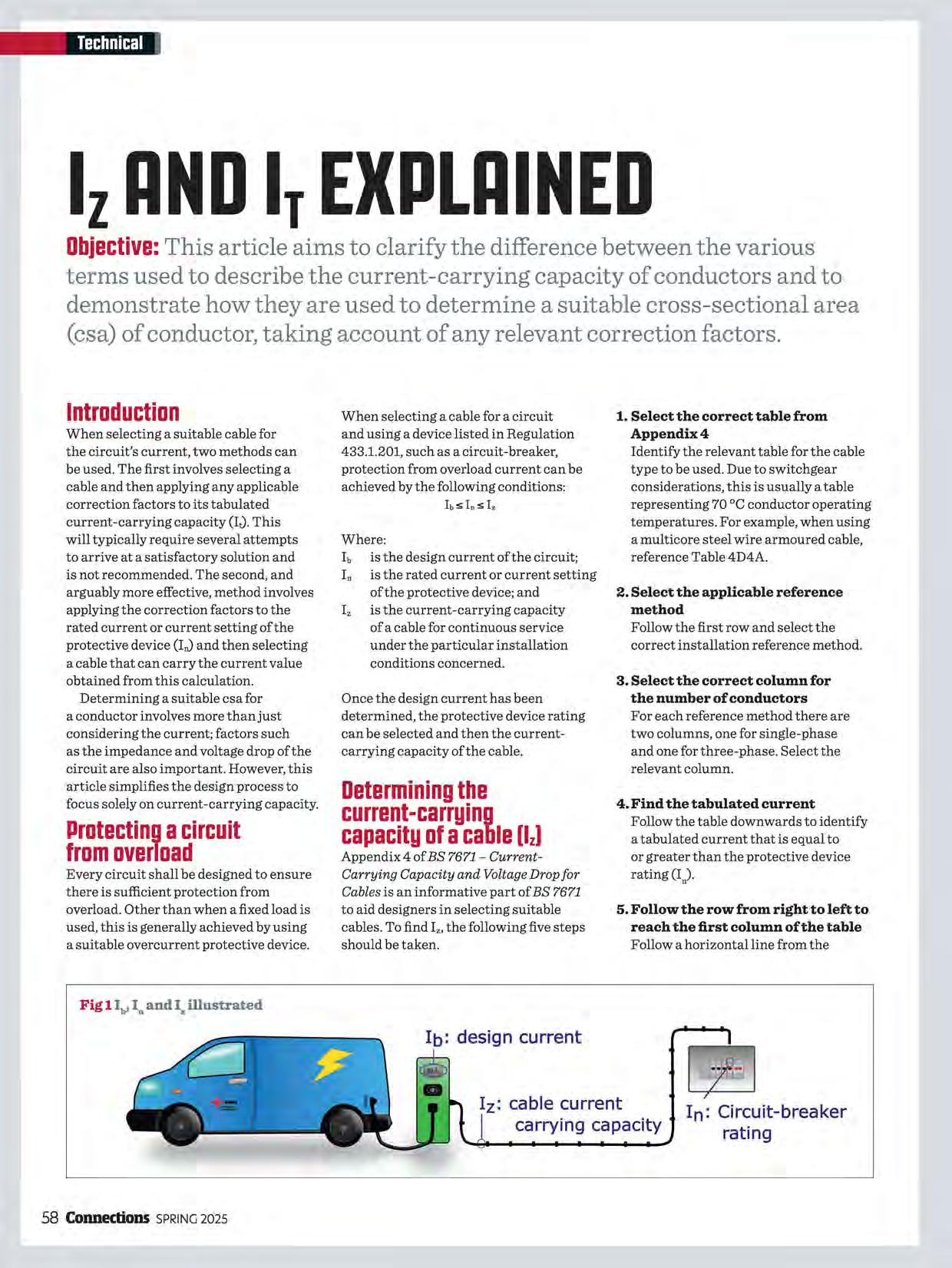
When selecting a cable for a circuit and using a device listed in Regulation 433.1.201, such as a circuit-breaker, protection from overload current can be achieved by the following conditions: hsinsI,
Where:
h is the design current of the circuit; In is the rated current or current setting of the protective device; and Iz is the current-carrying capacity of a cable for continuous service under the particular installation conditions concerned.
Once the design current has been determined, the protective device rating can be selected and then the currentcarrying capacity of the cable.
Appendix 4 of BS 7671 - CurrentCarrying Capacity and Voltage Drop for Cables is an informative part of BS 7671 to aid designers in selecting suitable cables. To find I,, the following five steps should be taken.
1. Select the correct table from Appendix4
Identify the relevant table for the cable type to be used. Due to switchgear considerations, this is usually a table representing 70 °C conductor operating temperatures. For example, when using a multicore steel wire armoured cable, reference Table 4D4A.
2. Select the applicable reference method
Follow the first row and select the correct installation reference method.
3. Select the correct column for the number of conductors
For each reference method there are two columns, one for single-phase and one for three-phase. Select the relevant column.
4. Find the tabulated current
Follow the table downwards to identify a tabulated current that is equal to or greater than the protective device rating(IJ
5. Follow the row from right to left to reach the first column of the table
Follow a horizontal line from the
30A

tabulated current to the first column; the first column represents the csa of the cable.
Using the five step process above, a cable is selected based on its tabulated current rating (I). To find the Iz of this cable, the relevant correction factors are to be applied to I, as shown in formula 1.
Iz = I, X CgXCa X C, XCd XC, X Cr XCc
Where:
Iz is the current-carrying capacity of a cable for continuous service under the particular installation conditions concerned;
I, is the tabulated current-carrying capacity of a cable;
Cg is rating factor for grouping;
C. is rating factor for ambient temperature;
Cs is rating factor for thermal resistivity of soil;
Cd is rating factor for depth of burial;
Ci is rating factor for conductors embedded in thermal insulation;
Cr is rating factor for semi-enclosed fuse to BS 3036; and
Cc is rating factor for circuits buried in the ground.
Formulal
Using the 'Iz method' detailed in this section involves trial and error, as the
current-carrying capacity of the cable can be greatly reduced depending on the correction factors applied. If the value falls below the protective device's rating (I), a larger csa cable is selected and the calculation is carried out again. Only when Iz is greater than In is the cable suitably provided with protection from overload.
A steel wire armoured cable (Table 4D4A) serving a single-phase 30 A load is grouped with another circuit and runs through a plant room with an ambient temperature of 40 °C. The cable is clipped direct, and the circuit protective device is suitably selected and rated at 32 A. Using the five steps described previously, a cable with a 4.0 mm 2 conductor is first selected as it has a tabulated current-carrying capacity of38 A. Using Formula 2 with only the relevant correction factors applied, I, is calculated in Equation 1.
Iz = I, X CgX Ca XC, X Cd XC, X Cr XCc
Where:
Cg= 0.87 40 °C ambient temperature. 70 °C thermoplastic insulation (Appendix 4. Table 4Bl); and C. = 0.85 two circuits. Single layer on a wall (Appendix 4. Table 4Cl) Iz = I, X CgX Ca
Iz = 38A X 0.85 X0.87 L= 28A
Equationl
This cable size would not be suitable as Iz < In, therefore the calculation would need to be repeated with the cable having the next largest csa. This method can require several iterations to determine a suitably sized conductor. In the case of this example, the next larger csa conductor is 6 mm 2 (I,, 49 A). If the calculation is repeated for this cable, the Iz is 36 A, which would be suitable.
There is a quicker method to determine a suitably sized conductor, which removes the trial-and-error process described previously. Instead of applying the correction factors to a selected cable, this method involves dividing the current rating of the protective device by the applicable correction factors. The resulting value is then used to find a tabulated value that is equal to or greater than it. This is shown in Formula 3.
Formula3

I Step 1 1---------~ TABLE4D4A-Multicorearmoured70•cthermoplasticinsulatedcables (COPPERCONDUCTORS)
Step 2
CURRENT-CARRYINGCAPACITY (amperes): I I
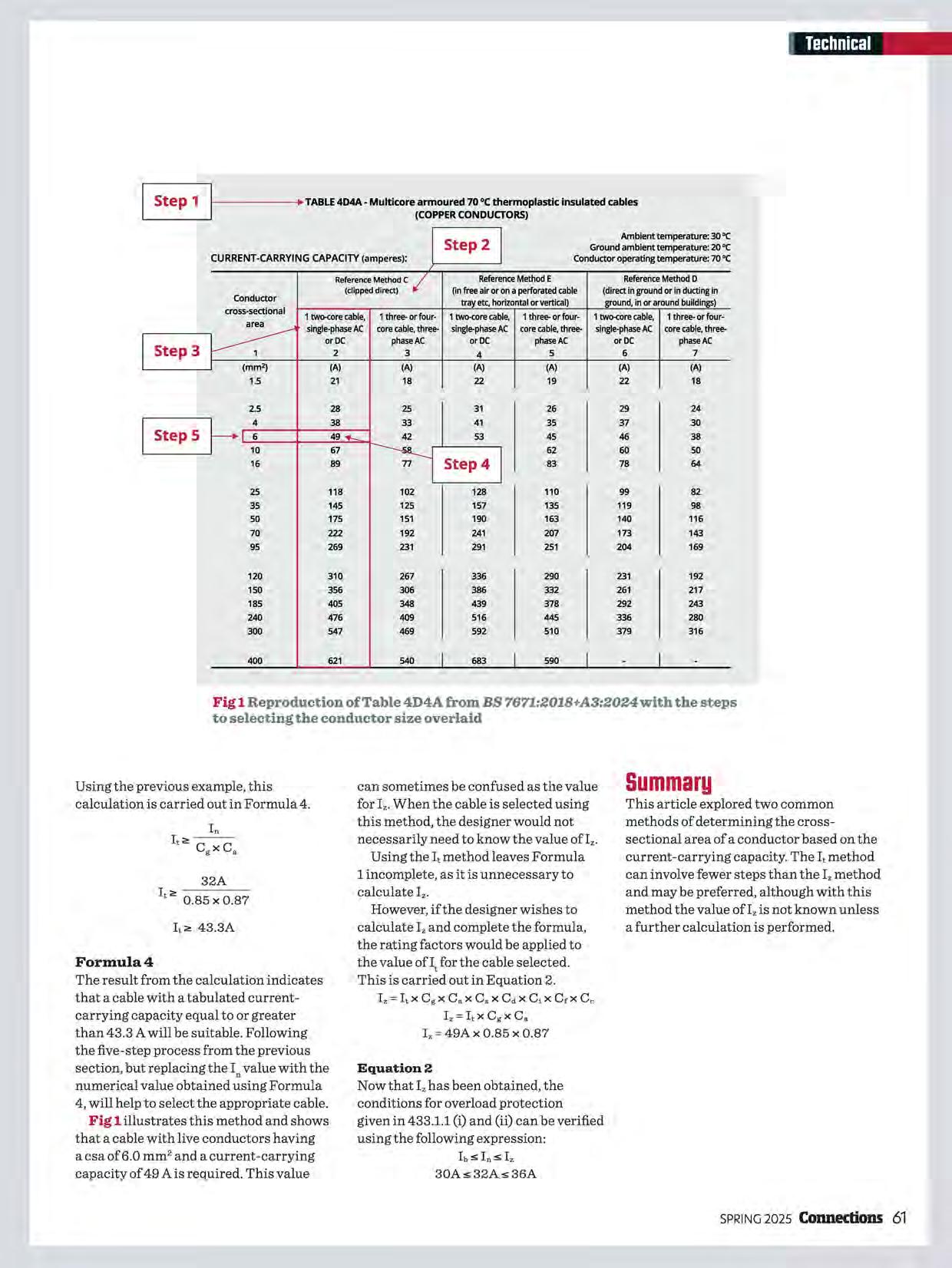
Ambienttemperature:30°C
Groundambienttemperature:20°C
Conductoroperatingtemperature:70°C
ReferenceReferenceMethodEReferenceMethodD MethodC / Conductor (clippeddirect)(infreeairoronaperforatedcable(directingroundorinductingin trayetc,horizontalorvertical)ground,inoraroundbuildings) cross-sectional1two-corecable,1three-orfour-1two-corecable,1three-orfour-1two-corecable,1three-orfoursingle-phaseACcorecable,three- single-phaseAC corecable,three- single-phaseAC corecable,three-
I or DC phaseAC or
Step 3
Fig 1 Reproduction of Table 4D4A from BS 7671:201B+A3:2024with the steps to selecting the conductor size overlaid
Using the previous example, this calculation is carried out in Formula 4.
I,;,,-C C gX a 32A
I,;,, 0.85 x 0.87
I,;,, 43.3A
The result from the calculation indicates that a cable with a tabulated currentcarrying capacity equal to or greater than 43.3 A will be suitable. Following the five-step process from the previous section, but replacing the In value with the numerical value obtained using Formula 4, will help to select the appropriate cable. Fig 1 illustrates this method and shows that a cable with live conductors having a csa of 6.0 mm 2 and a current-carrying capacity of 49 A is required. This value
can sometimes be confused as the value for Iz. When the cable is selected using this method, the designer would not necessarily need to know the value ofiz.
Using the I, method leaves Formula 1 incomplete, as it is unnecessary to calculate Iz.
However, if the designer wishes to calculate Iz and complete the formula, the rating factors would be applied to the value ofI, for the cable selected. This is carried out in Equation 2.
Iz = I, X Cg X Ca X C, X Cd X C, X Cr X Cc
Iz = I, X Cg X Ca
Iz = 49A X 0.85 X 0.87
Equation2
Now that Iz has been obtained, the conditions for overload protection given in 433.1.1 (i) and (ii) can be verified using the following expression: hslnsL 30A s 32A s 36A
This article explored two common methods of determining the crosssectional area of a conductor based on the current-carrying capacity. The I, method can involve fewer steps than the L method and may be preferred, although with this method the value ofL is not known unless a further calculation is performed.
In the following multiple-choice questions you should choose one of the four options that, in your opinion, is the correct answer. You may find it useful to refer to the technical articles in this issue of Connections and BS 7671. The answers to the questions, accompanied by a briefrationale, can be found at the end of the technical section.
1. When determining the maximum permissible earth fault loop impedance (Zs) for a circuit-breaker, what factor is applied to the nominal line to Earth voltage (U J?
a) 1.10
b) 0.95
c) 0.75
d) 0.80
2. What is the permitted range of mains supply voltage when the stated nominal voltage is 230 V?
a) 216.2 V - 253 V
b) 207 V -253 V
c) 225.6 V - 254.4 V
d) 216 V -264 V
3. When determining the required breaking capacity of a threephase protective device, which voltage factor is used to account for the worst-case conditions when determining the maximum prospective fault current at the point of installation?
a) 0.75
b) 0.80
c) 0.95
d) 1.10
4. Within BS 5839-1:2025, a location where there is no immediate or future danger from fire and smoke or the effects of fire and smoke is described as being a place of?
a) Sanctuary
b) Relative safety
c) Ultimate safety
d) Special fire hazard
5. The omission of which of the following could be recorded on the certification of the fire detection and fire alarm system as an acceptable variation?
a) A zone plan or other suitable diagrammatic representation in premises in which there is more than one zone on any storey where people sleep
b) A facility for transmission of fire alarm signals to an alarm receiving centre in a residential care home
c) Protection to an area of the building for which protection is usually deemed necessary as a result of a properly conducted risk assessment
d) A facility for transmission of fire alarm signals to an alarm receiving centre for supported housing where provision of a Grade A system according to BS 5839-6 is necessary
6. In the context of BS 5839-1, what does the posting of this sign denote?
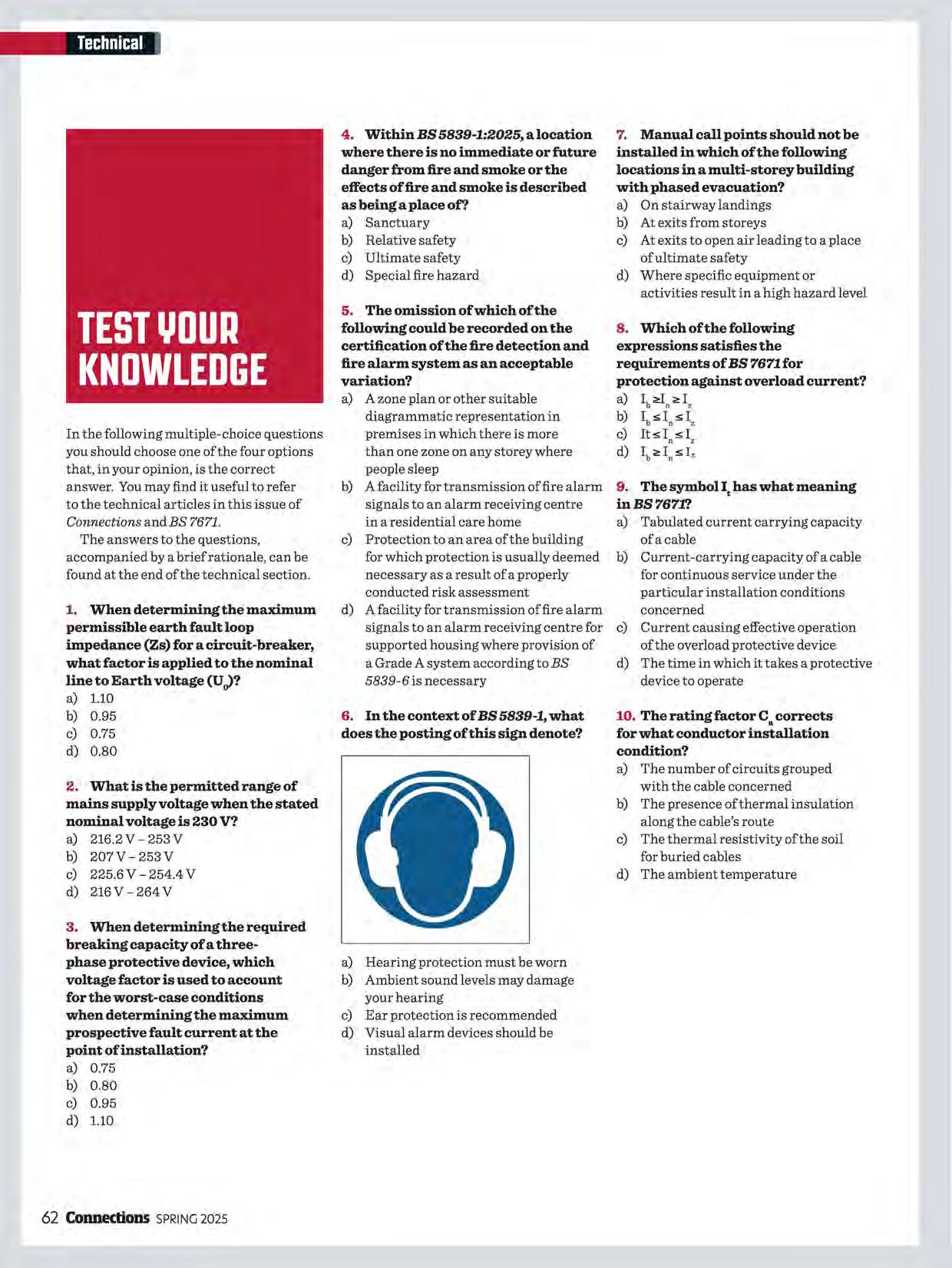
a) Hearing protection must be worn
b) Ambient sound levels may damage your hearing
c) Ear protection is recommended
d) Visual alarm devices should be installed
7. Manual call points should not be installed in which of the following locations in a multi-storey building with phased evacuation?
a) On stairway landings
b) At exits from storeys
c) At exits to open air leading to a place of ultimate safety
d) Where specific equipment or activities result in a high hazard level
8. Which of the following expressions satisfies the requirements of BS 7671 for protection against overload current?
a) lb .e:ln.,,Iz
b) lb S In S Iz
c) Its Ins Iz
d) lb<!:In S lz
9. The symbol I, has what meaning inBS7671?
a) Tabulated current carrying capacity of a cable
b) Current-carrying capacity of a cable for continuous service under the particular installation conditions concerned
c) Current causing effective operation of the overload protective device
d) The time in which it takes a protective device to operate
10. The rating factor Cacorrects for what conductor installation condition?
a) The number of circuits grouped with the cable concerned
b) The presence of thermal insulation along the cable's route
c) The thermal resistivity of the soil for buried cables
d) The ambient temperature
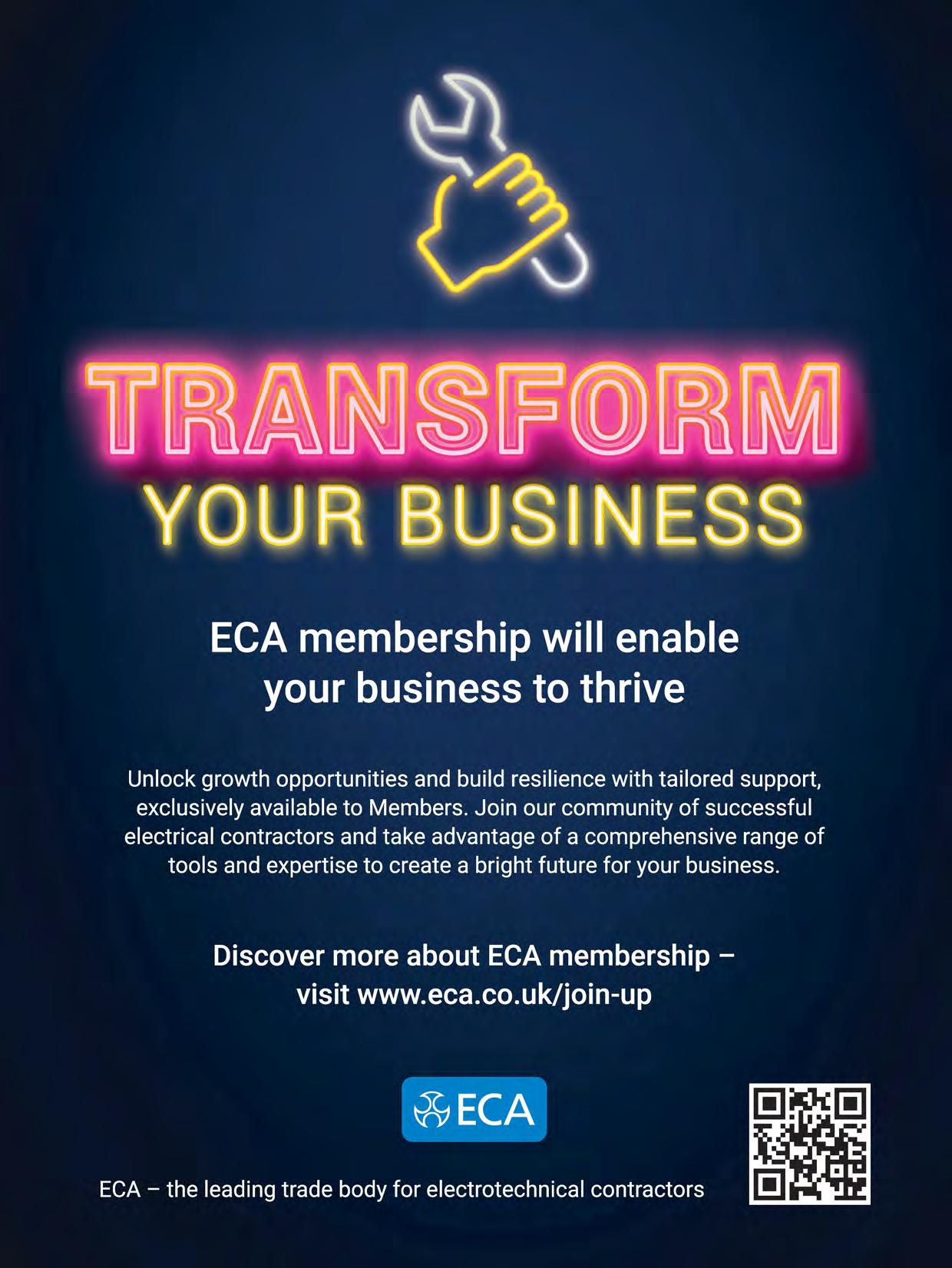
Answers and rationale
Q A Rationale
1. b) 0.95. The value for Cmin• Appendix3
2. a) 216.2 V-253V. +10%/-6%tolerance. Appendix4
3. d) 1.10. The value for Cmax•Section 9.5 of CLC/TR 50480:2011.
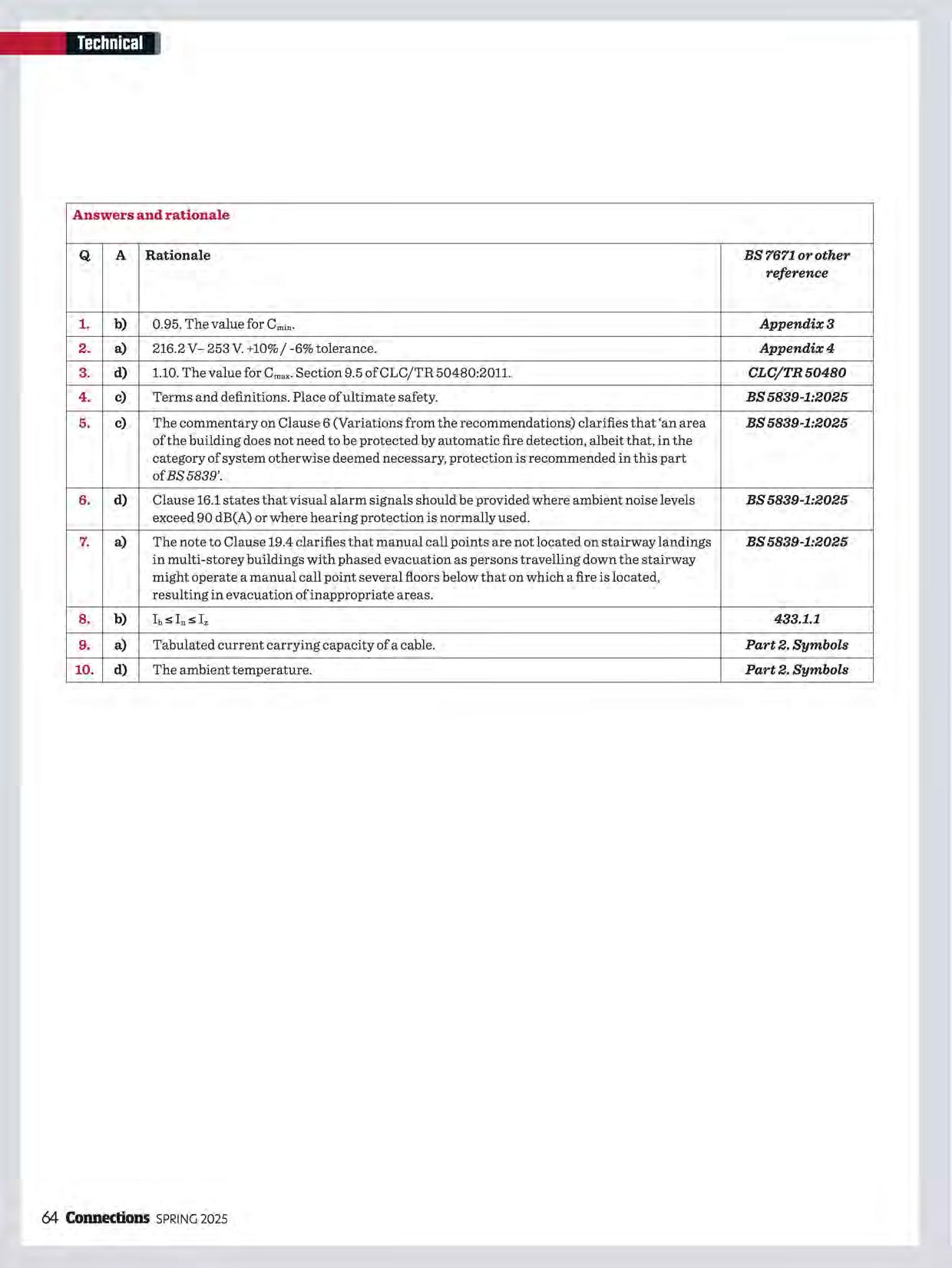
CLC/TR 50480
4. c) Terms and definitions. Place of ultimate safety. BS 5839-1:2025
5. c) The commentary on Clause 6 (Variations from the recommendations) clarifies that 'an area BS 5839-1:2025 of the building does not need to be protected by automatic fire detection, albeit that, in the category of system otherwise deemed necessary, protection is recommended in this part ofBS5839'.
6. d) Clause 16.1 states that visual alarm signals should be provided where ambient noise levels BS 5839-1:2025 exceed 90 dB(A) or where hearing protection is normally used.
7. a) The note to Clause 19.4 clarifies that manual call points are not located on stairway landings BS 5839-1:2025 in multi-storey buildings with phased evacuation as persons travelling down the stairway might operate a manual call point several floors below that on which a fire is located, resulting in evacuation ofinappropriate areas.
8. b) h s Ins Iz
433.1.1
9. a) Tabulated current carrying capacity of a cable. Part 2. Symbols
10. d) The ambient temperature. Part 2. Symbols


Ifyou'rekeentaeatlesssalt,tryslurping yoursoupoffthisbitofcutlery.TheElectric SaltSpoonenhancesthetasteoffoodby passingamildelectriccurrentintoIt.There's apowerswitchanthethickplastichandle andfourintensitylevels.Thebrainchild of Tokyo'sKirinHoldingsCampanyand MeijiUniversity,itpromisestaboast thesaltinessoflaw-sodiumfoods byapproximately1.5times.
Whatdoyougetifyoubringtogether abitoffabric,seasalt,carbonink andaspecialgel?Adevicethat generateselectricity,ofcourse. Natjustanyaidelectricity,but moisture-drivenelectricity.This couldworkfarwearableelectronics, electronicskinsensorsand informationstoragedevices,say researchersatNationalUniversity ofSingapore'sdepartment of materialsscienceandengineering. Theycookedupaclever,moisturedrivenelectricitygenerationdevice, wheretheresearcherscoatawetbit offabricwithcarbonnanaparticles andthenwater-absorbinggel.Made usingseasalt,itcanabsorbmare thansixtimesitsoriginalweight, according ta TheEngineer.
Withsucheasilyavailableraw materialsandlawfabricationcast, thisinventioncouldgointomass production,theresearchersbelieve.
Smart phones, EVs and wind turbines all need rare earth elements. Typically, toxic chemicals extract these elements from mineral ore. That mining process results in chemical waste ending up in groundwater and soil. How about using electric charges to concentrate those elements together? A team from China's Guangzhou Institute ofGeochemistryvisited a rare earth deposit to testtheirtheory. They inserted 176 sheet-like plastic electrodes into individual holes drilled 22 metres into the rock.
Next, they injected ammonium sulphate (AKA inorganic salt) into the ore to dissolve and separate out the rare earth elements as charged ions, as New Scientist explains. "They then activated the electrodes to create an electric field between positively and negatively charged electrodes. That electric field moved the rare earth elements toward the positively charged electrodes, concentrating them together." The elements were then moved to treatment ponds for more purification and separation processes.

